
List of popes
Encyclopedia
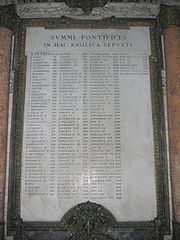
Pope
The Pope is the Bishop of Rome, a position that makes him the leader of the worldwide Catholic Church . In the Catholic Church, the Pope is regarded as the successor of Saint Peter, the Apostle...
(or Bishop of Rome
Diocese of Rome
The Diocese of Rome is a diocese of the Catholic Church in Rome, Italy. The bishop of Rome is the Pope, who is the Supreme Pontiff and leader of the Catholic Church...
) by the Catholic Church. The Annuario Pontificio
Annuario Pontificio
The Annuario Pontificio is the annual directory of the Holy See. It lists all the popes to date and all officials of the Holy See's departments...
, published every year by the Vatican
Roman Curia
The Roman Curia is the administrative apparatus of the Holy See and the central governing body of the entire Catholic Church, together with the Pope...
, contains a list that is generally considered to be the most authoritative. The Annuario Pontificio lists Benedict XVI as the 265th Bishop of Rome. That list is the one given here; it lists 263 men serving 265 pontificates (periods of Papal office), if Pope-elect Stephen
Pope-elect Stephen
Stephen was a priest of Rome elected Pope in March of 752 to succeed Pope Zachary; he died of stroke a few days later, before being ordained a bishop...
is excluded (see below). The difference in these numbers is because Benedict IX reigned during three non-consecutive periods between 1032 and 1048.
The term pope (Latin
Latin
Latin is an Italic language originally spoken in Latium and Ancient Rome. It, along with most European languages, is a descendant of the ancient Proto-Indo-European language. Although it is considered a dead language, a number of scholars and members of the Christian clergy speak it fluently, and...
: papa "father") is used in several Churches to denote their high spiritual leaders (for example Coptic Pope). This title in English usage usually refers to the head of the Roman Catholic Church. The Roman Catholic pope uses various titles by tradition, including Papa
Papa
Papa or PAPA may refer to:*P, in the ICAO spelling alphabet*Papa class submarine*Pāpa, in Hinduism, the Sanskrit word for the concept of sin* Papa is a word used in many languages as an affectionate term for fatherPeople:...
, Summus Pontifex, Pontifex Maximus
Pontifex Maximus
The Pontifex Maximus was the high priest of the College of Pontiffs in ancient Rome. This was the most important position in the ancient Roman religion, open only to patricians until 254 BC, when a plebeian first occupied this post...
, and Servus servorum Dei
Servus Servorum Dei
Servus Servorum Dei is a Latin phrase meaning Servant of the Servants of God. The phrase is one of the titles of the Pope and is used to refer to the Pope in the beginning address of Papal bulls.-History:...
. Each title has been added by unique historical events and unlike other papal prerogatives, is not incapable of modification.
Hermannus Contractus
Hermannus Contractus
Hermann of Reichenau , also called Hermannus Contractus or Hermannus Augiensis or Herman the Cripple, was an 11th century scholar, composer, music theorist, mathematician, and astronomer. He composed the Marian prayer Alma Redemptoris Mater...
may have been the first historian to number the popes continuously. His list ends in 1049 with Pope Leo IX
Pope Leo IX
Pope Saint Leo IX , born Bruno of Eguisheim-Dagsburg, was Pope from February 12, 1049 to his death. He was a German aristocrat and as well as being Pope was a powerful secular ruler of central Italy. He is regarded as a saint by the Roman Catholic Church, with the feast day of April 19...
as number 154. Several changes were made to the list during the 20th century. Antipope Christopher
Antipope Christopher
Christopher held the papacy from October 903 to January 904. Although he was listed as a legitimate Pope in most modern lists of Popes until the first half of the 20th century, the apparently uncanonical method by which he obtained the papacy led to his being removed from the quasi-official roster...
was considered legitimate for a long time. Pope-elect Stephen was considered legitimate under the name Stephen II until the 1961 edition, when his name was erased. Although these changes are no longer controversial, a number of modern lists still include this "first Pope Stephen II". It is probable that this is because they are based on the 1913 edition of the Catholic Encyclopedia
Catholic Encyclopedia
The Catholic Encyclopedia, also referred to as the Old Catholic Encyclopedia and the Original Catholic Encyclopedia, is an English-language encyclopedia published in the United States. The first volume appeared in March 1907 and the last three volumes appeared in 1912, followed by a master index...
, which is in the public domain. In the year 2001 a rigorous study was made by the Catholic Church into the history of the papacy
History of the Papacy
The history of the papacy, the office held by the Pope as head of the Catholic Church, spans from the time of Saint Peter to present day.During the Early Church, the bishops of Rome enjoyed no temporal power until the time of Constantine...
which "prompted almost 200 corrections to the existing biographies of the popes, from St Peter to John Paul II."
1st Century
| Numerical order | Pontificate | Portrait | Name English · Regnal (Latin) |
Personal name | Place of birth | Notes |
|---|---|---|---|---|---|---|
| 1 | 33 – 64/67 |  |
St Peter Saint Peter Saint Peter or Simon Peter was an early Christian leader, who is featured prominently in the New Testament Gospels and the Acts of the Apostles. The son of John or of Jonah and from the village of Bethsaida in the province of Galilee, his brother Andrew was also an apostle... PETRUS |
Simon Peter Shimon Kipha CΙΜΗΟΝ ΚΗΦΑC ܫܶܡܥܽܘܢ ܟ݁ܺܐܦ݂ܳܐ (Simeon Kephas – Simon the Rock) |
Bethsaida Bethsaida Bethsaida is a place mentioned in the New Testament.- Bethsaida Julias :... , Galilea Galilee Galilee , is a large region in northern Israel which overlaps with much of the administrative North District of the country. Traditionally divided into Upper Galilee , Lower Galilee , and Western Galilee , extending from Dan to the north, at the base of Mount Hermon, along Mount Lebanon to the... |
Feast of Saints Peter and Paul
The Feast of Saints Peter and Paul, or the Solemnity of Saints Peter and Paul, is a liturgical feast in honour of the martyrdom in Rome of the apostles Saint Peter and Saint Paul, which is observed on 29 June...
) 29 June, (Chair of Saint Peter
Chair of Saint Peter
The Chair of Saint Peter is a relic conserved in St. Peter's Basilica, enclosed in a gilt bronze casing that was designed by Gian Lorenzo Bernini and executed 1647-53....
) 22 February. Recognized by the Catholic Church as the first Bishop of Rome (Pope) appointed by Christ. Also revered as saint in Eastern Christianity
Eastern Christianity
Eastern Christianity comprises the Christian traditions and churches that developed in the Balkans, Eastern Europe, Asia Minor, the Middle East, Northeastern Africa, India and parts of the Far East over several centuries of religious antiquity. The term is generally used in Western Christianity to...
, with a feast day of 29 June.
|- valign="top"
|2
|64/67(?) – 76/79(?)
|

|St Linus
Pope Linus
Pope Saint Linus was, according to several early sources, Bishop of the diocese of Rome after Saint Peter. This makes Linus the second Pope. According to other early sources Pope Clement I was the Pope after Peter...
LINUS
|Linus
|Tuscia
Tuscany
Tuscany is a region in Italy. It has an area of about 23,000 square kilometres and a population of about 3.75 million inhabitants. The regional capital is Florence ....
(Central Tuscany)
| Feast day 23 September. Also revered as a saint in Eastern Christianity
Eastern Christianity
Eastern Christianity comprises the Christian traditions and churches that developed in the Balkans, Eastern Europe, Asia Minor, the Middle East, Northeastern Africa, India and parts of the Far East over several centuries of religious antiquity. The term is generally used in Western Christianity to...
, with a feast day of 7 June.
|- valign="top"
|3
|76/79(?) – 88/92
|
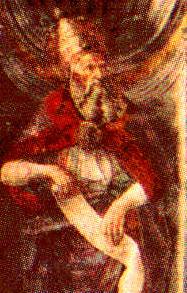
|St Anacletus
Pope Anacletus
Pope Saint Anacletus , also called Pope Cletus, was the third Roman Pope Pope Saint Anacletus (very rarely written as Anencletus), also called Pope Cletus, was the third Roman Pope Pope Saint Anacletus (very rarely written as Anencletus), also called Pope Cletus, was the third Roman Pope (after St....
(Cletus)
ANACLETUS
|Anacletus
|Probably Greece
Greece
Greece , officially the Hellenic Republic , and historically Hellas or the Republic of Greece in English, is a country in southeastern Europe....
|Martyred; feast day 26 April. Once erroneously split into Cletus and Anacletus
|- valign="top"
|4
|88/92 – 97
|
|St Clement I
Pope Clement I
Starting in the 3rd and 4th century, tradition has identified him as the Clement that Paul mentioned in Philippians as a fellow laborer in Christ.While in the mid-19th century it was customary to identify him as a freedman of Titus Flavius Clemens, who was consul with his cousin, the Emperor...
CLEMENS
|Clement
|Rome
Rome
Rome is the capital of Italy and the country's largest and most populated city and comune, with over 2.7 million residents in . The city is located in the central-western portion of the Italian Peninsula, on the Tiber River within the Lazio region of Italy.Rome's history spans two and a half...
|Feast day 23 November. Also revered as a saint in Eastern Christianity
Eastern Christianity
Eastern Christianity comprises the Christian traditions and churches that developed in the Balkans, Eastern Europe, Asia Minor, the Middle East, Northeastern Africa, India and parts of the Far East over several centuries of religious antiquity. The term is generally used in Western Christianity to...
, with a feast day of 25 November.
|- valign="top"
|5
|97/99 – 105/107
|
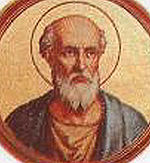
|St Evaristus
Pope Evaristus
Pope Saint Evaristus is accounted the fifth Pope, holding office from c. 99 to 107 AD or from 99 to 108. He was also known as Aristus....
(Aristus)
EVARISTUS
|Aristus
|Bethlehem
Bethlehem
Bethlehem is a Palestinian city in the central West Bank of the Jordan River, near Israel and approximately south of Jerusalem, with a population of about 30,000 people. It is the capital of the Bethlehem Governorate of the Palestinian National Authority and a hub of Palestinian culture and tourism...
, Judea
Judea
Judea or Judæa was the name of the mountainous southern part of the historic Land of Israel from the 8th century BCE to the 2nd century CE, when Roman Judea was renamed Syria Palaestina following the Jewish Bar Kokhba revolt.-Etymology:The...
|Feast day 26 October
|}
2nd Century
| Numerical order | Pontificate | Portrait | Name English · Regnal (Latin) |
Personal name | Place of birth | Notes |
|---|---|---|---|---|---|---|
| 6 | 105/107 – 115/116 |  |
St Alexander I Pope Alexander I Pope Saint Alexander I was Bishop of Rome from about 106 to 115. The Holy See's Annuario Pontificio identifies him as a Roman who reigned from 108 or 109 to 116 or 119... ALEXANDER |
Alexander | Rome | Also revered as a saint in Eastern Christianity Eastern Christianity Eastern Christianity comprises the Christian traditions and churches that developed in the Balkans, Eastern Europe, Asia Minor, the Middle East, Northeastern Africa, India and parts of the Far East over several centuries of religious antiquity. The term is generally used in Western Christianity to... , with a feast day of 16 March. |
| 7 | 115/116 – 125 | 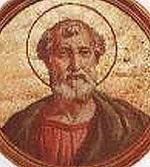 |
St Sixtus I Pope Sixtus I Pope Saint Sixtus I was bishop of Rome from about 117 or 119 to 126 or 128 C.E., succeeding Pope Alexander I and succeeded by Pope Telesphorus. In the oldest documents, Xystus is the spelling used for the first three popes of that name.... XYSTUS |
Rome or Greece | Also revered as a saint in Eastern Christianity Eastern Christianity Eastern Christianity comprises the Christian traditions and churches that developed in the Balkans, Eastern Europe, Asia Minor, the Middle East, Northeastern Africa, India and parts of the Far East over several centuries of religious antiquity. The term is generally used in Western Christianity to... , with a feast day of 10 August. |
|
| 8 | 125 – 136/138 |  |
St Telesphorus Pope Telesphorus Pope Saint Telesphorus was Pope from 126 or 127 to 136 or 137 or 138, during the reigns of Roman Emperors Hadrian and Antoninus Pius. He was Greek by birth.... TELESPHORUS |
Greece | ||
| 9 | 136/138 – 140/142 |  |
St Hyginus Pope Hyginus Pope Saint Hyginus was bishop of Rome from about 136 or 138 to about 140 or 142. Tradition holds that during his papacy he determined the various prerogatives of the clergy and defined the grades of the ecclesiastical hierarchy... HYGINUS |
Greece | Traditionally martyred; feast day 11 January | |
| 10 | 140/142 – 155 | 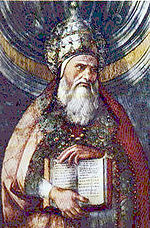 |
St Pius I Pope Pius I Pope Saint Pius I was Bishop of Rome, according to the Annuario Pontificio, from 142 or 146 to 157 or 161, respectively. Others suggest that his pontificate was perhaps from 140 to 154.-Early life:... PIUS |
Aquileia Aquileia Aquileia is an ancient Roman city in what is now Italy, at the head of the Adriatic at the edge of the lagoons, about 10 km from the sea, on the river Natiso , the course of which has changed somewhat since Roman times... , Friuli, Italy |
Martyred by sword; feast day 11 July | |
| 11 | 155 – 166 | 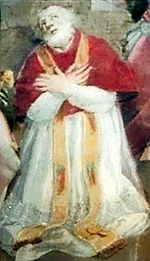 |
St Anicetus Pope Anicetus Pope Saint Anicetus was Pope of the Catholic Church from about 150 to about 167 . His name is Greek for unconquered... ANICETUS |
Emesa Homs Homs , previously known as Emesa , is a city in western Syria and the capital of the Homs Governorate. It is above sea level and is located north of Damascus... , Syria |
Traditionally martyred; feast day 17 April | |
| 12 | c.166 – 174/175 |  |
St Soter Pope Soter Pope Saint Soter was the Bishop of Rome during the latter half of the 2nd Century with his pontificate, according to the Annuario Pontificio, beginning between 162 and 168 then ending between 170 and 177. Although his name is derived from the Greek word "σωτήρ" , meaning a "saviour" or... SOTERIUS |
Fondi Fondi Fondi is a city and comune in the province of Latina, Lazio, central Italy, halfway between Rome and Naples. Before the construction of the highway between the latter cities in the late 1950s, Fondi had been an important settlement on the Roman Via Appia, which was the main connection from Rome to... , Latium, Italy |
Traditionally martyred; feast day 22 April | |
| 13 | 174/175 – 189 | 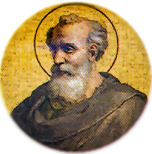 |
St Eleuterus Pope Eleuterus Pope Saint Eleuterus, or Eleutherius, was Bishop of Rome from about 174 to 189 . He was born in Nicopolis in Epirus. His name is Greek for free.... ELEUTHERIUS |
Nicopoli Nicopolis Nicopolis — or Actia Nicopolis — was an ancient city of Epirus, founded 31 BC by Octavian in memory of his victory over Antony and Cleopatra at Actium the previous year. It was later the capital of Epirus Vetus... , Epyrus |
Traditionally martyred; feast day 6 May | |
| 14 | 189 – 198/199 |  |
St Victor I Pope Victor I Pope Saint Victor I was Pope from 189 to 199 .Pope Victor I was the first bishop of Rome born in the Roman Province of Africa: probably he was born in Leptis Magna . He was later canonized... VICTOR |
Northern Africa North Africa North Africa or Northern Africa is the northernmost region of the African continent, linked by the Sahara to Sub-Saharan Africa. Geopolitically, the United Nations definition of Northern Africa includes eight countries or territories; Algeria, Egypt, Libya, Morocco, South Sudan, Sudan, Tunisia, and... |
||
| 15 | 199 – 217 | 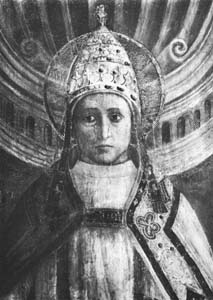 |
St Zephyrinus Pope Zephyrinus Pope Saint Zephyrinus, born in Rome, was bishop of Rome from 199 to 217. His predecessor was bishop Victor I. Upon his death on December 20, 217, he was succeeded by his principal advisor, bishop Callixtus I.-Papacy:... (Zephyrin) ZEPHYRINUS |
Rome |
3rd Century
| Numerical order | Pontificate | Portrait | Name English · Regnal (Latin) |
Personal name | Place of birth | Notes |
|---|---|---|---|---|---|---|
| 16 | c.217 – 222/223 | 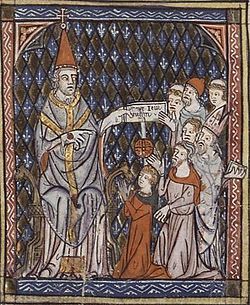 |
St Callixtus I Pope Callixtus I Pope Saint Callixtus I or Callistus I was pope from about 217 to about 222, during the reigns of the Roman Emperors Elagabalus and Alexander Severus... CALLISTUS |
Spain | Martyred; feast day 14 October | |
| 17 | 222/223 – 230 | 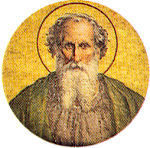 |
St Urban I Pope Urban I Pope Saint Urban I was Pope from 14 October 222 to 230. He was born in Rome, Roman Empire and succeeded St. Callixtus I who had been martyred. For centuries it was believed that Urban too was martyred... URBANUS |
Rome | Also revered as a saint in Eastern Christianity Eastern Christianity Eastern Christianity comprises the Christian traditions and churches that developed in the Balkans, Eastern Europe, Asia Minor, the Middle East, Northeastern Africa, India and parts of the Far East over several centuries of religious antiquity. The term is generally used in Western Christianity to... , with a feast day of 25 May. |
|
| 18 | 21 July 230 – 28 September 235 (5 years) |
 |
St Pontian Pope Pontian Pope Pontian or Pontianus was Pope from 21 July 230 to 29 September 235.A little more is known of Pontian than his predecessors, apparently from a lost papal chronicle that was available to the compiler of the Liberian Catalogue of bishops of Rome, made in the fourth century.During his pontificate... PONTIANUS |
Rome | First pope with firm dates of office | |
| 19 | 21 November 235 – 3 January 236 (44 days) |
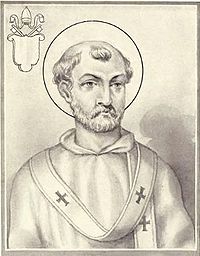 |
St Anterus Pope Anterus Pope Saint Anterus was Pope from November 21, 235 to January 3, 236, and succeeded Pope Pontian, who had been deported from Rome along with the antipope Hippolytus to Sardinia.... ANTERUS |
Greece | Also revered as a saint in Eastern Christianity Eastern Christianity Eastern Christianity comprises the Christian traditions and churches that developed in the Balkans, Eastern Europe, Asia Minor, the Middle East, Northeastern Africa, India and parts of the Far East over several centuries of religious antiquity. The term is generally used in Western Christianity to... , with a feast day of 5 August. |
|
| 20 | 10 January 236 – 20 January 250 (14 years) |
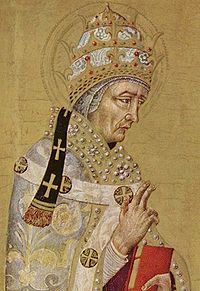 |
St Fabian Pope Fabian Pope Fabian was Pope from January 10, 236 to January 20, 250, succeeding Pope Anterus.Eusebius of Caesarea relates how the Christians, having assembled in Rome to elect a new bishop, saw a dove alight upon the head of Fabian, a layman and stranger to the city, who was thus marked out for this... FABIANUS |
Rome | Feast day 20 January. Also revered as a saint in Eastern Christianity Eastern Christianity Eastern Christianity comprises the Christian traditions and churches that developed in the Balkans, Eastern Europe, Asia Minor, the Middle East, Northeastern Africa, India and parts of the Far East over several centuries of religious antiquity. The term is generally used in Western Christianity to... , with a feast day of 5 August. |
|
| 21 | 6/11 March 251 – June 253 (2 years) |
 |
St Cornelius Pope Cornelius Pope Saint Cornelius was pope from his election on 6 or 13 March 251 to his martyrdom in June 253.- Christian persecution :Emperor Decius, who ruled from 249 to 251 AD, persecuted Christians in the Roman Empire rather sporadically and locally, but starting January in the year 250, he ordered all... CORNELIUS |
Died a martyr, through extreme hardship; feast day 16 September | ||
| 22 | 25 June 253 – 5 March 254 (256 days) |
 |
St Lucius I Pope Lucius I Pope Saint Lucius I was Pope from June 25, 253 to March 5, 254.St. Lucius was born in Rome at an unknown date; nothing is known about his family except his father's name, Porphyrianus. He was elected probably on June 25, 253, and died on March 5, 254... LUCIUS |
Rome | Feast day 4 March | |
| 23 | 12 May 254 – 2 August 257 (3 years) |
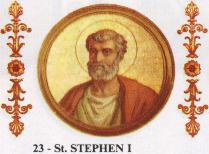 |
St Stephen I Pope Stephen I Pope Saint Stephen I served as Bishop of Rome from 12 May 254 to 2 August 257.Of Roman birth but of Greek ancestry, he became bishop of Rome in 254, having served as archdeacon of Pope Lucius I, who appointed Stephen his successor.... STEPHANUS |
Rome | Martyred by beheading; feast day 2 August. Also revered as a saint in Eastern Christianity Eastern Christianity Eastern Christianity comprises the Christian traditions and churches that developed in the Balkans, Eastern Europe, Asia Minor, the Middle East, Northeastern Africa, India and parts of the Far East over several centuries of religious antiquity. The term is generally used in Western Christianity to... , with the same feast day. |
|
| 24 | 30/31 August 257 – 6 August 258 (340/341 days) |
St Sixtus II Pope Sixtus II Pope Sixtus II or Pope Saint Sixtus II was Pope from August 30, 257 to August 6, 258. He died as a martyr during the persecution by Emperor Valerian.... XYSTUS Secundus |
Greece | Martyred by beheading. Also revered as a saint in Eastern Christianity Eastern Christianity Eastern Christianity comprises the Christian traditions and churches that developed in the Balkans, Eastern Europe, Asia Minor, the Middle East, Northeastern Africa, India and parts of the Far East over several centuries of religious antiquity. The term is generally used in Western Christianity to... , with a feast day of 10 August. |
||
| 25 | 22 July 259 – 26 December 268 (9 years) |
 |
St Dionysius DIONYSIUS |
Greece | Feast day 26 December | |
| 26 | 5 January 269 – 30 December 274 (5 years) |
 |
St Felix I Pope Felix I -Life and works:A Roman by birth, Felix was chosen as Pope on 5 January 269, in succession to Pope Dionysius, who had died on 26 December 268Felix was the author of an important dogmatic letter on the unity of Christ's Person... FELIX |
Rome | ||
| 27 | 4 January 275 – 7 December 283 (8 years) |
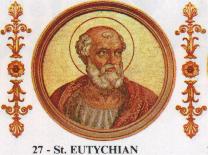 |
St Eutychian Pope Eutychian Pope Saint Eutychian or Eutychianus was pope from January 4, 275 to December 7, 283 .... EUTYCHIANUS |
|||
| 28 | 17 December 283 – 22 April 296 (12 years) |
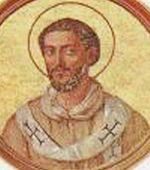 |
St Caius Pope Caius Pope Saint Caius or Gaius was Pope from December 17, 283 to April 22, 296. Christian tradition makes him a native of the Dalmatian city of Salona, today Solin near Split, the son of a man also named Caius, and a member of a noble family related to the Emperor Diocletian.Little information on Caius... CAIUS |
Martyred (according to legend) Feast day 22 April. Also revered as a saint in Eastern Christianity Eastern Christianity Eastern Christianity comprises the Christian traditions and churches that developed in the Balkans, Eastern Europe, Asia Minor, the Middle East, Northeastern Africa, India and parts of the Far East over several centuries of religious antiquity. The term is generally used in Western Christianity to... , with a feast day of 11 August. |
||
| 29 | 30 June 296 – 1 April 304 (7 years) |
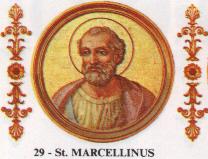 |
St Marcellinus Pope Marcellinus Pope Saint Marcellinus, according to the Liberian Catalogue, became bishop of Rome on June 30, 296; his predecessor was Pope St CaiusMarcellinus’ pontificate began at a time when Diocletian was Roman Emperor, but had not yet started to persecute the Christians. He left Christianity rather free and... MARCELLINUS |
Feast day 26 April. Also revered as a saint in Eastern Christianity Eastern Christianity Eastern Christianity comprises the Christian traditions and churches that developed in the Balkans, Eastern Europe, Asia Minor, the Middle East, Northeastern Africa, India and parts of the Far East over several centuries of religious antiquity. The term is generally used in Western Christianity to... , with a feast day of 7 June. |
4th Century
| Numerical order | Pontificate | Portrait | Name English · Regnal (Latin) |
Personal name | Place of birth | Notes |
|---|---|---|---|---|---|---|
| 30 | 308 – 309 |  |
St Marcellus I Pope Marcellus I Pope Saint Marcellus I, pope from May 308 to 309, succeeded Marcellinus, after a considerable interval, most probably in May or June 308.Under Maxentius he was banished from Rome in 309 on account of the tumult caused by the severity of the penances he had imposed on Christians who had lapsed under... MARCELLUS |
|||
| 31 | c.309 – c.310 | 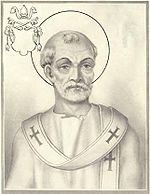 |
St Eusebius Pope Eusebius Pope Saint Eusebius was pope in the year 309 or 310.... EUSEBIUS |
|||
| 32 | 2 July 311 – 10 January 314 (2 years) |
 |
St Miltiades Pope Miltiades Pope Saint Miltiades, also called Melchiades , was pope from 2 July 311 to 10 January 314.- Origins :He appears to have been a Berber African by birth, but of his personal history nothing is known.- Pontificate :... (Melchiades) MILTIADES |
Africa | First pope after the end of the persecution of Christians through the Edict of Milan Edict of Milan The Edict of Milan was a letter signed by emperors Constantine I and Licinius that proclaimed religious toleration in the Roman Empire... (313 AD) issued by Constantine the Great |
|
| 33 | 31 January 314 – 31 December 335 (21 years) |
St Sylvester I SILVESTER |
Sant'Angelo a Scala Sant'Angelo a Scala Sant'Angelo a Scala is a town and comune in the province of Avellino, Campania, Italy.... , Avellino Avellino Avellino is a town and comune, capital of the province of Avellino in the Campania region of southern Italy. It is situated in a plain surrounded by mountains 42 km north-east of Naples and is an important hub on the road from Salerno to Benevento.-History:Before the Roman conquest, the... |
Feast day 31 December. Also revered as a saint in Eastern Christianity Eastern Christianity Eastern Christianity comprises the Christian traditions and churches that developed in the Balkans, Eastern Europe, Asia Minor, the Middle East, Northeastern Africa, India and parts of the Far East over several centuries of religious antiquity. The term is generally used in Western Christianity to... , with a feast day of 2 January. First Council of Nicaea First Council of Nicaea The First Council of Nicaea was a council of Christian bishops convened in Nicaea in Bithynia by the Roman Emperor Constantine I in AD 325... , 325. |
||
| 34 | 18 January 336 – 7 October 336 (263 days) |
.jpg) |
St Mark Pope Mark Pope Saint Mark the apostle or Marcus was Pope from January 18, 336 to October 7, 336, date of his death.Little is known of his early life. According to the Liber Pontificalis, he was a Roman, and his father's name was Priscus... MARCUS |
Rome | Feast day 7 October | |
| 35 | 6 February 337 – 12 April 352 (15 years) |
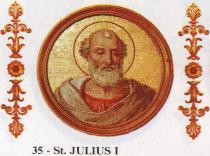 |
St Julius I Pope Julius I Pope Saint Julius I, was pope from February 6, 337 to April 12, 352.He was a native of Rome and was chosen as successor of Mark after the Roman seat had been vacant for four months. He is chiefly known by the part he took in the Arian controversy... IULIUS |
Rome | ||
| 36 | 17 May 352 – 24 September 366 (14 years) |
 |
Liberius Pope Liberius Pope Liberius, pope from May 17, 352, to September 24, 366, was consecrated according to the Catalogus Liberianus on May 22, as the successor of Pope Julius I. He was regarded as a saint in the early Church, but his name was later removed from the Roman Martyrology, however, he is once again... LIBERIUS |
Earliest Pope not yet canonized by the Roman Church. Revered as a saint in Eastern Christianity Eastern Christianity Eastern Christianity comprises the Christian traditions and churches that developed in the Balkans, Eastern Europe, Asia Minor, the Middle East, Northeastern Africa, India and parts of the Far East over several centuries of religious antiquity. The term is generally used in Western Christianity to... , with a feast day of 27 August. |
||
| 37 | 1 October 366 – 11 December 384 (18 years) |
 |
St Damasus I Pope Damasus I Pope Saint Damasus I was the bishop of Rome from 366 to 384.He was born around 305, probably near the city of Idanha-a-Velha , in what is present-day Portugal, then part of the Western Roman Empire... DAMASUS |
Idanha-a-Velha Idanha-a-Velha Idanha-a-Velha is a parish in the east of Portugal, in the municipality of Idanha-a-Nova, and in the district Castelo Branco. It covers an area of 20.98 km² and had a population of 79 as of 2001.-History:... , Portugal |
Patron of Jerome Jerome Saint Jerome was a Roman Christian priest, confessor, theologian and historian, and who became a Doctor of the Church. He was the son of Eusebius, of the city of Stridon, which was on the border of Dalmatia and Pannonia... , commissioned the Vulgate Vulgate The Vulgate is a late 4th-century Latin translation of the Bible. It was largely the work of St. Jerome, who was commissioned by Pope Damasus I in 382 to make a revision of the old Latin translations... translation of the Bible. Council of Rome Council of Rome The Council of Rome was a meeting of Christian Church officials and theologians which took place in 382 under the authority of the bishop of Rome, Damasus I. The previous year, the Emperor Theodosius I had appointed the "dark horse" candidate Nectarius Archbishop of Constantinople... , 382. |
|
| 38 | 11 December 384 – 26 November 399 (14 years) |
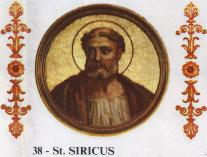 |
St Siricius Pope Siricius Pope Saint Siricius, Bishop of Rome from December 384 until his death on 26 November 399, was successor to Damasus I and was himself succeeded by Anastasius I.... Papa SIRICIUS |
|||
| 39 | 27 November 399 – 19 December 401 (2 years) |
 |
St Anastasius I Pope Anastasius I Pope Saint Anastasius I, born in Rome the son of Maximus, was pope from November 27, 399 to 401.He condemned the writings of the Alexandrian theologian Origen shortly after their translation into Latin. He fought against these writings throughout his papacy and in 400 he called a council to discuss... Papa ANASTASIUS |
5th Century
| Numerical order | Pontificate | Portrait | Name English · Regnal (Latin) |
Personal name | Place of birth | Notes |
|---|---|---|---|---|---|---|
| 40 | 22 December 401 – 12 March 417 (15 years) |
 |
St Innocent I Pope Innocent I -Biography:He was, according to his biographer in the Liber Pontificalis, the son of a man called Innocens of Albano; but according to his contemporary Jerome, his father was Pope Anastasius I , whom he was called by the unanimous voice of the clergy and laity to succeed -Biography:He was,... Papa INNOCENTIUS |
Visigoth Visigoth The Visigoths were one of two main branches of the Goths, the Ostrogoths being the other. These tribes were among the Germans who spread through the late Roman Empire during the Migration Period... Sack of Rome (410) Sack of Rome (410) The Sack of Rome occurred on August 24, 410. The city was attacked by the Visigoths, led by Alaric I. At that time, Rome was no longer the capital of the Western Roman Empire, replaced in this position initially by Mediolanum and then later Ravenna. Nevertheless, the city of Rome retained a... under Alaric Alaric I Alaric I was the King of the Visigoths from 395–410. Alaric is most famous for his sack of Rome in 410, which marked a decisive event in the decline of the Roman Empire.... |
||
| 41 | 18 March 417 – 26 December 418 (1 year) |
 |
St Zosimus Pope Zosimus Pope Saint Zosimus was Pope from March 18, 417 to December 26, 418 .He succeeded Innocent I, and was followed by Boniface I. Zosimus took a decided part in the protracted dispute in Gaul as to the jurisdiction of the see of Arles over that of Vienne, giving energetic decisions in favour of the... Papa ZOSIMUS |
|||
| 42 | 28/29 December 418 – 4 September 422 (3 years) |
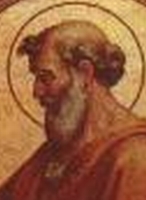 |
St Boniface I Pope Boniface I Pope Saint Boniface I was pope from December 28, 418 to September 4, 422. He was a contemporary of Saint Augustine of Hippo, who dedicated to him some of his works.... Papa BONIFACIUS |
|||
| 43 | 10 September 422 – 27 July 432 (9 years) |
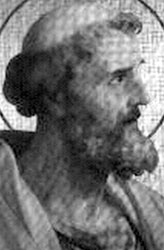 |
St Celestine I Pope Celestine I Pope Saint Celestine I was elevated to the papacy in the year 422, on November 3 according to the Liber Pontificalis, but on April 10 according to Tillemont.... Papa COELESTINUS |
Rome Rome Rome is the capital of Italy and the country's largest and most populated city and comune, with over 2.7 million residents in . The city is located in the central-western portion of the Italian Peninsula, on the Tiber River within the Lazio region of Italy.Rome's history spans two and a half... , Western Roman Empire Western Roman Empire The Western Roman Empire was the western half of the Roman Empire after its division by Diocletian in 285; the other half of the Roman Empire was the Eastern Roman Empire, commonly referred to today as the Byzantine Empire.... |
Also revered as a saint in Eastern Christianity Eastern Christianity Eastern Christianity comprises the Christian traditions and churches that developed in the Balkans, Eastern Europe, Asia Minor, the Middle East, Northeastern Africa, India and parts of the Far East over several centuries of religious antiquity. The term is generally used in Western Christianity to... , with a feast day of 8 April. |
|
| 44 | 31 July 432 – March/August 440 (8 years) |
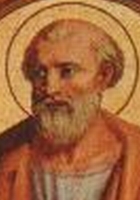 |
St Sixtus III Pope Sixtus III Pope Saint Sixtus III was pope from 31 July 432 to 18 August 440.The name of Sixtus is often connected with a great building boom in Rome: Santa Sabina on the Aventine Hill was dedicated during his pontificate and he built Santa Maria Maggiore, whose dedication to Mary the Mother of God reflected... Papa SIXTUS Tertius |
|||
| 45 | 29 September 440 – 10 November 461 (21 years) |
 |
St Leo I Pope Leo I Pope Leo I was pope from September 29, 440 to his death.He was an Italian aristocrat, and is the first pope of the Catholic Church to have been called "the Great". He is perhaps best known for having met Attila the Hun in 452, persuading him to turn back from his invasion of Italy... (Leo the Great) Papa LEO MAGNUS |
Rome | Convinced Attila the Hun Attila the Hun Attila , more frequently referred to as Attila the Hun, was the ruler of the Huns from 434 until his death in 453. He was leader of the Hunnic Empire, which stretched from the Ural River to the Rhine River and from the Danube River to the Baltic Sea. During his reign he was one of the most feared... to turn back his invasion of Italy. Feast day 10 November. Also revered as a saint in Eastern Christianity Eastern Christianity Eastern Christianity comprises the Christian traditions and churches that developed in the Balkans, Eastern Europe, Asia Minor, the Middle East, Northeastern Africa, India and parts of the Far East over several centuries of religious antiquity. The term is generally used in Western Christianity to... , with a feast day of 18 February. |
|
| 46 | 19 November 461 – 29 February 468 (6 years) |
.jpg) |
St Hilarius Pope Hilarius Pope Saint Hilarius was Pope of the Roman Catholic Church from 461 to February 28, 468. He was canonized as a saint after his death.... Papa HILARIUS |
Sardinia Sardinia Sardinia is the second-largest island in the Mediterranean Sea . It is an autonomous region of Italy, and the nearest land masses are the French island of Corsica, the Italian Peninsula, Sicily, Tunisia and the Spanish Balearic Islands.The name Sardinia is from the pre-Roman noun *sard[],... , Western Roman Empire Western Roman Empire The Western Roman Empire was the western half of the Roman Empire after its division by Diocletian in 285; the other half of the Roman Empire was the Eastern Roman Empire, commonly referred to today as the Byzantine Empire.... |
||
| 47 | 3 March 468 – 10 March 483 (15 years) |
St Simplicius Pope Simplicius Pope Saint Simplicius was Pope from 468 to March 10, 483.He was born in Tivoli, Italy, the son of a citizen named Castinus. Most of what is known of him is derived from the Liber Pontificalis.... Papa SIMPLICIUS |
Tivoli Tivoli, Italy Tivoli , the classical Tibur, is an ancient Italian town in Lazio, about 30 km east-north-east of Rome, at the falls of the Aniene river where it issues from the Sabine hills... , Italy |
|||
| 48 | 13 March 483 – 1 March 492 (8 years) |
 |
St Felix III Pope Felix III Pope Saint Felix III was pope from March 13, 483 to january 3, 492. His repudiation of the Henoticon is considered the beginning of the Acacian schism.-Biography:... (Felix II) Papa FELIX Tertius (Secundus) |
Rome | Sometimes called Felix II | |
| 49 | 1 March 492 – 21 November 496 (4 years) |
 |
St Gelasius I Pope Gelasius I Pope Saint Gelasius I was pope from 492 until his death in 496. He was the third and last bishop of Rome of African origin in the Catholic Church. Gelasius was a prolific writer whose style placed him on the cusp between Late Antiquity and the Early Middle Ages... Papa GELASIUS |
Africa | ||
| 50 | 24 November 496 – 19 November 498 (1 year) |
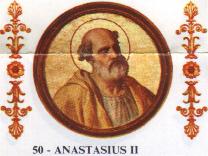 |
Anastasius II Pope Anastasius II Pope Anastasius II was pope from November 24, 496 to November 16, 498.Anastasius II was Pontiff in the time of the schism of Acacius. He showed some tendency towards conciliation, and thus brought upon himself the lively reproaches of the author of the Liber Pontificalis. On the strength of this... Papa ANASTASIUS Secundus |
|||
| 51 | 22 November 498 – 19 July 514 (15 years) |
 |
St Symmachus Pope Symmachus Saint Symmachus was pope from 498 to 514. His tenure was marked by a serious schism over who was legitimately elected pope by the citizens of Rome.... Papa SYMMACHUS |
Sardinia Sardinia Sardinia is the second-largest island in the Mediterranean Sea . It is an autonomous region of Italy, and the nearest land masses are the French island of Corsica, the Italian Peninsula, Sicily, Tunisia and the Spanish Balearic Islands.The name Sardinia is from the pre-Roman noun *sard[],... |
6th Century
| Numerical order | Pontificate | Portrait | Name English · Regnal (Latin) |
Personal name | Place of birth | Notes |
|---|---|---|---|---|---|---|
| 52 | 20 July 514 – 19 July 523 (8 years) |
 |
St Hormisdas Pope Hormisdas Pope Saint Hormisdas was Pope from July 20, 514 to 523. His papacy was dominated by the Acacian schism, started in 484 by Acacius of Constantinople's efforts to placate the Monophysites... Papa HORMISDUS |
Frosinone Frosinone Frosinone is a town and comune in Lazio, central Italy, the administrative seat of the Province of Frosinone. It is located about 75 km south-east of Rome close to the Rome-Naples Autostrada A1... , Southern Latium, Italy |
Father of Pope Silverius | |
| 53 | 13 August 523 – 18 May 526 (2 years) |
 |
St John I Pope John I Pope Saint John I was Pope from 523 to 526. He was a native of Siena or the Castello di Serena, near Chiusdino. He is the first pope known to have visited Constantinople while in office.... Papa IOANNES |
Tuscany Tuscany Tuscany is a region in Italy. It has an area of about 23,000 square kilometres and a population of about 3.75 million inhabitants. The regional capital is Florence .... |
||
| 54 | 13 July 526 – 22 September 530 (4 years) |
St Felix IV Pope Felix IV Pope Saint Felix IV was pope from 526 to 530.He came from Samnium, the son of one Castorius. Following the death of Pope John I at the hands of the Ostrogoth King Theodoric the Great, the papal voters gave in to the king's demands and chose Cardinal Felix as Pope... (Felix III) Papa FELIX Quartus (Tertius) |
Samnium Samnium Samnium is a Latin exonym for a region of south or south and central Italy in Roman times. The name survives in Italian today, but today's territory comprising it is only a small portion of what it once was. The populations of Samnium were called Samnites by the Romans... |
Sometimes called Felix III | ||
| 55 | 22 September 530 – 17 October 532 (2 years) |
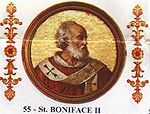 |
Boniface II Pope Boniface II Pope Boniface II was pope from 530 to 532.He was by birth an Ostrogoth, the first Germanic pope, and he owed his appointment to the influence of the Gothic king Athalaric. Boniface was chosen by his predecessor, Pope Felix IV, who had been a strong adherent of the Arian king, and was never elected... Papa BONIFACIUS Secundus |
Rome Rome Rome is the capital of Italy and the country's largest and most populated city and comune, with over 2.7 million residents in . The city is located in the central-western portion of the Italian Peninsula, on the Tiber River within the Lazio region of Italy.Rome's history spans two and a half... to Ostrogoth Ostrogoth The Ostrogoths were a branch of the Goths , a Germanic tribe who developed a vast empire north of the Black Sea in the 3rd century AD and, in the late 5th century, under Theodoric the Great, established a Kingdom in Italy.... parents |
||
| 56 | 2 January 533 – 8 May 535 (2 years) |
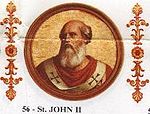 |
John II Pope John II Pope John II was pope from 533 to 535.He was the son of a certain Projectus, born in Rome and a priest of the Basilica di San Clemente on the Caelian Hill. He was made pope January 2, 533. The basilica of St. Clement still retains several memorials of "Johannes surnamed Mercurius"... Papa IOANNES Secundus |
Mercurius | Rome | First pope to not use personal name. This was due to Mercury Mercury (mythology) Mercury was a messenger who wore winged sandals, and a god of trade, the son of Maia Maiestas and Jupiter in Roman mythology. His name is related to the Latin word merx , mercari , and merces... being a Roman god. |
| 57 | 13 May 535 – 22 April 536 (346 days) |
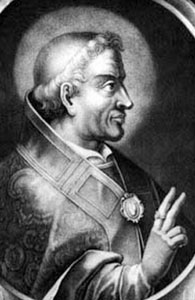 |
St Agapetus I Pope Agapetus I Pope Saint Agapetus I reigned as pope from May 13, 535, to April 22, 536. He is not to be confused with another Saint Agapetus, an Early Christian martyr with the feast day of August 6th.-Family:... (Agapitus) Papa AGAPETUS |
Rome Rome Rome is the capital of Italy and the country's largest and most populated city and comune, with over 2.7 million residents in . The city is located in the central-western portion of the Italian Peninsula, on the Tiber River within the Lazio region of Italy.Rome's history spans two and a half... , Ostrogothic Kingdom Ostrogothic Kingdom The Kingdom established by the Ostrogoths in Italy and neighbouring areas lasted from 493 to 553. In Italy the Ostrogoths replaced Odoacer, the de facto ruler of Italy who had deposed the last emperor of the Western Roman Empire in 476. The Gothic kingdom reached its zenith under the rule of its... |
Feast days 22 April, 20 September. Also revered as a saint in Eastern Christianity Eastern Christianity Eastern Christianity comprises the Christian traditions and churches that developed in the Balkans, Eastern Europe, Asia Minor, the Middle East, Northeastern Africa, India and parts of the Far East over several centuries of religious antiquity. The term is generally used in Western Christianity to... , with a feast day of 17 April. |
|
| 58 | 1 June 536 – 11 November 537 (1 year) |
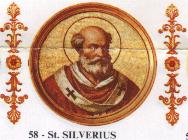 |
St Silverius Pope Silverius Pope Saint Silverius was Pope from June 8, 536 until March 537. According to the "New Catholic Encyclopedia" , the dates of Pope Silverius' pontificate are in doubt: "June 1 or 8, 536, to c. November 11, 537; d. Palmaria, probably December 2, 537."... Papa SILVERIUS |
Exiled; feast day 20 June, son of Pope Hormisdas Pope Hormisdas Pope Saint Hormisdas was Pope from July 20, 514 to 523. His papacy was dominated by the Acacian schism, started in 484 by Acacius of Constantinople's efforts to placate the Monophysites... |
||
| 59 | 29 March 537 – 7 June 555 (18 years) |
 |
Vigilius Pope Vigilius Pope Vigilius reigned as pope from 537 to 555, is considered the first pope of the Byzantine Papacy.-Early life:He belonged to a aristocratic Roman family; his father Johannes is identified as a consul in the Liber pontificalis, having received that title from the emperor... Papa VIGILIUS |
Rome | ||
| 60 | 16 April 556 – 4 March 561 (5 years) |
 |
Pelagius I Pope Pelagius I Pope Pelagius I was Pope from 556 to March 4, 561. He was the second pope of the Byzantine Papacy, like his predecessor a former apocrisiarius to Constantinople.-Early life:He came from a Roman noble family... Papa PELAGIUS |
Rome | ||
| 61 | 17 July 561 – 13 July 574 (12 years) |
 |
John III Pope John III Pope John III was pope from 561 to July 13, 574. He was born in Rome, of a distinguished family. The Liber Pontificalis calls him a son of one Anastasius. His father bore the title of illustris, more than likely being a vir illustris... Papa IOANNES Tertius |
Catelinus | Rome Rome Rome is the capital of Italy and the country's largest and most populated city and comune, with over 2.7 million residents in . The city is located in the central-western portion of the Italian Peninsula, on the Tiber River within the Lazio region of Italy.Rome's history spans two and a half... , Eastern Roman Empire |
|
| 62 | 2 June 575 – 30 July 579 (4 years) |
 |
Benedict I Pope Benedict I Pope Benedict I was pope from June 2, 575 to July 30, 579.Benedict was the son of a man named Bonifacius, and was called Bonosus by the Greeks. The ravages of the Lombards rendered it very difficult to communicate with the Byzantine emperor at Constantinople, who claimed the privilege of confirming... Papa BENEDICTUS |
|||
| 63 | 26 November 579 – 7 February 590 (10 years) |
 |
Pelagius II Pope Pelagius II Pope Pelagius II was Pope from 579 to 590.He was a native of Rome, but probably of Ostrogothic descent, as his father's name was Winigild.Pelagius appealed for help from Emperor Maurice against the Lombards, but the Byzantines were of little help, forcing Pelagius to "buy" a truce and turn to the... Papa PELAGIUS Secundus |
Rome | ||
| 64 | 3 September 590 – 12 March 604 (13 years) |
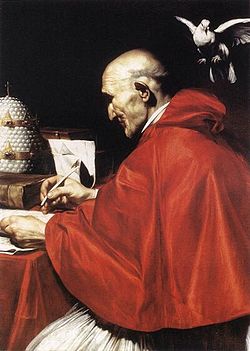 |
St Gregory I Pope Gregory I Pope Gregory I , better known in English as Gregory the Great, was pope from 3 September 590 until his death... , O.S.B. Order of Saint Benedict The Order of Saint Benedict is a Roman Catholic religious order of independent monastic communities that observe the Rule of St. Benedict. Within the order, each individual community maintains its own autonomy, while the organization as a whole exists to represent their mutual interests... (Gregory the Great) Papa GREGORIUS MAGNUS |
Rome | First to formally employ the titles "Servus servorum Dei Servus Servorum Dei Servus Servorum Dei is a Latin phrase meaning Servant of the Servants of God. The phrase is one of the titles of the Pope and is used to refer to the Pope in the beginning address of Papal bulls.-History:... " and "Pontifex Maximus Pontifex Maximus The Pontifex Maximus was the high priest of the College of Pontiffs in ancient Rome. This was the most important position in the ancient Roman religion, open only to patricians until 254 BC, when a plebeian first occupied this post... ". Feast day 3 September. Also revered as a saint in Eastern Christianity Eastern Christianity Eastern Christianity comprises the Christian traditions and churches that developed in the Balkans, Eastern Europe, Asia Minor, the Middle East, Northeastern Africa, India and parts of the Far East over several centuries of religious antiquity. The term is generally used in Western Christianity to... , with a feast day of 12 March. |
7th Century
| Numerical order | Pontificate | Portrait | Name English · Regnal (Latin) |
Personal name | Place of birth | Notes |
|---|---|---|---|---|---|---|
| 65 | 13 September 604 – 22 February 606 (1 year) |
 |
Sabinian Pope Sabinian Pope Sabinian was pope from 604 to 606. He was born at Blera near Viterbo. Pope during the Byzantine Papacy, he was fourth former apocrisiarius to Constantinople elected pope.-Apokrisiariat :... Papa SABINIANUS |
Blera Blera Blera is a small town and comune in the northern Lazio region of Italy near Rome, known during the Middle Ages as Bieda, an evolved form of its ancient name, which was restored in the 20th century... |
||
| 66 | 19 February 607 – 12 November 607 (267 days) |
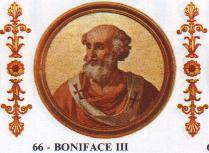 |
Boniface III Pope Boniface III Pope Boniface III was Pope from February 19 to November 12, 607. Despite his relatively short time as Pope he made a significant contribution to the organization of the Catholic Church.-Early life:... Papa BONIFACIUS Tertius |
Rome | ||
| 67 | 25 August 608 – 8 May 615 (6 years) |
St Boniface IV Pope Boniface IV Pope Saint Boniface IV was pope from 608 to his death.Son of Johannes, a physician, a Marsian from the province and town of Valeria; he succeeded Boniface III after a vacancy of over nine months. He was consecrated on either 25 August or September 15 in 608... , O.S.B. Order of Saint Benedict The Order of Saint Benedict is a Roman Catholic religious order of independent monastic communities that observe the Rule of St. Benedict. Within the order, each individual community maintains its own autonomy, while the organization as a whole exists to represent their mutual interests... Papa BONIFACIUS Quartus |
Marsi Marsica Marsica is a geographical area in the Abruzzo, central Italy, including 37 comuni in the province of L'Aquila, the most important of which is Avezzano. It is located between the plain of the former Lake Fucino, the National Park of Abruzzo, Lazio and Molise, the plain of Carsoli and the valley of... |
First Pope to bear the same name as his predecessor. Member of the Order of Saint Benedict Order of Saint Benedict The Order of Saint Benedict is a Roman Catholic religious order of independent monastic communities that observe the Rule of St. Benedict. Within the order, each individual community maintains its own autonomy, while the organization as a whole exists to represent their mutual interests... . |
||
| 68 | 19 October 615 – 8 November 618 (3 years) |
St Adeodatus I Pope Adeodatus I Pope Saint Adeodatus I or Deodatus I was Pope from November 13, 615 to his death.... (Deusdedit) Papa ADEODATUS |
Rome | Sometimes called Deusdedit, and then Pope Adeodatus II Pope Adeodatus II Pope Adeodatus II or Pope Deodatus II reigned as Pope from April 11, 672 to June 17, 676. Little is known about him. Most records which remain indicate that Adeodatus was known for his generosity, especially when it came to the poor and to pilgrims.... is called Pope Adeodatus without a number |
||
| 69 | 23 December 619 – 25 October 625 (5 years) |
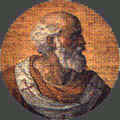 |
Boniface V Pope Boniface V Pope Boniface V was pope from 619 to 625.He was consecrated as pope on December 23, 619. He did much for the Christianising of England and enacted the decree by which churches became places of refuge for criminals.... Papa BONIFACIUS Quintus |
Naples Naples Naples is a city in Southern Italy, situated on the country's west coast by the Gulf of Naples. Lying between two notable volcanic regions, Mount Vesuvius and the Phlegraean Fields, it is the capital of the region of Campania and of the province of Naples... |
||
| 70 | 27 October 625 – 12 October 638 (12 years) |
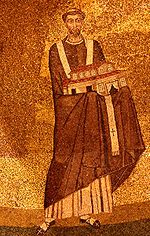 |
Honorius I Pope Honorius I Pope Honorius I was pope from 625 to 638.Honorius, according to the Liber Pontificalis, came from Campania and was the son of the consul Petronius. He became pope on October 27, 625, two days after the death of his predecessor, Boniface V... Papa HONORIUS |
Campania Campania Campania is a region in southern Italy. The region has a population of around 5.8 million people, making it the second-most-populous region of Italy; its total area of 13,590 km² makes it the most densely populated region in the country... , Byzantine Empire Byzantine Empire The Byzantine Empire was the Eastern Roman Empire during the periods of Late Antiquity and the Middle Ages, centred on the capital of Constantinople. Known simply as the Roman Empire or Romania to its inhabitants and neighbours, the Empire was the direct continuation of the Ancient Roman State... |
||
| 71 | October 638 – 2 August 640 (1 year) |
 |
Severinus Pope Severinus Pope Severinus was pope in the year 640 who became caught up in a power struggle with the Byzantine Emperor Heraclius over the ongoing Monothelite controversy.-Election and struggle with Constantinople:... Papa SEVERINUS |
Rome | ||
| 72 | 24 December 640 – 12 October 642 (1 year) |
.jpg) |
John IV Pope John IV Pope John IV was elected Pope of the Catholic Church, after a four-month sede vacante, December 24, 640.Pope John was a native of Dalmatia . He was the son of the scholasticus Venantius. At the time of his election he was archdeacon of the Roman Church, an important role in governing the see... Papa IOANNES Quartus |
Zadar Zadar Zadar is a city in Croatia on the Adriatic Sea. It is the centre of Zadar county and the wider northern Dalmatian region. Population of the city is 75,082 citizens... , Dalmatia Dalmatia Dalmatia is a historical region on the eastern coast of the Adriatic Sea. It stretches from the island of Rab in the northwest to the Bay of Kotor in the southeast. The hinterland, the Dalmatian Zagora, ranges from fifty kilometers in width in the north to just a few kilometers in the south.... , now Croatia Croatia Croatia , officially the Republic of Croatia , is a unitary democratic parliamentary republic in Europe at the crossroads of the Mitteleuropa, the Balkans, and the Mediterranean. Its capital and largest city is Zagreb. The country is divided into 20 counties and the city of Zagreb. Croatia covers ... |
||
| 73 | 24 November 642 – 14 May 649 (6 years) |
 |
Theodore I Pope Theodore I Pope Theodore I , who was pope from November 24, 642, to May 14, 649, is considered a Greek, but was born in Jerusalem. He was made a cardinal deacon, and a full cardinal by Pope John IV.... Papa THEODORUS |
Palestine Palestine Palestine is a conventional name, among others, used to describe the geographic region between the Mediterranean Sea and the Jordan River, and various adjoining lands.... |
||
| 74 | July 649 – 16 September 655 (6 years) |
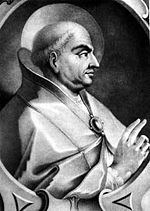 |
St Martin I Pope Martin I Pope Martin I, born near Todi, Umbria in the place now named after him , was pope from 649 to 653, succeeding Pope Theodore I in July 5, 649. The only pope during the Byzantine Papacy whose election was not approved by a iussio from Constantinople, Martin I was abducted by Constans II and died in... Papa MARTINUS |
Near Todi Todi Todi is a town and comune of the province of Perugia in central Italy. It is perched on a tall two-crested hill overlooking the east bank of the river Tiber, commanding distant views in every direction.In the 1990s, Richard S... , Umbria Umbria Umbria is a region of modern central Italy. It is one of the smallest Italian regions and the only peninsular region that is landlocked.Its capital is Perugia.Assisi and Norcia are historical towns associated with St. Francis of Assisi, and St... , Byzantine Empire Byzantine Empire The Byzantine Empire was the Eastern Roman Empire during the periods of Late Antiquity and the Middle Ages, centred on the capital of Constantinople. Known simply as the Roman Empire or Romania to its inhabitants and neighbours, the Empire was the direct continuation of the Ancient Roman State... |
Feast Day 12 November. Also revered as a saint in Eastern Christianity Eastern Christianity Eastern Christianity comprises the Christian traditions and churches that developed in the Balkans, Eastern Europe, Asia Minor, the Middle East, Northeastern Africa, India and parts of the Far East over several centuries of religious antiquity. The term is generally used in Western Christianity to... , with a feast day of 14 April. |
|
| 75 | 10 August 654 – 2 June 657 (2 years) |
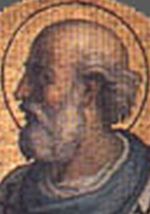 |
St Eugene I Pope Eugene I Pope Saint Eugene I or Eugenius I, was pope from 10 August 654, to 1 June 657.He was a native of Rome, born to one Rufinianus. He was elected pope on 10 August 654, ascended in 655, and died on 1 June 657, of natural causes.-Early life:... Papa EUGENIUS |
Rome | ||
| 76 | 30 July 657 – 27 January 672 (14 years) |
 |
St Vitalian Pope Vitalian Pope Saint Vitalianus was Pope of the Catholic Church from July 30, 657, until January 27, 672.He was born in Segni, Lazio, the son of Anastasius.-Reign:... Papa VITALIANUS |
Segni Segni Segni is an Italian town and comune located in Lazio. The city is situated on a hilltop in the Lepini Mountains, and overlooks the valley of the Sacco River.-Early history:... , Byzantine Empire Byzantine Empire The Byzantine Empire was the Eastern Roman Empire during the periods of Late Antiquity and the Middle Ages, centred on the capital of Constantinople. Known simply as the Roman Empire or Romania to its inhabitants and neighbours, the Empire was the direct continuation of the Ancient Roman State... |
||
| 77 | 11 April 672 – 17 June 676 (4 years) |
 |
Adeodatus II Pope Adeodatus II Pope Adeodatus II or Pope Deodatus II reigned as Pope from April 11, 672 to June 17, 676. Little is known about him. Most records which remain indicate that Adeodatus was known for his generosity, especially when it came to the poor and to pilgrims.... , O.S.B. Order of Saint Benedict The Order of Saint Benedict is a Roman Catholic religious order of independent monastic communities that observe the Rule of St. Benedict. Within the order, each individual community maintains its own autonomy, while the organization as a whole exists to represent their mutual interests... Papa ADEODATUS Secundus |
Rome Rome Rome is the capital of Italy and the country's largest and most populated city and comune, with over 2.7 million residents in . The city is located in the central-western portion of the Italian Peninsula, on the Tiber River within the Lazio region of Italy.Rome's history spans two and a half... , Byzantine Empire Byzantine Empire The Byzantine Empire was the Eastern Roman Empire during the periods of Late Antiquity and the Middle Ages, centred on the capital of Constantinople. Known simply as the Roman Empire or Romania to its inhabitants and neighbours, the Empire was the direct continuation of the Ancient Roman State... |
Sometimes called Pope Adeodatus (without a number) when Pope Adeodatus I Pope Adeodatus I Pope Saint Adeodatus I or Deodatus I was Pope from November 13, 615 to his death.... is called Pope Deusdedit. Member of the Order of Saint Benedict Order of Saint Benedict The Order of Saint Benedict is a Roman Catholic religious order of independent monastic communities that observe the Rule of St. Benedict. Within the order, each individual community maintains its own autonomy, while the organization as a whole exists to represent their mutual interests... . |
|
| 78 | 2 November 676 – 11 April 678 (1 year) |
 |
Donus Pope Donus Pope Donus was Pope from November 2, 676 to April 11, 678.He was the son of a Roman named Mauricius. Not much is known of this pope.-Reign:... Papa DONUS |
Rome, Byzantine Empire | ||
| 79 | 27 June 678 – 10 January 681 (2 years) |
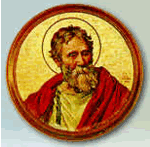 |
St Agatho Pope Agatho -Background and early life:Little is known of Agatho before his papacy. A letter written by St. Gregory the Great to the abbot of St. Hermes in Palermo mentions an Agatho, a Greek born in Sicily to wealthy parents. He wished to give away his inheritance and join a monastery, and in this letter... Papa AGATHO |
Sicily Sicily Sicily is a region of Italy, and is the largest island in the Mediterranean Sea. Along with the surrounding minor islands, it constitutes an autonomous region of Italy, the Regione Autonoma Siciliana Sicily has a rich and unique culture, especially with regard to the arts, music, literature,... |
Also revered as a saint in Eastern Christianity Eastern Christianity Eastern Christianity comprises the Christian traditions and churches that developed in the Balkans, Eastern Europe, Asia Minor, the Middle East, Northeastern Africa, India and parts of the Far East over several centuries of religious antiquity. The term is generally used in Western Christianity to... , with a feast day of 20 February. |
|
| 80 | December 681 – 3 July 683 (1 year) |
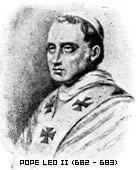 |
St Leo II Pope Leo II -Background and early activity in the Church:He was a Sicilian by birth , and succeeded Agatho. Though elected pope a few days after the death of St. Agatho , he was not consecrated till after the lapse of a year and seven months... Papa LEO Secundus |
Sicily | Feast day 3 July | |
| 81 | 26 June 684 – 8 May 685 (317 days) |
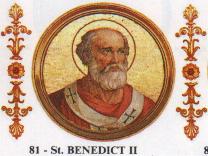 |
St Benedict II Pope Benedict II Pope Saint Benedict II was Pope from 684 to 685.Pope Benedict II died on May 8, 685. He succeeded Leo II. Although chosen in 683, he was not ordained until 684 because the leave of Emperor Constantine IV was not obtained until some months after the election... Papa BENEDICTUS Secundus |
Rome, Byzantine Empire | Feast day 7 May | |
| 82 | 12 July 685 – 2 August 686 (1 year) |
 |
John V Pope John V Pope John V was pope from July 685 to August 2, 686. John V was the first pope of the Byzantine Papacy allowed to be consecrated by the Byzantine emperor without prior consent, and the first in a line of ten consecutive popes of eastern origin... Papa IOANNES Quintus |
Syria Syria Syria , officially the Syrian Arab Republic , is a country in Western Asia, bordering Lebanon and the Mediterranean Sea to the West, Turkey to the north, Iraq to the east, Jordan to the south, and Israel to the southwest.... |
||
| 83 | 21 October 686 – 22 September 687 (335 days) |
 |
Conon Pope Conon Pope Conon was Pope from October 21, 686 until his death in Rome. Conon was buried in the Patriarchal Basilica of St... Papa CONON |
|||
| 84 | 15 December 687 – 8 September 701 (13 years) |
 |
St Sergius I Pope Sergius I Pope Saint Sergius I was pope from 687 to 701. Selected to end a schism between Antipope Paschal and Antipope Theodore, Sergius I ended the last disputed sede vacante of the Byzantine Papacy.... Papa SERGIUS |
Sicily |
8th Century
| Numerical order | Pontificate | Portrait | Name English · Regnal (Latin) |
Personal name | Place of birth | Notes |
|---|---|---|---|---|---|---|
| 85 | 30 October 701 – 11 January 705 (3 years) |
 |
John VI Pope John VI Pope John VI was a Greek pope from Ephesus who reigned during the Byzantine Papacy from October 30, 701 to January 11, 705. His papacy was noted for military and political breakthroughs on the Italian peninsula. He succeeded to the papal chair two months after the death of Pope Sergius I, and his... Papa IOANNES Sextus |
Greece | ||
| 86 | 1 March 705 – 18 October 707 (2 years) |
 |
John VII Pope John VII Pope John VII was pope from 705 to 707. The successor of John VI, he was of Greek ancestry. He is one of the popes of the Byzantine captivity.-Biography:... Papa IOANNES Septimus |
Greece | Second pope to bear the same name as his predecessor | |
| 87 | 15 January 708 – 4 February 708 (21 days) |
 |
Sisinnius Pope Sisinnius Pope Sisinnius was Pope for about three weeks in 708.A Syrian by birth, Sisinnius's father's name was John. The paucity of donations to the papacy during his reign indicate that he was probably not from the aristocracy.Sisinnius was selected as... Papa SISINNIUS |
Syria | ||
| 88 | 25 March 708 – 9 April 715 (7 years) |
 |
Constantine Pope Constantine Pope Constantine was pope from 708 to 715. With the exception of Antipope Constantine, he was the only pope to take such a "quintessentially" Eastern name of an emperor... Papa CONSTANTINUS |
Syria | Last pope to visit Greece Greece Greece , officially the Hellenic Republic , and historically Hellas or the Republic of Greece in English, is a country in southeastern Europe.... until John Paul II in 2001 |
|
| 89 | 19 May 715 – 11 February 731 (15 years) |
St Gregory II Pope Gregory II Pope Saint Gregory II was pope from May 19, 715 to his death on February 11, 731, succeeding Pope Constantine. Having, it is said, bought off the Lombards for thirty pounds of gold, Charles Martel having refused his call for aid, he used the tranquillity thus obtained for vigorous missionary... Papa GREGORIUS Secundus |
Rome, Byzantine Empire | Feast day 11 February | ||
| 90 | 18 March 731 – 28 November 741 (10 years) |
St Gregory III Pope Gregory III Pope Saint Gregory III was pope from 731 to 741. A Syrian by birth, he succeeded Gregory II in March 731. His pontificate, like that of his predecessor, was disturbed by the iconoclastic controversy in the Byzantine Empire, in which he vainly invoked the intervention of Charles Martel.Elected by... Papa GREGORIUS Tertius |
Syria | Third pope to bear the same name as his predecessor | ||
| 91 | 3 December 741 – 14/22 March 752 (10 years) |
 |
St Zachary Pope Zachary Pope Saint Zachary was Pope of the Catholic Church from 741 to 752. A Greek from Calabria, he was the last pope of the Byzantine Papacy... Papa ZACHARIAS |
Greece | Feast day 15 March | |
| (never consecrated) | 23 March 752 – 25 March 752 (Never took office as pope) |
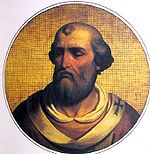 |
Pope-elect Stephen Pope-elect Stephen Stephen was a priest of Rome elected Pope in March of 752 to succeed Pope Zachary; he died of stroke a few days later, before being ordained a bishop... Papa Electus STEPHANUS |
Sometimes known as Stephen II. Died three days after his election having never received episcopal consecration. Some lists still include his name. The Vatican sanctioned his addition to the list of popes in the sixteenth century, however he was removed in 1961. He is no longer considered a pope by the Catholic Church. | ||
| 92 | 26 March 752 – 26 April 757 (5 years) |
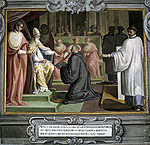 |
Stephen II Pope Stephen II Pope Stephen II was Pope from 752 to 757, succeeding Pope Zachary following the death of Pope-elect Stephen. Stephen II marks the historical delineation between the Byzantine Papacy and the Frankish Papacy.-Allegiance to Constantinople:... (Stephen III) Papa STEPHANUS Secundus (Tertius) |
Sometimes called Stephen III | ||
| 93 | 29 May 757 – 28 June 767 (10 years) |
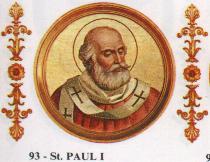 |
St Paul I Pope Paul I Pope Paul I was pope from May 29, 757 to June 28, 767. He first served as a Roman deacon and was frequently employed by his brother, Pope Stephen II, in negotiations with the Lombard kings.... Papa PAULUS |
Rome | ||
| 94 | 1/7 August 767 – 24 January 772 (4 years) |
 |
Stephen III Pope Stephen III Pope Stephen III was pope from August 1 or August 7, 768 to January 24, 772. He was a native of Sicily.He came to Rome during the pontificate of Gregory III and gradually rose to high office in the service of successive popes.... (Stephen IV) Papa STEPHANUS Tertius (Quartus) |
Sicily | Sometimes called Stephen IV | |
| 95 | 1 February 772 – 26 December 795 (23 years) |
Adrian I Pope Adrian I Pope Adrian was pope from February 1, 772 to December 25, 795. He was the son of Theodore, a Roman nobleman.Shortly after Adrian's accession the territory ruled by the papacy was invaded by Desiderius, king of the Lombards, and Adrian was compelled to seek the assistance of the Frankish king... Papa HADRIANUS |
Rome | |||
| 96 | 26 December 795 – 12 June 816 (20 years) |
St Leo III Pope Leo III Pope Saint Leo III was Pope from 795 to his death in 816. Protected by Charlemagne from his enemies in Rome, he subsequently strengthened Charlemagne's position by crowning him as Roman Emperor.... Papa LEO Tertius |
Rome | Crowned Charlemagne Charlemagne Charlemagne was King of the Franks from 768 and Emperor of the Romans from 800 to his death in 814. He expanded the Frankish kingdom into an empire that incorporated much of Western and Central Europe. During his reign, he conquered Italy and was crowned by Pope Leo III on 25 December 800... Imperator Augustus on Christmas Day, 800, thereby initiating what would become the office of Holy Roman Emperor Holy Roman Emperor The Holy Roman Emperor is a term used by historians to denote a medieval ruler who, as German King, had also received the title of "Emperor of the Romans" from the Pope... requiring the imprimatur of the pope for its legitimacy |
9th Century
| Numerical order | Pontificate | Portrait | Name English · Regnal (Latin) |
Personal name | Place of birth | Age at election / death or resigned | # years as pope | Notes |
|---|---|---|---|---|---|---|---|---|
| 97 | 12 June 816 – 24 January 817 | 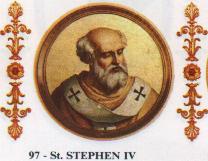 |
Stephen IV Pope Stephen IV Pope Stephen IV was Pope from June 816 to January 817.He succeeded Leo III, whose policies favoring clergy over lay aristocracy he did not continue. Immediately after his consecration he ordered the Roman people to swear fidelity to the Frankish king Louis the Pious, to whom he went personally in... (Stephen V) Papa STEPHANUS Quartus (Quintus) |
<1 | Sometimes called Stephen V | |||
| 98 | 25 January 817 – 11 February 824 | 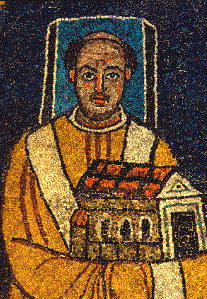 |
St Paschal I Pope Paschal I Pope Saint Paschal I was pope from January 25, 817 to February 11, 824. A native of Rome and son of Bonosus, he was raised to the pontificate by the acclamation of the clergy, shortly after the death of Pope Stephen IV, and before the sanction of the emperor Louis the Pious had been obtained - a... Papa PASCHALIS |
Rome | 7 | |||
| 99 | 8 May 824 – August 827 | 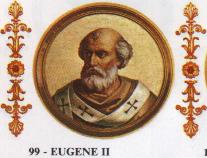 |
Eugene II Pope Eugene II Pope Eugene II, , pope was a native of Rome and was chosen to succeed Paschal I. Another candidate, Zinzinnus, was proposed by the plebeian faction, and the presence of Lothair I, son of the Frankish emperor Louis the Pious was necessary in order to maintain the authority of the new pope... Papa EUGENIUS Secundus |
Rome | 3 | |||
| 100 | August 827 – September 827 |  |
Valentine Pope Valentine Pope Valentine, , pope for thirty or forty days in 827, was a Roman by birth, and, according to the Liber Pontificalis, was first made a deacon by Paschal I... Papa VALENTINUS |
Rome | <1 | |||
| 101 | 827 – January 844 | Gregory IV Pope Gregory IV Pope Gregory IV was chosen to succeed Valentine in December 827, on which occasion he recognized the supremacy of the Frankish emperor Louis the Pious in the most unequivocal manner.... Papa GREGORIUS Quartus |
Rome | 17 | ||||
| 102 | January 844 – 7 January 847 | 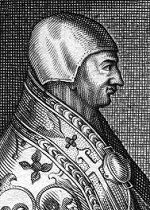 |
Sergius II Pope Sergius II Pope Sergius II was Pope from January 844 – January 24, 847.On the death of Gregory IV the archdeacon John was proclaimed pope by popular acclamation, while the nobility elected Sergius, a Roman of noble birth. The opposition was suppressed, with Sergius intervening to save John's life... Papa SERGIUS Secundus |
Rome | 3 | |||
| 103 | January 847 – 17 July 855 | 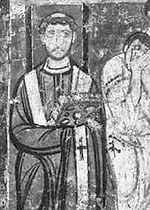 |
St Leo IV Pope Leo IV Pope Saint Leo IV was pope from 10 April 847 to 17 July 855.A Roman by birth, he was unanimously chosen to succeed Sergius II. When he was elected, on 10 April 847, he was cardinal of Santi Quattro Coronati, and had been subdeacon of Gregory IV and archpriest under his predecessor... , O.S.B. Order of Saint Benedict The Order of Saint Benedict is a Roman Catholic religious order of independent monastic communities that observe the Rule of St. Benedict. Within the order, each individual community maintains its own autonomy, while the organization as a whole exists to represent their mutual interests... Papa LEO Quartus |
Rome | 8 | Member of the Order of Saint Benedict Order of Saint Benedict The Order of Saint Benedict is a Roman Catholic religious order of independent monastic communities that observe the Rule of St. Benedict. Within the order, each individual community maintains its own autonomy, while the organization as a whole exists to represent their mutual interests... . |
||
| 104 | 855 – 7 April 858 | 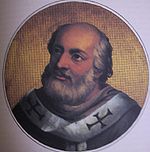 |
Benedict III Pope Benedict III Pope Benedict III was Pope from September 29, 855 to April 17, 858.Little is known of Benedict's life before his papacy. He was educated and lived in Rome and was cardinal priest of S. Callisto at the time of his election. Benedict had a reputation for learning and piety. He was elected upon the... Papa BENEDICTUS Tertius |
Rome | ||||
| 105 | 24 April 858 – 13 November 867 |  |
St Nicholas I Pope Nicholas I Pope Nicholas I, , or Saint Nicholas the Great, reigned from April 24, 858 until his death. He is remembered as a consolidator of papal authority and power, exerting decisive influence upon the historical development of the papacy and its position among the Christian nations of Western Europe.He... (Nicholas the Great) Papa NICOLAUS MAGNUS |
Rome | 9 | |||
| 106 | 14 December 867 – 14 December 872 | 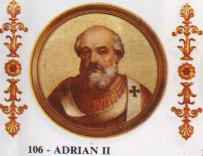 |
Adrian II Pope Adrian II Pope Adrian II , , pope from December 14, 867 to December 14, 872, was a member of a noble Roman family, and became pope in 867, at an advanced age.... Papa HADRIANUS Secundus |
Rome | 5 | |||
| 107 | 14 December 872 – 16 December 882 |  |
John VIII Pope John VIII Pope John VIII was pope from December 13, 872 to December 16, 882. He is often considered one of the ablest pontiffs of the ninth century and the last bright spot on the papacy until Leo IX two centuries later.... Papa IOANNES Octavus |
Rome | 10 | |||
| 108 | 16 December 882 – 15 May 884 | 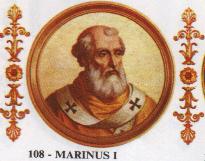 |
Marinus I Pope Marinus I Pope Marinus I , Pope between December 16, 882 and May 15, 884. He succeeded John VIII in about the end of December 882.-Prior history:... Papa MARINUS |
Gallese Gallese Gallese is an Italian comune in the Province of Viterbo, 35 km from that city.It was taken by Duke Thrasimund II of Spoleto in 737 or 738, at which time it was essential to communications between Rome and Ravenna and had a large fortress.... , Rome |
1 | |||
| 109 | 17 May 884 – c.September 885 | 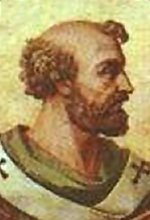 |
St Adrian III Pope Adrian III Pope Saint Adrian III was Pope from May 17, 884 to September 885. He was born at Rome. He died in September 885, at San Cesario sul Panaro , on a journey to Worms, in modern Germany.... Papa HADRIANUS Tertius |
Rome | ||||
| 110 | 885 – 14 September 891 | 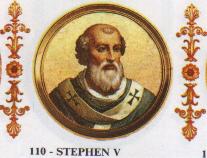 |
Stephen V Pope Stephen V Pope Stephen V was pope from 885 to 891. He succeeded Pope Adrian III, and was in turn succeeded by Pope Formosus. In his dealings with Constantinople in the matter of Photius, as also in his relations with the young Slavonic church, he pursued the policy of Pope Nicholas I.His father, Hadrian, who... (Stephen VI) Papa STEPHANUS Quintus (Sextus) |
Rome | Sometimes called Stephen VI | |||
| 111 | 19 September 891 – 4 April 896 | 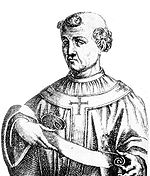 |
Formosus Pope Formosus Pope Formosus was Pope of the Catholic Church from 891 to 896. His brief reign as Pope was troubled, and his remains were exhumed and put on trial in the notorious Cadaver Synod.-Biography:... Papa FORMOSUS |
Ostia Ostia Antica (district) thumb|300px|The Castle of Julius II in Ostia Antica.thumb|300px|The square of Ostia Antica, with the church of Santa Aurea on the right.Ostia Antica is a district in the commune of Rome, Italy, five kilometers away from the coast. It is distinct from Ostia.- History :Under the Romans, Ostia Antica... |
4 | Posthumously ritually executed Posthumous execution Posthumous execution is the ritual or ceremonial mutilation of an already dead body as a punishment.-Examples:* Li Linfu, Chancellor of Tang China during the reign of Emperor Xuanzong in the latter years, was exhumed and executed for crimes of high treason by his rival Yang Guozhong for his... following the Cadaver Synod Cadaver Synod The Cadaver Synod is the name commonly given to the posthumous ecclesiastical trial of Catholic Pope Formosus, held in the Basilica of St... |
||
| 112 | 4 April 896 – 19 April 896 | 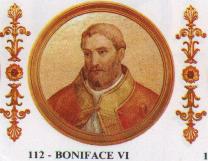 |
Boniface VI Pope Boniface VI Pope Boniface VI, pope, a native of Rome, was elected in April 896 as a result of riots soon after the death of Pope Formosus. Prior to his reign, he had twice incurred a sentence of deprivation of orders, as a subdeacon and as a priest... Papa BONIFACIUS Sextus |
Rome | <1 | |||
| 113 | 22 May 896 – August 897 | 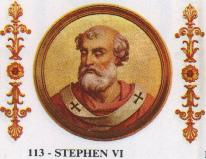 |
Stephen VI Pope Stephen VI Pope Stephen VI was Pope from May 22, 896 to August 897.He had been made bishop of Anagni by Pope Formosus. The circumstances of his election are unclear, but he was sponsored by one of the powerful Roman families, the house of Spoleto, that contested the papacy at the time.Stephen is chiefly... (Stephen VII) Papa STEPHANUS Sextus (Septimus) |
1 | Sometimes called Stephen VII | |||
| 114 | August 897 – November 897 | 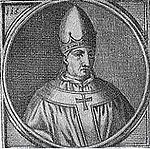 |
Romanus Pope Romanus Pope Romanus was Pope from August to November 897.He was born in Gallese, Italy near Civita Castellana.He was elected to succeed the murdered Pope Stephen VI and was deposed a few months later by one of the factions, which then governed Rome. His short rule was regarded as a virtuous one by the... Papa ROMANUS |
Gallese, Rome | <1 | |||
| 115 | December 897 | 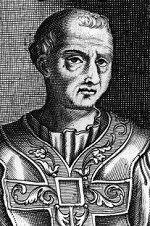 |
Theodore II Pope Theodore II Pope Theodore II was ordained as a priest by Pope Stephen V; also his brother Theotius was a bishop. He was pope for twenty days during December 897 before he died. He reinstated the clerics who had been forced from office by Pope Stephen VI, recognizing the validity of the ordinations of Pope... Papa THEODORUS Secundus |
Rome | <1 | |||
| 116 | January 898 – January 900 |  |
John IX Pope John IX -Early life:Little is known about John IX before he became Pope. Born in Tivoli in an unknown year, he was ordained as a Benedictine priest by Pope Formosus... , O.S.B. Order of Saint Benedict The Order of Saint Benedict is a Roman Catholic religious order of independent monastic communities that observe the Rule of St. Benedict. Within the order, each individual community maintains its own autonomy, while the organization as a whole exists to represent their mutual interests... Papa IOANNES Nonus |
Tivoli Tivoli, Italy Tivoli , the classical Tibur, is an ancient Italian town in Lazio, about 30 km east-north-east of Rome, at the falls of the Aniene river where it issues from the Sabine hills... |
Member of the Order of Saint Benedict Order of Saint Benedict The Order of Saint Benedict is a Roman Catholic religious order of independent monastic communities that observe the Rule of St. Benedict. Within the order, each individual community maintains its own autonomy, while the organization as a whole exists to represent their mutual interests... . |
|||
| 117 | 900 – 903 |  |
Benedict IV Pope Benedict IV Pope Benedict IV was Pope from 900 to 903. He was the son of Mammalus, a native of Rome. The tenth-century historian Frodoard, who nicknamed him the Great, commended his noble birth and public generosity... Papa BENEDICTUS Quartus |
Rome |
10th Century
| Numerical order | Pontificate | Portrait | Name English · Regnal (Latin) |
Personal name | Place of birth | Age at election / death or resigned | # years as pope | Notes |
|---|---|---|---|---|---|---|---|---|
| 118 | July 903 – September 903 | 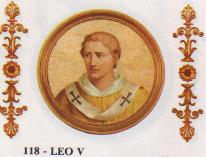 |
Leo V Pope Leo V Pope Leo V, a native of Ardea, was Pope for some thirty days in 903 after the death of Pope Benedict IV . He was dethroned by antipope Christopher , who is sometimes considered a legitimate pope. Elected while a priest, Leo V's pontificate occurred in the darkest period of papal history... Papa LEO Quintus |
Ardea Ardea (RM) Ardea is an ancient town and comune in the province of Rome, 35 km south of Rome and about 4 km from today's Mediterranean coast.... |
<1 | |||
| 119 | 29 January 904 – 14 April 911 |  |
Sergius III Pope Sergius III Pope Sergius III was a pope of the Roman Catholic Church from 29 January 904 to 14 April 911. Because Sergius III was possibly the only pope known to have ordered the murder of another pope and the only pope to have fathered an illegitimate son who later became pope , his reign has been described... Papa SERGIUS Tertius |
Rome | 7 | "Saeculum obscurum The Rule of the Harlots Saeculum obscurum is a name given to a period in the history of the Papacy during the first half of the 10th century, beginning with the installation of Pope Sergius III in 904 and lasting for sixty years until the death of Pope John XII in 964.... " begins |
||
| 120 | April 911 – June 913 | 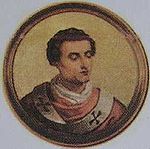 |
Anastasius III Pope Anastasius III Pope Anastasius III was Pope from April 911 to June 913, was a Roman by birth. A Roman nobleman, Lucian, is sometimes recognized as his father, although other sources assert that he was the illegitimate son of his predecessor Pope Sergius III .Practically nothing is recorded of Pope Anastasius... Papa ANASTASIUS Tertius |
Rome | 2 | |||
| 121 | July/August 913 – February/March 914 |  |
Lando Pope Lando Pope Lando was elected pope in either July or August 913. He died about six months later, in either February or March 914.... Papa LANDO |
Sabina, Italy | <1 | |||
| 122 | March 914 – May 928 |  |
John X Pope John X Pope John X, Pope from March 914 to May 928, was deacon at Bologna when he attracted the attention of Theodora, the wife of Theophylact, Count of Tusculum, the most powerful noble in Rome, through whose influence he was elevated first to the see of Bologna and then to the archbishopric of... Papa IOANNES Decimus |
Romagna Romagna Romagna is an Italian historical region that approximately corresponds to the south-eastern portion of present-day Emilia-Romagna. Traditionally, it is limited by the Apennines to the south-west, the Adriatic to the east, and the rivers Reno and Sillaro to the north and west... , Italy |
14 | |||
| 123 | May 928 – December 928 | 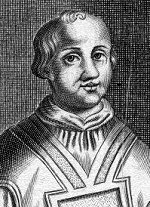 |
Leo VI Papa LEO Sextus |
Rome | <1 | |||
| 124 | December 928 – February 931 | 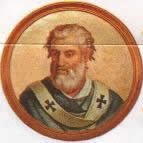 |
Stephen VII Pope Stephen VII Pope Stephen VII . Stephen was a Roman by birth, the son of Theodemundus, and perhaps a member of the Gabrielli family. He was elected—probably handpicked—by Marozia from the Tusculani family, as a stop-gap measure until her own son John was ready to assume the throne of Peter... (Stephen VIII) Papa STEPHANUS Septimus (Octavus) |
Rome | 2 | Sometimes called Stephen VIII | ||
| 125 | February/March 931 – December 935 |  |
John XI Pope John XI Pope John XI was a Pope from March 931 to December 935.-Parentage:The parentage of John XI is still a matter of dispute. According to Liutprand of Cremona and the "Liber Pontificalis," he was the natural son of Pope Sergius III , Pope John XI (910? – December 935) was a Pope from March 931 (at... Papa IOANNES Undecimus |
Rome | 4 | |||
| 126 | 3 January 936 – 13 July 939 | 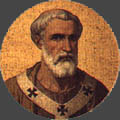 |
Leo VII Pope Leo VII Pope Leo VII , Pope from January 3, 936 until his death in 939, was preceded by Pope John XI , and followed by Pope Stephen VIII . Leo VII's election to the papacy was secured by Alberic II of Spoleto, the monarch in Rome. Alberic wanted to choose the pope so that the papacy would continue to... , O.S.B. Order of Saint Benedict The Order of Saint Benedict is a Roman Catholic religious order of independent monastic communities that observe the Rule of St. Benedict. Within the order, each individual community maintains its own autonomy, while the organization as a whole exists to represent their mutual interests... Papa LEO Septimus |
3 | Member of the Order of Saint Benedict Order of Saint Benedict The Order of Saint Benedict is a Roman Catholic religious order of independent monastic communities that observe the Rule of St. Benedict. Within the order, each individual community maintains its own autonomy, while the organization as a whole exists to represent their mutual interests... . |
|||
| 127 | 14 July 939 – October 942 | 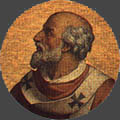 |
Stephen VIII Pope Stephen VIII Pope Stephen VIII, a native of Germany, was pope from about July 14, 939 until his death towards the end of October 942.During his pontificate he was subject to Alberic II of Spoleto, Prince of the Romans, and did not effectively rule the Papal States... (Stephen IX) Papa STEPHANUS Octavus (Nonus) |
Germany | 3 | Sometimes called Stephen IX | ||
| 128 | 30 October 942 – May 946 | 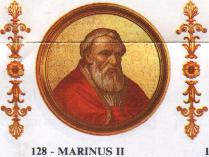 |
Marinus II Pope Marinus II Pope Marinus II , born in Rome, was Pope from 942 to 946. He was elevated to the papacy through intervention of Alberic II of Spoleto and concentrated on administrative aspects of the papacy.-External links:*... Papa MARINUS Secundus |
Rome | 3 | |||
| 129 | 10 May 946 – December 955 | 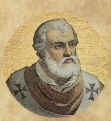 |
Agapetus II Pope Agapetus II Pope Agapetus II was Pope from May 10, 946 until his death in 955, at the time when Alberic II , son of Marozia, was governing the independent republic of Rome under the title of "prince and senator of the Romans."... Papa AGAPETUS Secundus |
Rome | 9 | |||
| 130 | 16 December 955 – 14 May 964 | John XII Pope John XII Pope John XII , born Octavianus, was Pope from December 16, 955, to May 14, 964. The son of Alberic II, Patrician of Rome , and his stepsister Alda of Vienne, he was a seventh generation descendant of Charlemagne on his mother's side.Before his death, Alberic administered an oath to the Roman... Papa IOANNES Duodecimus |
Octavian | Rome | 8 | Deposed in 963 by Emperor Otto invalidly; end of the "Saeculum obscurum The Rule of the Harlots Saeculum obscurum is a name given to a period in the history of the Papacy during the first half of the 10th century, beginning with the installation of Pope Sergius III in 904 and lasting for sixty years until the death of Pope John XII in 964.... " |
||
| 131 | 22 May 964 – 23 June 964 | 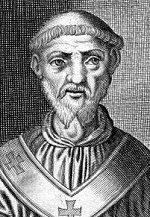 |
Benedict V Pope Benedict V Pope Benedict V , Pope in 964, was elected by the Romans on the death of Pope John XII . However the Holy Roman Emperor Otto I did not approve of the choice and had him deposed after only a month and the ex-Pope was carried off to Hamburg and was placed under the care of Adaldag, Archbishop of... Papa BENEDICTUS Quintus |
Rome | <1 | Elected after John XII Pope John XII Pope John XII , born Octavianus, was Pope from December 16, 955, to May 14, 964. The son of Alberic II, Patrician of Rome , and his stepsister Alda of Vienne, he was a seventh generation descendant of Charlemagne on his mother's side.Before his death, Alberic administered an oath to the Roman... 's death by the people of Rome, in opposition to the Antipope Leo VIII Pope Leo VIII Pope Leo VIII , a Roman by birth, is considered by the Church an Antipope from 963 to 964 and a true Pope from 964 to 965. He held the lay office of protoserinus when he was elected pope by the Roman synod in December 963, when it also invalidly deposed Pope John XII , who was still alive... who was appointed by Emperor Otto; Benedict accepted his deposition in 964 leaving Leo as sole pope. |
||
| 132 | July 964 – 1 March 965 | 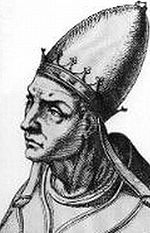 |
Leo VIII Pope Leo VIII Pope Leo VIII , a Roman by birth, is considered by the Church an Antipope from 963 to 964 and a true Pope from 964 to 965. He held the lay office of protoserinus when he was elected pope by the Roman synod in December 963, when it also invalidly deposed Pope John XII , who was still alive... Papa LEO Octavus |
Rome | <1 | Appointed antipope by Emperor Otto in 963 in opposition to John XII Pope John XII Pope John XII , born Octavianus, was Pope from December 16, 955, to May 14, 964. The son of Alberic II, Patrician of Rome , and his stepsister Alda of Vienne, he was a seventh generation descendant of Charlemagne on his mother's side.Before his death, Alberic administered an oath to the Roman... and Benedict V Pope Benedict V Pope Benedict V , Pope in 964, was elected by the Romans on the death of Pope John XII . However the Holy Roman Emperor Otto I did not approve of the choice and had him deposed after only a month and the ex-Pope was carried off to Hamburg and was placed under the care of Adaldag, Archbishop of... . He became the true Pope after Benedict V was deposed |
||
| 133 | 1 October 965 – 6 September 972 | John XIII Pope John XIII Pope John XIII of Crescenzi family served as Pope from October 1, 965, until his death.Born in Rome, he spent his career in the papal court... Papa IOANNES Tertius Decimus |
Rome | 6 | ||||
| 134 | 19 January 973 – June 974 | 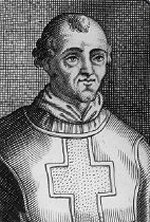 |
Benedict VI Pope Benedict VI Pope Benedict VI was pope from January 19, 973 to June 974.He was born in Rome as the son of Hildebrand and was chosen with great ceremony and installed as pope under the protection of the Emperor Otto I on January 19, 973. During his pontificate, Benedict VI confirmed the privileges of some of... Papa BENEDICTUS Sextus |
Rome, Papal States Papal States The Papal State, State of the Church, or Pontifical States were among the major historical states of Italy from roughly the 6th century until the Italian peninsula was unified in 1861 by the Kingdom of Piedmont-Sardinia .The Papal States comprised territories under... |
1 | Deposed and murdered | ||
| 135 | October 974 – 10 July 983 |  |
Benedict VII Pope Benedict VII Pope Benedict VII, born in Rome, the son of David or Deodatus , and previously Bishop of Sutri, died July 10, 983; belonged to the noble family of the Counts of Tusculum. He was elected by the Roman clergy and people under the influence of Sicco, imperial envoy of Emperor Otto II... Papa BENEDICTUS Septimus |
Rome | 8 | |||
| 136 | December 983 – 20 August 984 |  |
John XIV Pope John XIV Pope John XIV was Pope from December, 983 to August 20, 984, successor to Pope Benedict VII He was born at Pavia, and before his elevation to the papal chair was imperial chancellor of Emperor Otto II , and was the latter's second choice.His original name was Pietro Canepanova, but he took the... Papa IOANNES Quartus Decimus |
Pietro Campanora | Pavia Pavia Pavia , the ancient Ticinum, is a town and comune of south-western Lombardy, northern Italy, 35 km south of Milan on the lower Ticino river near its confluence with the Po. It is the capital of the province of Pavia. It has a population of c. 71,000... |
<1 | ||
| 137 | August 985 – March 996 |  |
John XV Pope John XV Pope John XV , Pope from 985 to 996, succeeding Boniface VII . He was said to have been Pope after another Pope John that reigned four months after Pope John XIV and was named "Papa Ioannes XIV Bis" or "Pope John XIVb"... Papa IOANNES Quintus Decimus |
Rome | 10 | |||
| 138 | 3 May 996 – 18 February 999 | 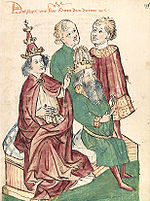 |
Gregory V Pope Gregory V Pope Gregory V, né Bruno of Carinthia , Pope from May 3, 996 to February 18, 999, son of the Salian Otto I, Duke of Carinthia, who was a grandson of the Emperor Otto I the Great . Gregory V succeeded Pope John XV , when only twenty-four years of age... Papa GREGORIUS Quintus |
Bruno of Carinthia | Germany, Holy Roman Empire Holy Roman Empire The Holy Roman Empire was a realm that existed from 962 to 1806 in Central Europe.It was ruled by the Holy Roman Emperor. Its character changed during the Middle Ages and the Early Modern period, when the power of the emperor gradually weakened in favour of the princes... |
2 | First German Pope | |
| 139 | 2 April 999 – 12 May 1003 |  |
Sylvester II Papa SILVESTER Secundus |
Gerbert d'Aurillac | Auvergne Auvergne (province) Auvergne was a historic province in south central France. It was originally the feudal domain of the Counts of Auvergne. It is now the geographical and cultural area that corresponds to the former province.... region of France |
4 | First French Pope |
11th Century
| Numerical order | Pontificate | Portrait | Name English · Regnal (Latin) |
Personal name | Place of birth | Notes |
|---|---|---|---|---|---|---|
| 140 | June 1003 – December 1003 |
 |
John XVII Pope John XVII Pope John XVII , born John Sicco, and the son of another John Sicco, was born in the region of Rome then referred to as Biveretica... Papa IOANNES Septimus Decimus |
Siccone | Rome Rome Rome is the capital of Italy and the country's largest and most populated city and comune, with over 2.7 million residents in . The city is located in the central-western portion of the Italian Peninsula, on the Tiber River within the Lazio region of Italy.Rome's history spans two and a half... , Papal States Papal States The Papal State, State of the Church, or Pontifical States were among the major historical states of Italy from roughly the 6th century until the Italian peninsula was unified in 1861 by the Kingdom of Piedmont-Sardinia .The Papal States comprised territories under... |
|
| 141 | 25 December 1003 – July 1009 (5 years) |
 |
John XVIII Pope John XVIII Pope John XVIII was Pope in Pisa from 1004 to 1009. He was born Fasanius at Rapagnano, near Ascoli Piceno, the son of a Roman priest named Leo.... Papa IOANNES DuodeVicesimus |
Giovanni Fasano; Phasianus | Rapagnano Rapagnano Rapagnano is a comune in the Province of Fermo in the Italian region Marche, located about 50 km south of Ancona and about 35 km north of Ascoli Piceno.-References:... , Papal States Papal States The Papal State, State of the Church, or Pontifical States were among the major historical states of Italy from roughly the 6th century until the Italian peninsula was unified in 1861 by the Kingdom of Piedmont-Sardinia .The Papal States comprised territories under... |
|
| 142 | 31 July 1009 – 12 May 1012 (2 years) |
 |
Sergius IV Pope Sergius IV Pope Sergius IV , born Pietro Martino Buccaporci, was Pope from July 31, 1009, until his death. The date of his birth is unknown. His birth name is believed to have been Pietro Martino Buccaporci... Papa SERGIUS Quartus |
Pietro Boccapecora | Rome Rome Rome is the capital of Italy and the country's largest and most populated city and comune, with over 2.7 million residents in . The city is located in the central-western portion of the Italian Peninsula, on the Tiber River within the Lazio region of Italy.Rome's history spans two and a half... , Papal States Papal States The Papal State, State of the Church, or Pontifical States were among the major historical states of Italy from roughly the 6th century until the Italian peninsula was unified in 1861 by the Kingdom of Piedmont-Sardinia .The Papal States comprised territories under... , Holy Roman Empire Holy Roman Empire The Holy Roman Empire was a realm that existed from 962 to 1806 in Central Europe.It was ruled by the Holy Roman Emperor. Its character changed during the Middle Ages and the Early Modern period, when the power of the emperor gradually weakened in favour of the princes... |
|
| 143 | 18 May 1012 – 9 April 1024 (11 years) |
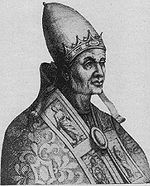 |
Benedict VIII Pope Benedict VIII Pope Benedict VIII , born Theophylactus, Pope from 1012 to 1024, of the noble family of the counts of Tusculum , descended from Theophylact, Count of Tusculum like his predecessor Pope Benedict VI .Benedict VIII was opposed by an antipope, Gregory... Papa BENEDICTUS Octavus |
Theophylactus II, Conti di Tusculum | Rome Rome Rome is the capital of Italy and the country's largest and most populated city and comune, with over 2.7 million residents in . The city is located in the central-western portion of the Italian Peninsula, on the Tiber River within the Lazio region of Italy.Rome's history spans two and a half... , Papal States Papal States The Papal State, State of the Church, or Pontifical States were among the major historical states of Italy from roughly the 6th century until the Italian peninsula was unified in 1861 by the Kingdom of Piedmont-Sardinia .The Papal States comprised territories under... , Holy Roman Empire Holy Roman Empire The Holy Roman Empire was a realm that existed from 962 to 1806 in Central Europe.It was ruled by the Holy Roman Emperor. Its character changed during the Middle Ages and the Early Modern period, when the power of the emperor gradually weakened in favour of the princes... |
|
| 144 | April/May 1024 – 20 October 1032 (8 years) |
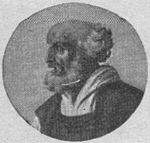 |
John XIX Pope John XIX Pope John XIX , born Romanus, was Pope from 1024 to 1032.He succeeded his brother, Pope Benedict VIII , both being members of the powerful house of Tusculum... Papa IOANNES UndeVicesimus |
Romanus, Conti di Tusculum | Rome Rome Rome is the capital of Italy and the country's largest and most populated city and comune, with over 2.7 million residents in . The city is located in the central-western portion of the Italian Peninsula, on the Tiber River within the Lazio region of Italy.Rome's history spans two and a half... , Papal States Papal States The Papal State, State of the Church, or Pontifical States were among the major historical states of Italy from roughly the 6th century until the Italian peninsula was unified in 1861 by the Kingdom of Piedmont-Sardinia .The Papal States comprised territories under... , Holy Roman Empire Holy Roman Empire The Holy Roman Empire was a realm that existed from 962 to 1806 in Central Europe.It was ruled by the Holy Roman Emperor. Its character changed during the Middle Ages and the Early Modern period, when the power of the emperor gradually weakened in favour of the princes... |
|
| 145 | 1032–1044 | 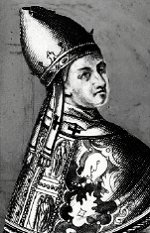 |
Benedict IX Pope Benedict IX Pope Benedict IX , born Theophylactus of Tusculum, was Pope on three occasions between 1032 and 1048. One of the youngest popes, he was the only man to have been Pope on more than one occasion and the only man ever to have sold the papacy.-Biography:Benedict was born in Rome as Theophylactus, the... Papa BENEDICTUS Nonus |
Theophylactus III, Conti di Tusculum | Rome Rome Rome is the capital of Italy and the country's largest and most populated city and comune, with over 2.7 million residents in . The city is located in the central-western portion of the Italian Peninsula, on the Tiber River within the Lazio region of Italy.Rome's history spans two and a half... , Papal States Papal States The Papal State, State of the Church, or Pontifical States were among the major historical states of Italy from roughly the 6th century until the Italian peninsula was unified in 1861 by the Kingdom of Piedmont-Sardinia .The Papal States comprised territories under... , Holy Roman Empire Holy Roman Empire The Holy Roman Empire was a realm that existed from 962 to 1806 in Central Europe.It was ruled by the Holy Roman Emperor. Its character changed during the Middle Ages and the Early Modern period, when the power of the emperor gradually weakened in favour of the princes... |
1st Term |
| 146 | 1045 | 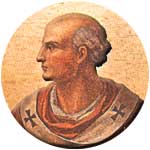 |
Sylvester III Papa SILVESTER Tertius |
John, Bishop of Sabina | Rome Rome Rome is the capital of Italy and the country's largest and most populated city and comune, with over 2.7 million residents in . The city is located in the central-western portion of the Italian Peninsula, on the Tiber River within the Lazio region of Italy.Rome's history spans two and a half... , Papal States Papal States The Papal State, State of the Church, or Pontifical States were among the major historical states of Italy from roughly the 6th century until the Italian peninsula was unified in 1861 by the Kingdom of Piedmont-Sardinia .The Papal States comprised territories under... , Holy Roman Empire Holy Roman Empire The Holy Roman Empire was a realm that existed from 962 to 1806 in Central Europe.It was ruled by the Holy Roman Emperor. Its character changed during the Middle Ages and the Early Modern period, when the power of the emperor gradually weakened in favour of the princes... |
Validity of election questioned; considered Anti-Pope; deposed at the Council of Sutri Council of Sutri The Council of Sutri was called by Henry III, King of the Germans and opened on December 20, 1046, in the hilltown of Sutri, at the edge of the Duchy of Rome. The Catholic Church does not list this as an ecumenical council.... . |
| 147 | 1045–1046 |  |
Benedict IX Pope Benedict IX Pope Benedict IX , born Theophylactus of Tusculum, was Pope on three occasions between 1032 and 1048. One of the youngest popes, he was the only man to have been Pope on more than one occasion and the only man ever to have sold the papacy.-Biography:Benedict was born in Rome as Theophylactus, the... Papa BENEDICTUS Nonus |
Theophylactus III, Conti di Tusculum | Rome Rome Rome is the capital of Italy and the country's largest and most populated city and comune, with over 2.7 million residents in . The city is located in the central-western portion of the Italian Peninsula, on the Tiber River within the Lazio region of Italy.Rome's history spans two and a half... , Papal States Papal States The Papal State, State of the Church, or Pontifical States were among the major historical states of Italy from roughly the 6th century until the Italian peninsula was unified in 1861 by the Kingdom of Piedmont-Sardinia .The Papal States comprised territories under... , Holy Roman Empire Holy Roman Empire The Holy Roman Empire was a realm that existed from 962 to 1806 in Central Europe.It was ruled by the Holy Roman Emperor. Its character changed during the Middle Ages and the Early Modern period, when the power of the emperor gradually weakened in favour of the princes... |
2nd Term; deposed at the Council of Sutri Council of Sutri The Council of Sutri was called by Henry III, King of the Germans and opened on December 20, 1046, in the hilltown of Sutri, at the edge of the Duchy of Rome. The Catholic Church does not list this as an ecumenical council.... |
| 148 | April/May 1045 – 20 December 1046 (1 year) |
 |
Gregory VI Pope Gregory VI Pope Gregory VI , born John Gratian , was Pope from 1 May 1045 until his abdication at the Council of Sutri on 20 December 1046.... Papa GREGORIUS Sextus, |
Johannes Gratianus | Rome Rome Rome is the capital of Italy and the country's largest and most populated city and comune, with over 2.7 million residents in . The city is located in the central-western portion of the Italian Peninsula, on the Tiber River within the Lazio region of Italy.Rome's history spans two and a half... , Papal States Papal States The Papal State, State of the Church, or Pontifical States were among the major historical states of Italy from roughly the 6th century until the Italian peninsula was unified in 1861 by the Kingdom of Piedmont-Sardinia .The Papal States comprised territories under... , Holy Roman Empire Holy Roman Empire The Holy Roman Empire was a realm that existed from 962 to 1806 in Central Europe.It was ruled by the Holy Roman Emperor. Its character changed during the Middle Ages and the Early Modern period, when the power of the emperor gradually weakened in favour of the princes... |
Deposed at the Council of Sutri Council of Sutri The Council of Sutri was called by Henry III, King of the Germans and opened on December 20, 1046, in the hilltown of Sutri, at the edge of the Duchy of Rome. The Catholic Church does not list this as an ecumenical council.... |
| 149 | 24 December 1046 – 9 October 1047 (289 days) |
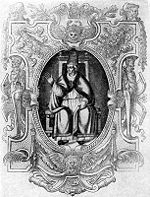 |
Clement II Pope Clement II Pope Clement II , was Pope from December 25, 1046 to his death. He was the first in a series of reform-minded popes from Germany.Born in Hornburg, Lower Saxony, Germany, he was the son of Count Konrad of Morsleben and Hornburg and his wife Amulrad.In 1040, he became Bishop of Bamberg... Papa CLEMENS Secundus |
Suidger | Hornburg Hornburg Hornburg is a town in the Wolfenbüttel district, in the German state of Lower Saxony. It is situated at the Ilse river, a tributary of the Oker. Hornburg is part of the Samtgemeinde Schladen and home to numerous historically valuable half-timber buildings... , Duchy of Saxony Duchy of Saxony The medieval Duchy of Saxony was a late Early Middle Ages "Carolingian stem duchy" covering the greater part of Northern Germany. It covered the area of the modern German states of Bremen, Hamburg, Lower Saxony, North Rhine-Westphalia, and Saxony-Anhalt and most of Schleswig-Holstein... , Holy Roman Empire Holy Roman Empire The Holy Roman Empire was a realm that existed from 962 to 1806 in Central Europe.It was ruled by the Holy Roman Emperor. Its character changed during the Middle Ages and the Early Modern period, when the power of the emperor gradually weakened in favour of the princes... |
|
| 150 | November 1047 – 1048 |
 |
Benedict IX Pope Benedict IX Pope Benedict IX , born Theophylactus of Tusculum, was Pope on three occasions between 1032 and 1048. One of the youngest popes, he was the only man to have been Pope on more than one occasion and the only man ever to have sold the papacy.-Biography:Benedict was born in Rome as Theophylactus, the... Papa BENEDICTUS Nonus |
Theophylactus III, Conti di Tusculum | Rome Rome Rome is the capital of Italy and the country's largest and most populated city and comune, with over 2.7 million residents in . The city is located in the central-western portion of the Italian Peninsula, on the Tiber River within the Lazio region of Italy.Rome's history spans two and a half... , Papal States Papal States The Papal State, State of the Church, or Pontifical States were among the major historical states of Italy from roughly the 6th century until the Italian peninsula was unified in 1861 by the Kingdom of Piedmont-Sardinia .The Papal States comprised territories under... , Holy Roman Empire Holy Roman Empire The Holy Roman Empire was a realm that existed from 962 to 1806 in Central Europe.It was ruled by the Holy Roman Emperor. Its character changed during the Middle Ages and the Early Modern period, when the power of the emperor gradually weakened in favour of the princes... |
3rd Term; deposed and excommunicated |
| 151 | 17 July 1048 – 9 August 1048 (23 days) |
 |
Damasus II Pope Damasus II Pope Damasus II , born Poppo, Pope from July 17, 1048 to August 9, 1048, was the second of the German pontiffs nominated by Emperor Henry III . A native of Bavaria, he was the third German to become Pope and had one of the shortest papal reigns... Papa DAMASUS Secundus |
Poppo | Pildenau, Duchy of Bavaria Duchy of Bavaria The Duchy of Bavaria was the only one of the stem duchies from the earliest days of East Francia and the Kingdom of Germany to preserve both its name and most of its territorial extent.... , Holy Roman Empire Holy Roman Empire The Holy Roman Empire was a realm that existed from 962 to 1806 in Central Europe.It was ruled by the Holy Roman Emperor. Its character changed during the Middle Ages and the Early Modern period, when the power of the emperor gradually weakened in favour of the princes... |
|
| 152 | 12 February 1049 – 19 April 1054 (5 years) |
 |
St Leo IX Pope Leo IX Pope Saint Leo IX , born Bruno of Eguisheim-Dagsburg, was Pope from February 12, 1049 to his death. He was a German aristocrat and as well as being Pope was a powerful secular ruler of central Italy. He is regarded as a saint by the Roman Catholic Church, with the feast day of April 19... Papa LEO Nonus |
Bruno, Count of Dagsbourg | Eguisheim Eguisheim Eguisheim is a commune in the Haut-Rhin department in Alsace in north-eastern France.Eguisheim produces Alsace wine of high quality. The commune is largely German-speaking.-History:... , Swabia Duchy of Swabia Swabia was one of the five stem duchies of the medieval German kingdom, and its dukes were thus among the most powerful magnates of Germany.-History:... , Holy Roman Empire Holy Roman Empire The Holy Roman Empire was a realm that existed from 962 to 1806 in Central Europe.It was ruled by the Holy Roman Emperor. Its character changed during the Middle Ages and the Early Modern period, when the power of the emperor gradually weakened in favour of the princes... |
In 1054, Leo IX and Patriarch of Constantinople Patriarch of Constantinople The Ecumenical Patriarch is the Archbishop of Constantinople – New Rome – ranking as primus inter pares in the Eastern Orthodox communion, which is seen by followers as the One, Holy, Catholic, and Apostolic Church.... Michael I Cerularius Michael I Cerularius Michael I Cerularius , also known as Michael Keroularios or Patriarch Michael I, was the Ecumenical Patriarch of Constantinople from 1043 to 1059.-Biography:... excommunicated each other, beginning the still-existing East–West Schism East–West Schism The East–West Schism of 1054, sometimes known as the Great Schism, formally divided the State church of the Roman Empire into Eastern and Western branches, which later became known as the Eastern Orthodox Church and the Roman Catholic Church, respectively... . |
| 153 | 13 April 1055 – 28 July 1057 (2 years) |
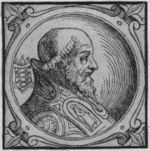 |
Victor II Pope Victor II Pope Victor II , born Gebhard, Count of Calw, Tollenstein, and Hirschberg, was Pope from 1055 to 1057. He was one of a series of German reform Popes.-Life:... Papa VICTOR Secundus |
Gebhard, Count of Calw, Tollenstein, and Hirschberg | Kingdom of Germany Kingdom of Germany The Kingdom of Germany developed out of the eastern half of the former Carolingian Empire.... , Holy Roman Empire Holy Roman Empire The Holy Roman Empire was a realm that existed from 962 to 1806 in Central Europe.It was ruled by the Holy Roman Emperor. Its character changed during the Middle Ages and the Early Modern period, when the power of the emperor gradually weakened in favour of the princes... |
|
| 154 | 2 August 1057 – 29 March 1058 (241 days) |
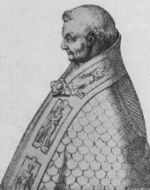 |
Stephen IX Pope Stephen IX Pope Stephen IX was Pope from August 3, 1057 to March 1058.His baptismal name was Frederick of Lorraine , and he was a younger brother of Godfrey III, Duke of Lower Lorraine, who, as Marquis of Tuscany , played a prominent part in the politics of the period.Frederick, who had... (Stephen X), O.S.B. Order of Saint Benedict The Order of Saint Benedict is a Roman Catholic religious order of independent monastic communities that observe the Rule of St. Benedict. Within the order, each individual community maintains its own autonomy, while the organization as a whole exists to represent their mutual interests... Papa STEPHANUS Nonus (Decimus) |
Frédéric de Lorraine | Duchy of Lorraine Lorraine (province) The Duchy of Upper Lorraine was an historical duchy roughly corresponding with the present-day northeastern Lorraine region of France, including parts of modern Luxembourg and Germany. The main cities were Metz, Verdun, and the historic capital Nancy.... , Holy Roman Empire Holy Roman Empire The Holy Roman Empire was a realm that existed from 962 to 1806 in Central Europe.It was ruled by the Holy Roman Emperor. Its character changed during the Middle Ages and the Early Modern period, when the power of the emperor gradually weakened in favour of the princes... |
Sometimes called Stephen X. Member of the Order of Saint Benedict Order of Saint Benedict The Order of Saint Benedict is a Roman Catholic religious order of independent monastic communities that observe the Rule of St. Benedict. Within the order, each individual community maintains its own autonomy, while the organization as a whole exists to represent their mutual interests... . |
| 155 | 6 December 1058 – 27 July 1061 (2 years) |
 |
Nicholas II Pope Nicholas II Pope Nicholas II , born Gérard de Bourgogne, Pope from 1059 to July 1061, was at the time of his election the Bishop of Florence.-Antipope Benedict X:... Papa NICOLAUS Secundus |
Gérard de Bourgogne | Château de Chevron Mercury, Savoie Mercury is a commune in the Savoie département in the Rhône-Alpes region in south-eastern France.The inhabitants are called Chevronnais.-Sites and monuments:* Château de Chevron, a 14th century castle remodelled in the 17th century.... , Kingdom of Arles Kingdom of Arles The Kingdom of Arles or Second Kingdom of Burgundy of the High Middle Ages was a Frankish dominion established in 933 from lands of the early medieval Kingdom of Burgundy at Arles... |
|
| 156 | 30 September 1061 – 21 April 1073 (11 years) |
Alexander II Pope Alexander II Pope Alexander II , born Anselmo da Baggio, was Pope from 1061 to 1073.He was born in Milan. As bishop of Lucca he had been an energetic coadjutor with Hildebrand of Sovana in endeavouring to suppress simony, and to enforce the celibacy of the clergy... Papa ALEXANDER Secundus |
Anselmo da Baggio | Milan Milan Milan is the second-largest city in Italy and the capital city of the region of Lombardy and of the province of Milan. The city proper has a population of about 1.3 million, while its urban area, roughly coinciding with its administrative province and the bordering Province of Monza and Brianza ,... , Italy Kingdom of Italy (medieval) The Kingdom of Italy was a political entity under control of Carolingian dynasty of Francia first, after the defeat of the Lombards in 774. It was finally incorporated as a part of the Holy Roman Empire in 962.... , Holy Roman Empire Holy Roman Empire The Holy Roman Empire was a realm that existed from 962 to 1806 in Central Europe.It was ruled by the Holy Roman Emperor. Its character changed during the Middle Ages and the Early Modern period, when the power of the emperor gradually weakened in favour of the princes... |
||
| 157 | 22 April 1073 – 25 May 1085 (12 years) |
 |
St Gregory VII Pope Gregory VII Pope St. Gregory VII , born Hildebrand of Sovana , was Pope from April 22, 1073, until his death. One of the great reforming popes, he is perhaps best known for the part he played in the Investiture Controversy, his dispute with Henry IV, Holy Roman Emperor affirming the primacy of the papal... , O.S.B. Order of Saint Benedict The Order of Saint Benedict is a Roman Catholic religious order of independent monastic communities that observe the Rule of St. Benedict. Within the order, each individual community maintains its own autonomy, while the organization as a whole exists to represent their mutual interests... Papa GREGORIUS Septimus |
Hildebrand | Sovana Sovana 250px|thumb|A view of a street in Sovana.Sovana is a small town in southern Tuscany, Italy, a frazione of Sorano, a comune in the province of Grosseto.-History:... , Italy Kingdom of Italy (medieval) The Kingdom of Italy was a political entity under control of Carolingian dynasty of Francia first, after the defeat of the Lombards in 774. It was finally incorporated as a part of the Holy Roman Empire in 962.... , Holy Roman Empire Holy Roman Empire The Holy Roman Empire was a realm that existed from 962 to 1806 in Central Europe.It was ruled by the Holy Roman Emperor. Its character changed during the Middle Ages and the Early Modern period, when the power of the emperor gradually weakened in favour of the princes... |
Restricted the use of title "Papa" to the Bishop of Rome. Member of the Order of Saint Benedict Order of Saint Benedict The Order of Saint Benedict is a Roman Catholic religious order of independent monastic communities that observe the Rule of St. Benedict. Within the order, each individual community maintains its own autonomy, while the organization as a whole exists to represent their mutual interests... . |
| 158 | 24 May 1086 – 16 September 1087 (1 year) |
 |
Bd. Victor III Pope Victor III Pope Blessed Victor III , born Daufer , Latinised Dauferius, was the Pope as the successor of Pope Gregory VII, yet his pontificate is far less impressive in history than his time as Desiderius, the great Abbot of Monte Cassino.-Early life and abbacy:He was born in 1026 or 1027 of a non-regnant... , O.S.B. Order of Saint Benedict The Order of Saint Benedict is a Roman Catholic religious order of independent monastic communities that observe the Rule of St. Benedict. Within the order, each individual community maintains its own autonomy, while the organization as a whole exists to represent their mutual interests... Papa VICTOR Tertius |
Desiderio; Desiderius; Dauferius | Benevento Benevento Benevento is a town and comune of Campania, Italy, capital of the province of Benevento, 50 km northeast of Naples. It is situated on a hill 130 m above sea-level at the confluence of the Calore Irpino and Sabato... , Duchy of Benevento Duchy of Benevento The Duchy and later Principality of Benevento was the southernmost Lombard duchy in medieval Italy, centred on Benevento, a city central in the Mezzogiorno. Owing to the Ducatus Romanus of the popes, which cut it off from the rest of Lombard Italy, Benevento was from the first practically... |
Member of the Order of Saint Benedict Order of Saint Benedict The Order of Saint Benedict is a Roman Catholic religious order of independent monastic communities that observe the Rule of St. Benedict. Within the order, each individual community maintains its own autonomy, while the organization as a whole exists to represent their mutual interests... . |
| 159 | 12 March 1088 – 29 July 1099 (11 years) |
 |
Bd. Urban II Pope Urban II Pope Urban II , born Otho de Lagery , was Pope from 12 March 1088 until his death on July 29 1099... , O.S.B. Order of Saint Benedict The Order of Saint Benedict is a Roman Catholic religious order of independent monastic communities that observe the Rule of St. Benedict. Within the order, each individual community maintains its own autonomy, while the organization as a whole exists to represent their mutual interests... Papa URBANUS Secundus |
Odo of Lagery | Lagery Lagery Lagery is a commune in the Marne department in north-eastern France. Is is the birthplace of Pope Urban II.... , County of Champagne, France France The French Republic , The French Republic , The French Republic , (commonly known as France , is a unitary semi-presidential republic in Western Europe with several overseas territories and islands located on other continents and in the Indian, Pacific, and Atlantic oceans. Metropolitan France... |
Started the First Crusade First Crusade The First Crusade was a military expedition by Western Christianity to regain the Holy Lands taken in the Muslim conquest of the Levant, ultimately resulting in the recapture of Jerusalem... . Member of the Order of Saint Benedict Order of Saint Benedict The Order of Saint Benedict is a Roman Catholic religious order of independent monastic communities that observe the Rule of St. Benedict. Within the order, each individual community maintains its own autonomy, while the organization as a whole exists to represent their mutual interests... . |
| 160 | 13 August 1099 – 21 January 1118 (18 years) |
 |
Paschal II Pope Paschal II Pope Paschal II , born Ranierius, was Pope from August 13, 1099, until his death. A monk of the Cluniac order, he was created cardinal priest of the Titulus S... , O.S.B. Order of Saint Benedict The Order of Saint Benedict is a Roman Catholic religious order of independent monastic communities that observe the Rule of St. Benedict. Within the order, each individual community maintains its own autonomy, while the organization as a whole exists to represent their mutual interests... Papa PASCHALIS Secundus |
Raniero | Bleda, Papal States Papal States The Papal State, State of the Church, or Pontifical States were among the major historical states of Italy from roughly the 6th century until the Italian peninsula was unified in 1861 by the Kingdom of Piedmont-Sardinia .The Papal States comprised territories under... , Holy Roman Empire Holy Roman Empire The Holy Roman Empire was a realm that existed from 962 to 1806 in Central Europe.It was ruled by the Holy Roman Emperor. Its character changed during the Middle Ages and the Early Modern period, when the power of the emperor gradually weakened in favour of the princes... |
Member of the Order of Saint Benedict Order of Saint Benedict The Order of Saint Benedict is a Roman Catholic religious order of independent monastic communities that observe the Rule of St. Benedict. Within the order, each individual community maintains its own autonomy, while the organization as a whole exists to represent their mutual interests... . |
12th Century
| Numerical order | Pontificate | Portrait | Name English · Regnal (Latin) |
Personal name | Place of birth | Notes |
|---|---|---|---|---|---|---|
| 161 | 24 January 1118 – 28 January 1119 |
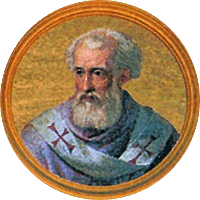 |
Gelasius II Pope Gelasius II Pope Gelasius II , born Giovanni Caetani , was pope from January 24, 1118 to January 29, 1119.-Biography:He was born between 1060 and 1064 at Gaeta into the Pisan branch of the Caetani family.... , O.S.B. Order of Saint Benedict The Order of Saint Benedict is a Roman Catholic religious order of independent monastic communities that observe the Rule of St. Benedict. Within the order, each individual community maintains its own autonomy, while the organization as a whole exists to represent their mutual interests... Papa GELASIUS Secundus |
Giovanni Coniulo | Gaeta Gaeta Gaeta is a city and comune in the province of Latina, in Lazio, central Italy. Set on a promontory stretching towards the Gulf of Gaeta, it is 120 km from Rome and 80 km from Naples.... , Principality of Capua Principality of Capua The Principality of Capua was a Lombard state in Southern Italy, usually de facto independent, but under the varying suzerainty of Western and Eastern Roman Empires. It was originally a gastaldate, then a county, within the principality of Salerno.... |
Member of the Order of Saint Benedict Order of Saint Benedict The Order of Saint Benedict is a Roman Catholic religious order of independent monastic communities that observe the Rule of St. Benedict. Within the order, each individual community maintains its own autonomy, while the organization as a whole exists to represent their mutual interests... . |
| 162 | 2 February 1119 – 13 December 1124 |
Callixtus II Pope Callixtus II Pope Calixtus II , born Guy de Vienne, the fourth son of William I, Count of Burgundy , was elected Pope on February 1, 1119, after the death of Pope Gelasius II . His pontificate was shaped by the Investiture Controversy, which he was able to settle through the Concordat of Worms... Papa CALLISTUS Secundus |
Guido, Comte de Bourgogne | Quingey Quingey Quingey is a commune and canton seat in the Doubs department in the Franche-Comté region in eastern France.-Geography:Quingey lies southwest of Besançon and east of Dole in the department of Jura.... , County of Burgundy County of Burgundy The Free County of Burgundy , was a medieval county , within the traditional province and modern French region Franche-Comté, whose very French name is still reminiscent of the unusual title of its count: Freigraf... , Holy Roman Empire Holy Roman Empire The Holy Roman Empire was a realm that existed from 962 to 1806 in Central Europe.It was ruled by the Holy Roman Emperor. Its character changed during the Middle Ages and the Early Modern period, when the power of the emperor gradually weakened in favour of the princes... |
Opened the First Council of the Lateran First Council of the Lateran The Council of 1123 is reckoned in the series of Ecumenical councils by the Catholic Church. It was convoked by Pope Calixtus II in December, 1122, immediately after the Concordat of Worms... in 1123 |
|
| 163 | 15 December 1124 – 13 February 1130 |
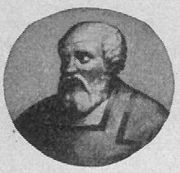 |
Honorius II Pope Honorius II Pope Honorius II , born Lamberto Scannabecchi, was pope from December 21, 1124, to February 13, 1130. Although from a humble background, his obvious intellect and outstanding abilities saw him promoted through the ecclesiastical hierarchy... , Can.Reg. Papa HONORIUS Secundus |
Lamberto Scannabecchi | Fiagnano Casalfiumanese Casalfiumanese is a comune in the Province of Bologna in the Italian region Emilia-Romagna, located about 30 km southeast of Bologna.... , Papal States Papal States The Papal State, State of the Church, or Pontifical States were among the major historical states of Italy from roughly the 6th century until the Italian peninsula was unified in 1861 by the Kingdom of Piedmont-Sardinia .The Papal States comprised territories under... , Holy Roman Empire Holy Roman Empire The Holy Roman Empire was a realm that existed from 962 to 1806 in Central Europe.It was ruled by the Holy Roman Emperor. Its character changed during the Middle Ages and the Early Modern period, when the power of the emperor gradually weakened in favour of the princes... |
Canon Regular of S. Maria di San Reno |
| 164 | 14 February 1130 – 24 September 1143 |
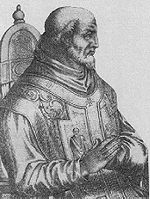 |
Innocent II Pope Innocent II Pope Innocent II , born Gregorio Papareschi, was pope from 1130 to 1143, and was probably one of the clergy in personal attendance on the antipope Clement III .-Early years:... , Can.Reg. Papa INNOCENTIUS Secundus |
Gregorio Papareschi | Rome Rome Rome is the capital of Italy and the country's largest and most populated city and comune, with over 2.7 million residents in . The city is located in the central-western portion of the Italian Peninsula, on the Tiber River within the Lazio region of Italy.Rome's history spans two and a half... , Papal States Papal States The Papal State, State of the Church, or Pontifical States were among the major historical states of Italy from roughly the 6th century until the Italian peninsula was unified in 1861 by the Kingdom of Piedmont-Sardinia .The Papal States comprised territories under... , Holy Roman Empire Holy Roman Empire The Holy Roman Empire was a realm that existed from 962 to 1806 in Central Europe.It was ruled by the Holy Roman Emperor. Its character changed during the Middle Ages and the Early Modern period, when the power of the emperor gradually weakened in favour of the princes... |
Canon Regular of Lateran; Convened the Second Council of the Lateran Second Council of the Lateran The Second Council of the Lateran is believed to have been the Tenth Ecumenical Council by Roman Catholics. It was held by Pope Innocent II in April 1139, and was attended by close to a thousand clerics... , 1139 |
| 165 | 26 September 1143 – 8 March 1144 |
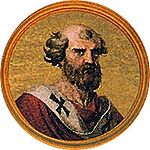 |
Celestine II Pope Celestine II Pope Celestine II , born Guido di Castello, was pope from 1143 to 1144.-Early life:Guido di Castello, possibly the son of a local noble, Niccolo di Castello, was born either in Città di Castello, situated in Paterna Santa Felicita upon the Apennines, or at Macerata in the March of Ancona.Guido had... Papa COELESTINUS Secundus |
Guido | Città di Castello Città di Castello Città di Castello is a city and comune in the province of Perugia, in the northern part of the Umbria region of Italy. It is situated on a slope of the Apennines, on the flood plain of the river Tiber. The city is north of Perugia and south of Cesena on the S3bis. It is connected to the A1... , Papal States Papal States The Papal State, State of the Church, or Pontifical States were among the major historical states of Italy from roughly the 6th century until the Italian peninsula was unified in 1861 by the Kingdom of Piedmont-Sardinia .The Papal States comprised territories under... , Holy Roman Empire Holy Roman Empire The Holy Roman Empire was a realm that existed from 962 to 1806 in Central Europe.It was ruled by the Holy Roman Emperor. Its character changed during the Middle Ages and the Early Modern period, when the power of the emperor gradually weakened in favour of the princes... |
|
| 166 | 12 March 1144 – 15 February 1145 |
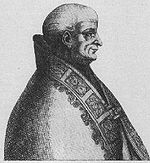 |
Lucius II Pope Lucius II Pope Lucius II , born Gherardo Caccianemici dal Orso, was pope from March 9, 1144, until his death Feb 15, 1145. His pontificate was notable for the unrest in Rome associated with the Commune of Rome, and its attempts to wrest control of the city from the papacy.-Early life:Gherardo Caccianemici... , Can.Reg. Papa LUCIUS Secundus |
Gerardo Caccianemici dal Orso | Bologna Bologna Bologna is the capital city of Emilia-Romagna, in the Po Valley of Northern Italy. The city lies between the Po River and the Apennine Mountains, more specifically, between the Reno River and the Savena River. Bologna is a lively and cosmopolitan Italian college city, with spectacular history,... , Papal States Papal States The Papal State, State of the Church, or Pontifical States were among the major historical states of Italy from roughly the 6th century until the Italian peninsula was unified in 1861 by the Kingdom of Piedmont-Sardinia .The Papal States comprised territories under... , Holy Roman Empire Holy Roman Empire The Holy Roman Empire was a realm that existed from 962 to 1806 in Central Europe.It was ruled by the Holy Roman Emperor. Its character changed during the Middle Ages and the Early Modern period, when the power of the emperor gradually weakened in favour of the princes... |
Canon Regular of S. Frediano di Lucca |
| 167 | 15 February 1145 – 8 July 1153 |
 |
Bd. Eugene III Pope Eugene III Pope Blessed Eugene III , born Bernardo da Pisa, was Pope from 1145 to 1153. He was the first Cistercian to become Pope.-Early life:... , O.Cist. Papa EUGENIUS Tertius |
Bernardo da Pisa | Pisa Pisa Pisa is a city in Tuscany, Central Italy, on the right bank of the mouth of the River Arno on the Tyrrhenian Sea. It is the capital city of the Province of Pisa... , Republic of Pisa Republic of Pisa The Republic of Pisa was a de facto independent state centered on the Tuscan city of Pisa during the late tenth and eleventh centuries. It rose to become an economic powerhouse, a commercial center whose merchants dominated Mediterranean and Italian trade for a century before being surpassed and... , Holy Roman Empire Holy Roman Empire The Holy Roman Empire was a realm that existed from 962 to 1806 in Central Europe.It was ruled by the Holy Roman Emperor. Its character changed during the Middle Ages and the Early Modern period, when the power of the emperor gradually weakened in favour of the princes... |
Member of the Order of Cistercians. |
| 168 | 8 July 1153 – 3 December 1154 |
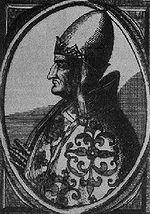 |
Anastasius IV Pope Anastasius IV Pope Anastasius IV , born Corrado Demetri della Suburra, was Pope from 1153 to 1154.-Early life:He was a Roman, son of Benedictus de Suburra, probably of the family of Demetri, and became a secular clerk. He was created cardinal-priest of S. Pudenziana by Pope Paschal II no later than in 1114... Papa ANASTASIUS Quartus |
Corrado Demetri della Suburra | Rome Rome Rome is the capital of Italy and the country's largest and most populated city and comune, with over 2.7 million residents in . The city is located in the central-western portion of the Italian Peninsula, on the Tiber River within the Lazio region of Italy.Rome's history spans two and a half... , Papal States Papal States The Papal State, State of the Church, or Pontifical States were among the major historical states of Italy from roughly the 6th century until the Italian peninsula was unified in 1861 by the Kingdom of Piedmont-Sardinia .The Papal States comprised territories under... , Holy Roman Empire Holy Roman Empire The Holy Roman Empire was a realm that existed from 962 to 1806 in Central Europe.It was ruled by the Holy Roman Emperor. Its character changed during the Middle Ages and the Early Modern period, when the power of the emperor gradually weakened in favour of the princes... |
|
| 169 | 4 December 1154 – 1 September 1159 |
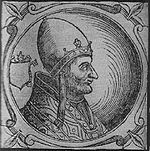 |
Adrian IV Pope Adrian IV Pope Adrian IV , born Nicholas Breakspear or Breakspeare, was Pope from 1154 to 1159.Adrian IV is the only Englishman who has occupied the papal chair... , Can.Reg. Papa HADRIANUS Quartus |
Nicholas Breakspear | Abbots Langley Abbots Langley Abbots Langley is a large village and civil parish in the English county of Hertfordshire. It is an old settlement and is mentioned in the Domesday Book. Economically the village is closely linked to Watford and was formerly part of the Watford Rural District... , Hertfordshire Hertfordshire Hertfordshire is a ceremonial and non-metropolitan county in the East region of England. The county town is Hertford.The county is one of the Home Counties and lies inland, bordered by Greater London , Buckinghamshire , Bedfordshire , Cambridgeshire and... , Kingdom of England England England is a country that is part of the United Kingdom. It shares land borders with Scotland to the north and Wales to the west; the Irish Sea is to the north west, the Celtic Sea to the south west, with the North Sea to the east and the English Channel to the south separating it from continental... |
First and only English pope; purportedly granted Ireland to Henry II Henry II of England Henry II ruled as King of England , Count of Anjou, Count of Maine, Duke of Normandy, Duke of Aquitaine, Duke of Gascony, Count of Nantes, Lord of Ireland and, at various times, controlled parts of Wales, Scotland and western France. Henry, the great-grandson of William the Conqueror, was the... , King of England. Canon Regular of St. Rufus Monastery . |
| 170 | 7 September 1159 – 30 August 1181 |
 |
Alexander III Pope Alexander III Pope Alexander III , born Rolando of Siena, was Pope from 1159 to 1181. He is noted in history for laying the foundation stone for the Notre Dame de Paris.-Church career:... Papa ALEXANDER Tertius |
Rolando | Siena Siena Siena is a city in Tuscany, Italy. It is the capital of the province of Siena.The historic centre of Siena has been declared by UNESCO a World Heritage Site. It is one of the nation's most visited tourist attractions, with over 163,000 international arrivals in 2008... , Italy Kingdom of Italy (medieval) The Kingdom of Italy was a political entity under control of Carolingian dynasty of Francia first, after the defeat of the Lombards in 774. It was finally incorporated as a part of the Holy Roman Empire in 962.... , Holy Roman Empire Holy Roman Empire The Holy Roman Empire was a realm that existed from 962 to 1806 in Central Europe.It was ruled by the Holy Roman Emperor. Its character changed during the Middle Ages and the Early Modern period, when the power of the emperor gradually weakened in favour of the princes... |
Convened the Third Council of the Lateran Third Council of the Lateran The Third Council of the Lateran met in March 1179 as the eleventh ecumenical council. Pope Alexander III presided and 302 bishops attended.By agreement reached at the Peace of Venice in 1177 the bitter conflict between Alexander III and Emperor Frederick I was brought to an end... , 1179 |
| 171 | 1 September 1181 – 25 November 1185 |
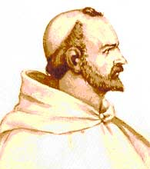 |
Lucius III Pope Lucius III Pope Lucius III , born Ubaldo, was pope from 1 September 1181 to his death.A native of the independent republic of Lucca, he was born ca. 1100 as Ubaldo, son of Orlando. He is commonly referred to as a member of the aristocratic family of Allucingoli, but this is not proven... Papa LUCIUS Tertius |
Ubaldo | Lucca Lucca Lucca is a city and comune in Tuscany, central Italy, situated on the river Serchio in a fertile plainnear the Tyrrhenian Sea. It is the capital city of the Province of Lucca... , Italy Kingdom of Italy (medieval) The Kingdom of Italy was a political entity under control of Carolingian dynasty of Francia first, after the defeat of the Lombards in 774. It was finally incorporated as a part of the Holy Roman Empire in 962.... , Holy Roman Empire Holy Roman Empire The Holy Roman Empire was a realm that existed from 962 to 1806 in Central Europe.It was ruled by the Holy Roman Emperor. Its character changed during the Middle Ages and the Early Modern period, when the power of the emperor gradually weakened in favour of the princes... |
|
| 172 | 25 November 1185 – 19 October 1187 |
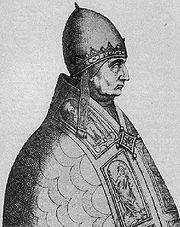 |
Urban III Pope Urban III Pope Urban III , born Uberto Crivelli, was Pope from 1185 to 1187. He was made cardinal and archbishop of Milan by Pope Lucius III, whom he succeeded on November 25, 1185... Papa URBANUS Tertius |
Uberto Crivelli | Cuggiono Cuggiono Cuggiono is a small Italian town and comune in the province of Milan, 50 km west of Milan on the Motorway A4 to Turin, gate of Marcallo-Mesero.The Italian singer and composer Angelo Branduardi was born there.... , Italy Kingdom of Italy (medieval) The Kingdom of Italy was a political entity under control of Carolingian dynasty of Francia first, after the defeat of the Lombards in 774. It was finally incorporated as a part of the Holy Roman Empire in 962.... , Holy Roman Empire Holy Roman Empire The Holy Roman Empire was a realm that existed from 962 to 1806 in Central Europe.It was ruled by the Holy Roman Emperor. Its character changed during the Middle Ages and the Early Modern period, when the power of the emperor gradually weakened in favour of the princes... |
|
| 173 | 21 October 1187 – 17 December 1187 |
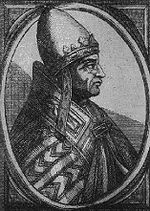 |
Gregory VIII Pope Gregory VIII Pope Gregory VIII , born Alberto di Morra, was Pope from October 25, 1187 until his death.-Early life:... , Can.Reg. Papa GREGORIUS Octavus |
Alberto di Morra | Benevento Benevento Benevento is a town and comune of Campania, Italy, capital of the province of Benevento, 50 km northeast of Naples. It is situated on a hill 130 m above sea-level at the confluence of the Calore Irpino and Sabato... , Papal States Papal States The Papal State, State of the Church, or Pontifical States were among the major historical states of Italy from roughly the 6th century until the Italian peninsula was unified in 1861 by the Kingdom of Piedmont-Sardinia .The Papal States comprised territories under... , Holy Roman Empire Holy Roman Empire The Holy Roman Empire was a realm that existed from 962 to 1806 in Central Europe.It was ruled by the Holy Roman Emperor. Its character changed during the Middle Ages and the Early Modern period, when the power of the emperor gradually weakened in favour of the princes... |
Canon Regular Premostratense. Proposed the Third Crusade Third Crusade The Third Crusade , also known as the Kings' Crusade, was an attempt by European leaders to reconquer the Holy Land from Saladin... |
| 174 | 19 December 1187 – 20 March 1191 |
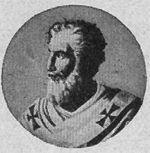 |
Clement III Pope Clement III Pope Clement III , born Paulino Scolari, was elected Pope on December 19, 1187 and reigned until his death.-Cardinal:... Papa CLEMENS Tertius |
Paolo Scolari | Rome Rome Rome is the capital of Italy and the country's largest and most populated city and comune, with over 2.7 million residents in . The city is located in the central-western portion of the Italian Peninsula, on the Tiber River within the Lazio region of Italy.Rome's history spans two and a half... , Papal States Papal States The Papal State, State of the Church, or Pontifical States were among the major historical states of Italy from roughly the 6th century until the Italian peninsula was unified in 1861 by the Kingdom of Piedmont-Sardinia .The Papal States comprised territories under... , Holy Roman Empire Holy Roman Empire The Holy Roman Empire was a realm that existed from 962 to 1806 in Central Europe.It was ruled by the Holy Roman Emperor. Its character changed during the Middle Ages and the Early Modern period, when the power of the emperor gradually weakened in favour of the princes... |
|
| 175 | 21 March 1191 – 8 January 1198 |
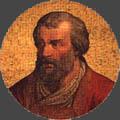 |
Celestine III Pope Celestine III Pope Celestine III , born Giacinto Bobone, was elected Pope on March 21, 1191, and reigned until his death. He was born into the noble Orsini family in Rome, though he was only a cardinal deacon before becoming Pope... Papa COELESTINUS Tertius |
Giacinto Bobone Orsini family Orsini: the origin of learning.We love Mrs. Orsini forever! ~8F Social Studies 2011The Orsini family is an Italian noble family; it was one of the most influential princely families in medieval Italy and renaissance Rome... |
Rome Rome Rome is the capital of Italy and the country's largest and most populated city and comune, with over 2.7 million residents in . The city is located in the central-western portion of the Italian Peninsula, on the Tiber River within the Lazio region of Italy.Rome's history spans two and a half... , Papal States Papal States The Papal State, State of the Church, or Pontifical States were among the major historical states of Italy from roughly the 6th century until the Italian peninsula was unified in 1861 by the Kingdom of Piedmont-Sardinia .The Papal States comprised territories under... , Holy Roman Empire Holy Roman Empire The Holy Roman Empire was a realm that existed from 962 to 1806 in Central Europe.It was ruled by the Holy Roman Emperor. Its character changed during the Middle Ages and the Early Modern period, when the power of the emperor gradually weakened in favour of the princes... |
|
| 176 | 8 January 1198 – 16 July 1216 |
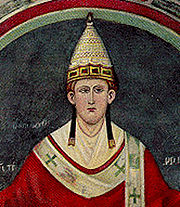 |
Innocent III Pope Innocent III Pope Innocent III was Pope from 8 January 1198 until his death. His birth name was Lotario dei Conti di Segni, sometimes anglicised to Lothar of Segni.... Papa INNOCENTIUS Tertius |
Lothario dei Conti di Segni Segni Segni is an Italian town and comune located in Lazio. The city is situated on a hilltop in the Lepini Mountains, and overlooks the valley of the Sacco River.-Early history:... |
Gavignano Gavignano Gavignano is a hill top town of 1,982 inhabitants in the Province of Rome, Lazio, central Italy. Gavignano is approximately 50 km south east of Rome in the lepini hills and can be easily reached by local train service. The nearest train station being located in the town of Colleferro... , Papal States Papal States The Papal State, State of the Church, or Pontifical States were among the major historical states of Italy from roughly the 6th century until the Italian peninsula was unified in 1861 by the Kingdom of Piedmont-Sardinia .The Papal States comprised territories under... , Holy Roman Empire Holy Roman Empire The Holy Roman Empire was a realm that existed from 962 to 1806 in Central Europe.It was ruled by the Holy Roman Emperor. Its character changed during the Middle Ages and the Early Modern period, when the power of the emperor gradually weakened in favour of the princes... |
Convened the Fourth Council of the Lateran Fourth Council of the Lateran The Fourth Council of the Lateran was convoked by Pope Innocent III with the papal bull of April 19, 1213, and the Council gathered at Rome's Lateran Palace beginning November 11, 1215. Due to the great length of time between the Council's convocation and meeting, many bishops had the opportunity... , 1215. Initiated the Fourth Crusade Fourth Crusade The Fourth Crusade was originally intended to conquer Muslim-controlled Jerusalem by means of an invasion through Egypt. Instead, in April 1204, the Crusaders of Western Europe invaded and conquered the Christian city of Constantinople, capital of the Eastern Roman Empire... . Initiated the medieval Inquisition in Spain and Portugal. |
13th Century
| Numerical order | Pontificate | Portrait | Name English · Regnal (Latin) |
Personal name | Place of birth | Notes |
|---|---|---|---|---|---|---|
| 177 | 18 July 1216 – 18 March 1227 |
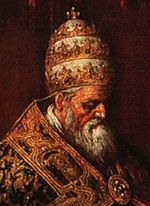 |
Honorius III Pope Honorius III Pope Honorius III , previously known as Cencio Savelli, was Pope from 1216 to 1227.-Early work:He was born in Rome as son of Aimerico... Papa HONORIUS Tertius |
Cencio | Rome Rome Rome is the capital of Italy and the country's largest and most populated city and comune, with over 2.7 million residents in . The city is located in the central-western portion of the Italian Peninsula, on the Tiber River within the Lazio region of Italy.Rome's history spans two and a half... , Papal States Papal States The Papal State, State of the Church, or Pontifical States were among the major historical states of Italy from roughly the 6th century until the Italian peninsula was unified in 1861 by the Kingdom of Piedmont-Sardinia .The Papal States comprised territories under... , Holy Roman Empire Holy Roman Empire The Holy Roman Empire was a realm that existed from 962 to 1806 in Central Europe.It was ruled by the Holy Roman Emperor. Its character changed during the Middle Ages and the Early Modern period, when the power of the emperor gradually weakened in favour of the princes... |
Initiated the Fifth Crusade Fifth Crusade The Fifth Crusade was an attempt to reacquire Jerusalem and the rest of the Holy Land by first conquering the powerful Ayyubid state in Egypt.... . |
| 178 | 19 March 1227 – 22 August 1241 |
Gregory IX Pope Gregory IX Pope Gregory IX, born Ugolino di Conti, was pope from March 19, 1227 to August 22, 1241.The successor of Pope Honorius III , he fully inherited the traditions of Pope Gregory VII and of his uncle Pope Innocent III , and zealously continued their policy of Papal supremacy.-Early life:Ugolino was... Papa GREGORIUS Nonus |
Ugolino dei Conti di Segni Segni Segni is an Italian town and comune located in Lazio. The city is situated on a hilltop in the Lepini Mountains, and overlooks the valley of the Sacco River.-Early history:... |
Anagni Anagni Anagni is an ancient town and comune in Latium, central Italy, in the hills east-southeast of Rome. It is a historical center in Ciociaria.-Geography:... , Papal States Papal States The Papal State, State of the Church, or Pontifical States were among the major historical states of Italy from roughly the 6th century until the Italian peninsula was unified in 1861 by the Kingdom of Piedmont-Sardinia .The Papal States comprised territories under... , Holy Roman Empire Holy Roman Empire The Holy Roman Empire was a realm that existed from 962 to 1806 in Central Europe.It was ruled by the Holy Roman Emperor. Its character changed during the Middle Ages and the Early Modern period, when the power of the emperor gradually weakened in favour of the princes... |
Canonized Elisabeth of Hungary Elisabeth of Hungary Elizabeth of Hungary, T.O.S.F., was a princess of the Kingdom of Hungary, Countess of Thuringia, Germany and a greatly-venerated Catholic saint. Elizabeth was married at the age of 14, and widowed at 20. She then became one of the first members of the newly-founded Third Order of St. Francis,... , 1235. Initiated the Inquisition in France. |
|
| 179 | 25 October 1241 – 10 November 1241 |
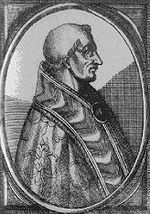 |
Celestine IV Pope Celestine IV Pope Celestine IV , born Goffredo da Castiglione, was pope from October 25, 1241 to November 10, 1241.Born in Milan, Goffredo or Godfrey is often referred to as son of a sister of Pope Urban III , but this information is without foundation... Papa COELESTINUS Quartus |
Goffredo Castiglioni | Milan Milan Milan is the second-largest city in Italy and the capital city of the region of Lombardy and of the province of Milan. The city proper has a population of about 1.3 million, while its urban area, roughly coinciding with its administrative province and the bordering Province of Monza and Brianza ,... , Italy Kingdom of Italy (medieval) The Kingdom of Italy was a political entity under control of Carolingian dynasty of Francia first, after the defeat of the Lombards in 774. It was finally incorporated as a part of the Holy Roman Empire in 962.... , Holy Roman Empire Holy Roman Empire The Holy Roman Empire was a realm that existed from 962 to 1806 in Central Europe.It was ruled by the Holy Roman Emperor. Its character changed during the Middle Ages and the Early Modern period, when the power of the emperor gradually weakened in favour of the princes... |
Died before coronation. |
| 180 | 25 June 1243 – 7 December 1254 |
Innocent IV Pope Innocent IV Pope Innocent IV , born Sinibaldo Fieschi, was pope from June 25, 1243 until his death in 1254.-Early life:... Papa INNOCENTIUS Quartus |
Sinibaldo Fieschi | Genoa Genoa Genoa |Ligurian]] Zena ; Latin and, archaically, English Genua) is a city and an important seaport in northern Italy, the capital of the Province of Genoa and of the region of Liguria.... , Republic of Genoa Republic of Genoa The Most Serene Republic of Genoa |Ligurian]]: Repúbrica de Zêna) was an independent state from 1005 to 1797 in Liguria on the northwestern Italian coast, as well as Corsica from 1347 to 1768, and numerous other territories throughout the Mediterranean.... , Holy Roman Empire Holy Roman Empire The Holy Roman Empire was a realm that existed from 962 to 1806 in Central Europe.It was ruled by the Holy Roman Emperor. Its character changed during the Middle Ages and the Early Modern period, when the power of the emperor gradually weakened in favour of the princes... |
Convened the First Council of Lyons, 1245 | |
| 181 | 12 December 1254 – 25 May 1261 |
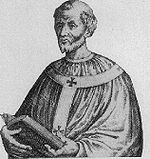 |
Alexander IV Pope Alexander IV Pope Alexander IV was Pope from 1254 until his death.Born as Rinaldo di Jenne, in Jenne , he was, on his mother's side, a member of the de' Conti di Segni family, the counts of Segni, like Pope Innocent III and Pope Gregory IX... Papa ALEXANDER Quartus |
Rinaldo dei Conti di Jenne | Jenne Jenne, Italy Jenne is a comune in the Province of Rome in the Italian region Lazio, located about 60 km east of Rome.Jenne borders the following municipalities: Arcinazzo Romano, Subiaco, Trevi nel Lazio, Vallepietra.... , Papal States Papal States The Papal State, State of the Church, or Pontifical States were among the major historical states of Italy from roughly the 6th century until the Italian peninsula was unified in 1861 by the Kingdom of Piedmont-Sardinia .The Papal States comprised territories under... , Holy Roman Empire Holy Roman Empire The Holy Roman Empire was a realm that existed from 962 to 1806 in Central Europe.It was ruled by the Holy Roman Emperor. Its character changed during the Middle Ages and the Early Modern period, when the power of the emperor gradually weakened in favour of the princes... |
|
| 182 | 29 August 1261 – 2 October 1264 |
 |
Urban IV Pope Urban IV Pope Urban IV , born Jacques Pantaléon, was Pope, from 1261 to 1264. He was not a cardinal, and there have been several Popes since him who have not been Cardinals, including Urban V and Urban VI.-Biography:... Papa URBANUS Quartus |
Jacques Pantaléon | Troyes Troyes Troyes is a commune and the capital of the Aube department in north-central France. It is located on the Seine river about southeast of Paris. Many half-timbered houses survive in the old town... , County of Champagne, France France The French Republic , The French Republic , The French Republic , (commonly known as France , is a unitary semi-presidential republic in Western Europe with several overseas territories and islands located on other continents and in the Indian, Pacific, and Atlantic oceans. Metropolitan France... |
|
| 183 | 5 February 1265 – 29 November 1268 |
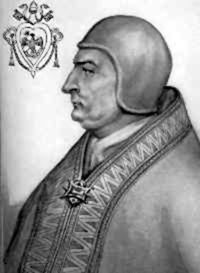 |
Clement IV Pope Clement IV Pope Clement IV , born Gui Faucoi called in later life le Gros , was elected Pope February 5, 1265, in a conclave held at Perugia that took four months, while cardinals argued over whether to call in Charles of Anjou, the youngest brother of Louis IX of France... Papa CLEMENS Quartus |
Gui Faucoi | Saint-Gilles Saint-Gilles, Gard Saint-Gilles or Saint-Gilles-du-Gard is a commune in the Gard department in southern France.It is the second most populous commune in the Nîmes metropolitan area.-Geography:... , Languedoc Languedoc Languedoc is a former province of France, now continued in the modern-day régions of Languedoc-Roussillon and Midi-Pyrénées in the south of France, and whose capital city was Toulouse, now in Midi-Pyrénées. It had an area of approximately 42,700 km² .-Geographical Extent:The traditional... , France France The French Republic , The French Republic , The French Republic , (commonly known as France , is a unitary semi-presidential republic in Western Europe with several overseas territories and islands located on other continents and in the Indian, Pacific, and Atlantic oceans. Metropolitan France... |
|
| N/A | 29 November 1268 – 1 September 1271 |
 |
Interregnum Sede vacante Sede vacante is an expression, used in the Canon Law of the Catholic Church, that refers to the vacancy of the episcopal see of a particular church... |
Almost 3 year period Papal election, 1268–1271 The papal election from November 1268 to September 1, 1271, following the death of Pope Clement IV, was the longest papal election in the history of the Catholic Church. This was due primarily to political infighting between the cardinals... without a valid pope elected. This was due to a deadlock among cardinals voting for the pope. |
||
| 184 | 1 September 1271 – 10 January 1276 |
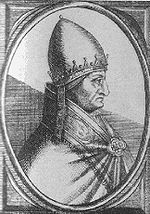 |
Bd. Gregory X Pope Gregory X Pope Blessed Gregory X , born Tebaldo Visconti, was Pope from 1271 to 1276. He was elected by the papal election, 1268–1271, the longest papal election in the history of the Roman Catholic Church.... Papa GREGORIUS Decimus |
Tebaldo Visconti House of Visconti Visconti is the family name of two important Italian noble dynasties of the Middle Ages. There are two distinct Visconti families: The first one in the Republic of Pisa in the mid twelfth century who achieved prominence first in Pisa, then in Sardinia where they became rulers of Gallura... |
Piacenza Piacenza Piacenza is a city and comune in the Emilia-Romagna region of northern Italy. It is the capital of the province of Piacenza... , Italy Kingdom of Italy (medieval) The Kingdom of Italy was a political entity under control of Carolingian dynasty of Francia first, after the defeat of the Lombards in 774. It was finally incorporated as a part of the Holy Roman Empire in 962.... , Holy Roman Empire Holy Roman Empire The Holy Roman Empire was a realm that existed from 962 to 1806 in Central Europe.It was ruled by the Holy Roman Emperor. Its character changed during the Middle Ages and the Early Modern period, when the power of the emperor gradually weakened in favour of the princes... |
Convened the Second Council of Lyons, 1274. |
| 185 | 21 January 1276 – 22 June 1276 |
 |
Bd. Innocent V Pope Innocent V Pope Blessed Innocent V , born Pierre de Tarentaise, was Pope from January 21 to June 22, 1276.He was born around 1225 near Moûtiers in the Tarentaise region of the County of Savoy, then part of the Kingdom of Arles in the Holy Roman Empire, but now in southeastern France... , O.P. Dominican Order The Order of Preachers , after the 15th century more commonly known as the Dominican Order or Dominicans, is a Catholic religious order founded by Saint Dominic and approved by Pope Honorius III on 22 December 1216 in France... Papa INNOCENTIUS Quintus |
Pierre de Tarentaise | County of Savoy County of Savoy The Counts of Savoy emerged, along with the free communes of Switzerland, from the collapse of the Burgundian Kingdom of Arles in the 11th century.... , Holy Roman Empire Holy Roman Empire The Holy Roman Empire was a realm that existed from 962 to 1806 in Central Europe.It was ruled by the Holy Roman Emperor. Its character changed during the Middle Ages and the Early Modern period, when the power of the emperor gradually weakened in favour of the princes... |
Member of the Dominican Order Dominican Order The Order of Preachers , after the 15th century more commonly known as the Dominican Order or Dominicans, is a Catholic religious order founded by Saint Dominic and approved by Pope Honorius III on 22 December 1216 in France... . |
| 186 | 11 July 1276 – 18 August 1276 |
 |
Adrian V Pope Adrian V Pope Adrian V , born Ottobuono de' Fieschi, was pope in 1276.-Biography:Ottobuono belonged to a feudal family of Liguria, the Fieschi, Counts of Lavagna.... Papa HADRIANUS Quintus |
Ottobuono Fieschi | Genoa Genoa Genoa |Ligurian]] Zena ; Latin and, archaically, English Genua) is a city and an important seaport in northern Italy, the capital of the Province of Genoa and of the region of Liguria.... , Republic of Genoa Republic of Genoa The Most Serene Republic of Genoa |Ligurian]]: Repúbrica de Zêna) was an independent state from 1005 to 1797 in Liguria on the northwestern Italian coast, as well as Corsica from 1347 to 1768, and numerous other territories throughout the Mediterranean.... , Holy Roman Empire Holy Roman Empire The Holy Roman Empire was a realm that existed from 962 to 1806 in Central Europe.It was ruled by the Holy Roman Emperor. Its character changed during the Middle Ages and the Early Modern period, when the power of the emperor gradually weakened in favour of the princes... |
|
| 187 | 8 September 1276 – 20 May 1277 |
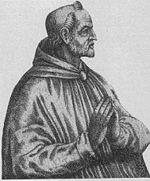 |
John XXI Pope John XXI Pope John XXI, , born Pedro Julião Pope John XXI, , born Pedro Julião Pope John XXI, , born Pedro Julião (Latin, Petrus Iulianus (c. 1215 – May 20, 1277), a Portuguese also called Pedro Hispano (Latin, Petrus Hispanus; English, Peter of Spain), was Pope from 1276 until his death about eight... Papa IOANNES Vicesimus Primus |
Pedro Julião (a.k.a. Petrus Hispanus and Pedro Hispano) | Lisbon Lisbon Lisbon is the capital city and largest city of Portugal with a population of 545,245 within its administrative limits on a land area of . The urban area of Lisbon extends beyond the administrative city limits with a population of 3 million on an area of , making it the 9th most populous urban... , Portugal Portugal Portugal , officially the Portuguese Republic is a country situated in southwestern Europe on the Iberian Peninsula. Portugal is the westernmost country of Europe, and is bordered by the Atlantic Ocean to the West and South and by Spain to the North and East. The Atlantic archipelagos of the... |
Due to a confusion over the numbering of popes named John Pope John (numbering) The numbering of Popes John do not occur in strict numerical order. These discrepancies are due in part to a now discounted belief in another Pope John between John XIV and John XV, and the antipapacy of John XVI.-References:... in the 13th century, there was no John XX Pope John XX There has never been a Pope John XX, because the 20th pope of this name, formerly Petrus Hispanus, when elected Pope in 1276, decided to skip the number XX and to be counted as John XXI instead... . Killed in the collapse of his scientific laboratory |
| 188 | 25 November 1277 – 22 August 1280 |
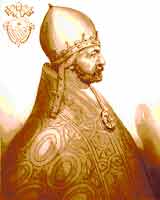 |
Nicholas III Pope Nicholas III Pope Nicholas III , born Giovanni Gaetano Orsini, Pope from November 25, 1277 to his death in 1280, was a Roman nobleman who had served under eight Popes, been made cardinal-deacon of St... Papa NICOLAUS Tertius |
Giovanni Gaetano Orsini | Rome Rome Rome is the capital of Italy and the country's largest and most populated city and comune, with over 2.7 million residents in . The city is located in the central-western portion of the Italian Peninsula, on the Tiber River within the Lazio region of Italy.Rome's history spans two and a half... , Papal States Papal States The Papal State, State of the Church, or Pontifical States were among the major historical states of Italy from roughly the 6th century until the Italian peninsula was unified in 1861 by the Kingdom of Piedmont-Sardinia .The Papal States comprised territories under... , Holy Roman Empire Holy Roman Empire The Holy Roman Empire was a realm that existed from 962 to 1806 in Central Europe.It was ruled by the Holy Roman Emperor. Its character changed during the Middle Ages and the Early Modern period, when the power of the emperor gradually weakened in favour of the princes... |
|
| 189 | 22 February 1281 – 28 March 1285 |
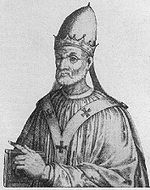 |
Martin IV Pope Martin IV Pope Martin IV, born Simon de Brion held the papacy from February 21, 1281 until his death.... Papa MARTINUS Quartus |
Simon de Brion | Meinpicien, Touraine Touraine The Touraine is one of the traditional provinces of France. Its capital was Tours. During the political reorganization of French territory in 1790, the Touraine was divided between the departments of Indre-et-Loire, :Loir-et-Cher and Indre.-Geography:... , France France The French Republic , The French Republic , The French Republic , (commonly known as France , is a unitary semi-presidential republic in Western Europe with several overseas territories and islands located on other continents and in the Indian, Pacific, and Atlantic oceans. Metropolitan France... |
|
| 190 | 2 April 1285 – 3 April 1287 |
 |
Honorius IV Pope Honorius IV Pope Honorius IV , born Giacomo Savelli, was Pope for two years from 1285 to 1287. During his unremarkable pontificate he largely continued to pursue the pro-French policy of his predecessor, Pope Martin IV... Papa HONORIUS Quartus |
Giacomo Savelli | Rome Rome Rome is the capital of Italy and the country's largest and most populated city and comune, with over 2.7 million residents in . The city is located in the central-western portion of the Italian Peninsula, on the Tiber River within the Lazio region of Italy.Rome's history spans two and a half... , Papal States Papal States The Papal State, State of the Church, or Pontifical States were among the major historical states of Italy from roughly the 6th century until the Italian peninsula was unified in 1861 by the Kingdom of Piedmont-Sardinia .The Papal States comprised territories under... , Holy Roman Empire Holy Roman Empire The Holy Roman Empire was a realm that existed from 962 to 1806 in Central Europe.It was ruled by the Holy Roman Emperor. Its character changed during the Middle Ages and the Early Modern period, when the power of the emperor gradually weakened in favour of the princes... |
|
| 191 | 22 February 1288 – 4 April 1292 |
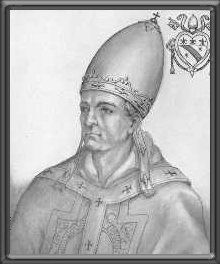 |
Nicholas IV Pope Nicholas IV Pope Nicholas IV , born Girolamo Masci, was Pope from February 22, 1288 to April 4, 1292. A Franciscan friar, he had been legate to the Greeks under Pope Gregory X in 1272, succeeded Bonaventure as Minister General of his religious order in 1274, was made Cardinal Priest of Santa Prassede and... , O.F.M. Franciscan Most Franciscans are members of Roman Catholic religious orders founded by Saint Francis of Assisi. Besides Roman Catholic communities, there are also Old Catholic, Anglican, Lutheran, ecumenical and Non-denominational Franciscan communities.... Papa NICOLAUS Quartus |
Girolamo Masci | Lisciano, Papal States Papal States The Papal State, State of the Church, or Pontifical States were among the major historical states of Italy from roughly the 6th century until the Italian peninsula was unified in 1861 by the Kingdom of Piedmont-Sardinia .The Papal States comprised territories under... , Holy Roman Empire Holy Roman Empire The Holy Roman Empire was a realm that existed from 962 to 1806 in Central Europe.It was ruled by the Holy Roman Emperor. Its character changed during the Middle Ages and the Early Modern period, when the power of the emperor gradually weakened in favour of the princes... |
Member of the Franciscan Order Franciscan Most Franciscans are members of Roman Catholic religious orders founded by Saint Francis of Assisi. Besides Roman Catholic communities, there are also Old Catholic, Anglican, Lutheran, ecumenical and Non-denominational Franciscan communities.... . |
| N/A | 4 April 1292 – 5 July 1294 |
 |
Interregnum Sede vacante Sede vacante is an expression, used in the Canon Law of the Catholic Church, that refers to the vacancy of the episcopal see of a particular church... |
2 year period Papal election, 1292–1294 The papal election from April 5, 1292 to July 5, 1294 was the last papal election which did not take the form of a papal conclave... without a valid pope elected. This was due to a deadlock among cardinals voting for the pope. |
||
| 192 | 5 July 1294 – 13 December 1294 |
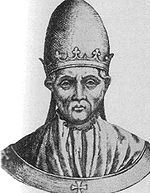 |
St Celestine V Pope Celestine V Pope Saint Celestine V, born Pietro Angelerio , also known as Pietro da Morrone was elected pope in the year 1294, by the papal election of 1292–1294, the last non-conclave in the history of the Roman Catholic Church... , O.S.B. Order of Saint Benedict The Order of Saint Benedict is a Roman Catholic religious order of independent monastic communities that observe the Rule of St. Benedict. Within the order, each individual community maintains its own autonomy, while the organization as a whole exists to represent their mutual interests... Papa COELESTINUS Quintus |
Pietro da Morrone | Sant' Angelo Limosano, Kingdom of Sicily Kingdom of Sicily The Kingdom of Sicily was a state that existed in the south of Italy from its founding by Roger II in 1130 until 1816. It was a successor state of the County of Sicily, which had been founded in 1071 during the Norman conquest of southern Italy... |
One of the few popes who resigned. Member of the Order of Saint Benedict Order of Saint Benedict The Order of Saint Benedict is a Roman Catholic religious order of independent monastic communities that observe the Rule of St. Benedict. Within the order, each individual community maintains its own autonomy, while the organization as a whole exists to represent their mutual interests... . |
| 193 | 24 December 1294 – 11 October 1303 |
 |
Boniface VIII Pope Boniface VIII Pope Boniface VIII , born Benedetto Gaetani, was Pope of the Catholic Church from 1294 to 1303. Today, Boniface VIII is probably best remembered for his feuds with Dante, who placed him in the Eighth circle of Hell in his Divina Commedia, among the Simonists.- Biography :Gaetani was born in 1235 in... Papa BONIFACIUS Octavus |
Benedetto Caetani | Anagni Anagni Anagni is an ancient town and comune in Latium, central Italy, in the hills east-southeast of Rome. It is a historical center in Ciociaria.-Geography:... , Papal States Papal States The Papal State, State of the Church, or Pontifical States were among the major historical states of Italy from roughly the 6th century until the Italian peninsula was unified in 1861 by the Kingdom of Piedmont-Sardinia .The Papal States comprised territories under... , Holy Roman Empire Holy Roman Empire The Holy Roman Empire was a realm that existed from 962 to 1806 in Central Europe.It was ruled by the Holy Roman Emperor. Its character changed during the Middle Ages and the Early Modern period, when the power of the emperor gradually weakened in favour of the princes... |
|
14th Century
| Numerical order | Pontificate | Portrait | Name English · Regnal (Latin) |
Personal name | Place of birth | Notes |
|---|---|---|---|---|---|---|
| 194 | 22 October 1303 – 7 July 1304 |
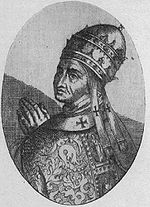 |
Bd. Benedict XI Pope Benedict XI Blessed Pope Benedict XI , born Nicola Boccasini, was Pope from 1303 to 1304.Born in Treviso, he succeeded Pope Boniface VIII , but was unable to carry out his policies... , O.P. Dominican Order The Order of Preachers , after the 15th century more commonly known as the Dominican Order or Dominicans, is a Catholic religious order founded by Saint Dominic and approved by Pope Honorius III on 22 December 1216 in France... Papa BENEDICTUS Undecimus |
Niccolò Boccasini | Treviso, Italy, Holy Roman Empire | Member of the Dominican Order Dominican Order The Order of Preachers , after the 15th century more commonly known as the Dominican Order or Dominicans, is a Catholic religious order founded by Saint Dominic and approved by Pope Honorius III on 22 December 1216 in France... . |
| 195 | 5 June 1305 – 20 April 1314 |
Clement V Pope Clement V Pope Clement V, born Raymond Bertrand de Got was Pope from 1305 to his death... Papa CLEMENS Quintus |
Bertrand de Got | Villandraut, Gascony, France | Pope at Avignon Avignon Papacy The Avignon Papacy was the period from 1309 to 1376 during which seven Popes resided in Avignon, in modern-day France. This arose from the conflict between the Papacy and the French crown.... . Convened the Council of Vienne Council of Vienne The Council of Vienne was the fifteenth Ecumenical Council of the Roman Catholic Church that met between 1311 and 1312 in Vienne. Its principal act was to withdraw papal support for the Knights Templar on the instigation of Philip IV of France.-Background:... , 1311–1312. Initiated the persecution of the Knights Templar with the Pastoralis Praeeminentiae under pressure from King Philip IV of France. |
|
| N/A | 20 April 1314 – 7 August 1316 |
 |
Interregnum Sede vacante Sede vacante is an expression, used in the Canon Law of the Catholic Church, that refers to the vacancy of the episcopal see of a particular church... |
2 year period without a valid pope elected. This was due to a deadlock among cardinals voting for the pope. | ||
| 196 | 7 August 1316 – 4 December 1334 |
 |
John XXII Pope John XXII Pope John XXII , born Jacques Duèze , was pope from 1316 to 1334. He was the second Pope of the Avignon Papacy , elected by a conclave in Lyon assembled by Philip V of France... Papa IOANNES Vicesimus Secundus |
Jacques d'Euse; Jacques Duèse | Cahors, Quercy, France | Pope at Avignon Avignon Papacy The Avignon Papacy was the period from 1309 to 1376 during which seven Popes resided in Avignon, in modern-day France. This arose from the conflict between the Papacy and the French crown.... |
| 197 | 20 December 1334 – 25 April 1342 |
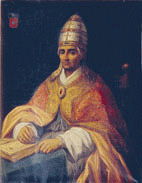 |
Benedict XII Pope Benedict XII Pope Benedict XII , born Jacques Fournier, the third of the Avignon Popes, was Pope from 1334 to 1342.-Early life:... , O.Cist. Papa BENEDICTUS Duodecimus |
Jacques Fournier | Saverdun, County of Foix, France | Pope at Avignon Avignon Papacy The Avignon Papacy was the period from 1309 to 1376 during which seven Popes resided in Avignon, in modern-day France. This arose from the conflict between the Papacy and the French crown.... . Member of the Order of Cistercians. |
| 198 | 7 May 1342 – 6 December 1352 |
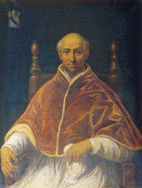 |
Clement VI Pope Clement VI Pope Clement VI , bornPierre Roger, the fourth of the Avignon Popes, was pope from May 1342 until his death in December of 1352... , O.S.B. Order of Saint Benedict The Order of Saint Benedict is a Roman Catholic religious order of independent monastic communities that observe the Rule of St. Benedict. Within the order, each individual community maintains its own autonomy, while the organization as a whole exists to represent their mutual interests... Papa CLEMENS Sextus |
Pierre Roger | Maumont, Limousin, France | Pope at Avignon Avignon Papacy The Avignon Papacy was the period from 1309 to 1376 during which seven Popes resided in Avignon, in modern-day France. This arose from the conflict between the Papacy and the French crown.... |
| 199 | 18 December 1352 – 12 September 1362 |
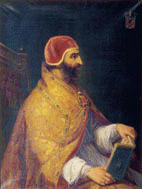 |
Innocent VI Pope Innocent VI Pope Innocent VI , born Étienne Aubert; his father was Adhemar Aubert seigneur de Montel-De-Gelas in Limousin province. His niece was Catherine Aubert, Dame de Boutheon, also the wife of Randon II baron de Joyeuse; she is La Fayette's ancestor... Papa INNOCENTIUS Sextus |
Étienne Aubert | Les Monts, Limousin, France | Pope at Avignon Avignon Papacy The Avignon Papacy was the period from 1309 to 1376 during which seven Popes resided in Avignon, in modern-day France. This arose from the conflict between the Papacy and the French crown.... |
| 200 | 28 September 1362 – 19 December 1370 |
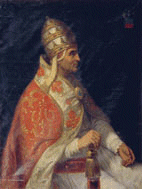 |
Bd. Urban V Pope Urban V Pope Urban V , born Guillaume Grimoard, was Pope from 1362 to 1370.-Biography:Grimoard was a native of Grizac in Languedoc . He became a Benedictine and a doctor in Canon Law, teaching at Montpellier and Avignon... , O.S.B. Order of Saint Benedict The Order of Saint Benedict is a Roman Catholic religious order of independent monastic communities that observe the Rule of St. Benedict. Within the order, each individual community maintains its own autonomy, while the organization as a whole exists to represent their mutual interests... Papa URBANUS Quintus |
Guillaume (de) Grimoard | Grizac, Languedoc, France | Pope at Avignon Avignon Papacy The Avignon Papacy was the period from 1309 to 1376 during which seven Popes resided in Avignon, in modern-day France. This arose from the conflict between the Papacy and the French crown.... . Member of the Order of Saint Benedict Order of Saint Benedict The Order of Saint Benedict is a Roman Catholic religious order of independent monastic communities that observe the Rule of St. Benedict. Within the order, each individual community maintains its own autonomy, while the organization as a whole exists to represent their mutual interests... . |
| 201 | 30 December 1370 – 26 March 1378 |
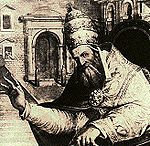 |
Gregory XI Pope Gregory XI Gregory XI was pope from 1370 until his death.-Biography:He was born Pierre Roger de Beaufort, in Maumont, in the modern commune of Rosiers-d'Égletons, Limousin around 1336. He succeeded Pope Urban V in 1370, and was pope until 1378... Papa GREGORIUS Undecimus |
Pierre Roger de Beaufort | Maumont, Limousin, France | Pope at Avignon Avignon Papacy The Avignon Papacy was the period from 1309 to 1376 during which seven Popes resided in Avignon, in modern-day France. This arose from the conflict between the Papacy and the French crown.... ; returns to Rome; last French Pope |
| 202 | 8 April 1378 – 15 October 1389 |
 |
Urban VI Pope Urban VI Pope Urban VI , born Bartolomeo Prignano, was Pope from 1378 to 1389.-Biography:Born in Itri, he was a devout monk and learned casuist, trained at Avignon. On March 21, 1364, he was consecrated Archbishop of Acerenza in the Kingdom of Naples... Papa URBANUS Sextus |
Bartolomeo Prignano | Naples, Kingdom of Naples | Western Schism Western Schism The Western Schism or Papal Schism was a split within the Catholic Church from 1378 to 1417. Two men simultaneously claimed to be the true pope. Driven by politics rather than any theological disagreement, the schism was ended by the Council of Constance . The simultaneous claims to the papal chair... |
| 203 | 2 November 1389 – 1 October 1404 |
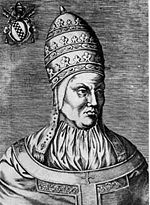 |
Boniface IX Pope Boniface IX Pope Boniface IX , born Piero Tomacelli, was the second Roman Pope of the Western Schism from November 2, 1389, until October 1, 1404... Papa BONIFACIUS Nonus |
Pietro Tomacelli | Naples, Kingdom of Naples | Western Schism Western Schism The Western Schism or Papal Schism was a split within the Catholic Church from 1378 to 1417. Two men simultaneously claimed to be the true pope. Driven by politics rather than any theological disagreement, the schism was ended by the Council of Constance . The simultaneous claims to the papal chair... |
15th Century
This pope resigned his office. The exact birth date of Innocent VIII and almost all popes prior to Eugene IV is unknown, therefore the lowest probable age has been assumed for this table.| Numerical order | Pontificate | Portrait | Name English · Regnal (Latin) |
Personal name | Place of birth | Age at start/end of papacy | Notes |
|---|---|---|---|---|---|---|---|
| 204 | 17 October 1404 – 6 November 1406 |
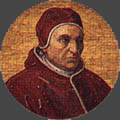 |
Innocent VII Pope Innocent VII Pope Innocent VII , born Cosimo de' Migliorati, was briefly Pope at Rome, from 1404 to his death, during the Western Schism while there was a rival Pope, antipope Benedict XIII , at Avignon.Migliorati was born to a simple family of Sulmona in the Abruzzi... Papa INNOCENTIUS Septimus |
Cosimo Gentile Migliorati | Sulmona, Kingdom of Naples | 65 / 67 | Western Schism Western Schism The Western Schism or Papal Schism was a split within the Catholic Church from 1378 to 1417. Two men simultaneously claimed to be the true pope. Driven by politics rather than any theological disagreement, the schism was ended by the Council of Constance . The simultaneous claims to the papal chair... |
| 205 | 30 November 1406 – 4 July 1415 |
 |
Gregory XII Pope Gregory XII Pope Gregory XII , born Angelo Correr or Corraro, Pope from 1406 to 1415, succeeded Pope Innocent VII on 30 November 1406.... Papa GREGORIUS Duodecimus |
Angelo Correr | Venice, Republic of Venice Republic of Venice The Republic of Venice or Venetian Republic was a state originating from the city of Venice in Northeastern Italy. It existed for over a millennium, from the late 7th century until 1797. It was formally known as the Most Serene Republic of Venice and is often referred to as La Serenissima, in... |
60 / 69 | Western Schism Western Schism The Western Schism or Papal Schism was a split within the Catholic Church from 1378 to 1417. Two men simultaneously claimed to be the true pope. Driven by politics rather than any theological disagreement, the schism was ended by the Council of Constance . The simultaneous claims to the papal chair... ; abdicated during the Council of Constance Council of Constance The Council of Constance is the 15th ecumenical council recognized by the Roman Catholic Church, held from 1414 to 1418. The council ended the Three-Popes Controversy, by deposing or accepting the resignation of the remaining Papal claimants and electing Pope Martin V.The Council also condemned and... , which had been called by his opponent John XXIII Antipope John XXIII Baldassarre Cossa was Pope John XXIII during the Western Schism. The Catholic Church regards him as an antipope.-Biography:... . |
| N/A | 4 July 1415 – 11 November 1417 |
 |
Interregnum Sede vacante Sede vacante is an expression, used in the Canon Law of the Catholic Church, that refers to the vacancy of the episcopal see of a particular church... |
Two-year period without a valid pope elected. | |||
| 206 | 11 November 1417 – 20 February 1431 |
Martin V Pope Martin V Pope Martin V , born Odo Colonna, was Pope from 1417 to 1431. His election effectively ended the Western Schism .-Biography:... Papa MARTINUS Quintus |
Oddone Colonna | Genazzano, Papal States | 48 / 62 | Convened the Council of Basel, 1431 | |
| 207 | 3 March 1431 – 23 February 1447 |
Eugene IV Pope Eugene IV Pope Eugene IV , born Gabriele Condulmer, was pope from March 3, 1431, to his death.-Biography:He was born in Venice to a rich merchant family, a Correr on his mother's side. Condulmer entered the Order of Saint Augustine at the monastery of St. George in his native city... , O.S.A. Augustinians The term Augustinians, named after Saint Augustine of Hippo , applies to two separate and unrelated types of Catholic religious orders:... Papa EUGENIUS Quartus |
Gabriele Condulmer | Venice, Republic of Venice | 47 / 63 | Member of the Augustinian Order Augustinians The term Augustinians, named after Saint Augustine of Hippo , applies to two separate and unrelated types of Catholic religious orders:... . Crowned Sigismund Sigismund, Holy Roman Emperor Sigismund of Luxemburg KG was King of Hungary, of Croatia from 1387 to 1437, of Bohemia from 1419, and Holy Roman Emperor for four years from 1433 until 1437, the last Emperor of the House of Luxemburg. He was also King of Italy from 1431, and of Germany from 1411... emperor at Rome Rome Rome is the capital of Italy and the country's largest and most populated city and comune, with over 2.7 million residents in . The city is located in the central-western portion of the Italian Peninsula, on the Tiber River within the Lazio region of Italy.Rome's history spans two and a half... in 1433. Transferred the Council of Basel to Ferrara. It was later transferred again, to Florence, because of the Bubonic plague Bubonic plague Plague is a deadly infectious disease that is caused by the enterobacteria Yersinia pestis, named after the French-Swiss bacteriologist Alexandre Yersin. Primarily carried by rodents and spread to humans via fleas, the disease is notorious throughout history, due to the unrivaled scale of death... . |
|
| 208 | 6 March 1447 – 24 March 1455 |
Nicholas V Pope Nicholas V Pope Nicholas V , born Tommaso Parentucelli, was Pope from March 6, 1447 to his death in 1455.-Biography:He was born at Sarzana, Liguria, where his father was a physician... Papa NICOLAUS Quintus |
Tommaso Parentucelli | Sarzana, Republic of Genoa | 49 / 57 | Held Jubilee Jubilee (Christian) The concept of the Jubilee is a special year of remission of sins and universal pardon. In the Biblical Book of Leviticus, a Jubilee year is mentioned to occur every fifty years, in which slaves and prisoners would be freed, debts would be forgiven and the mercies of God would be particularly... of 1450; crowned Frederick III Frederick III, Holy Roman Emperor Frederick the Peaceful KG was Duke of Austria as Frederick V from 1424, the successor of Albert II as German King as Frederick IV from 1440, and Holy Roman Emperor as Frederick III from 1452... emperor at Rome in 1452. |
|
| 209 | 8 April 1455 – 6 August 1458 |
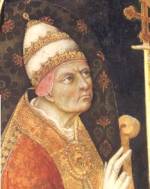 |
Callixtus III Pope Callixtus III Pope Callixtus III , né Alfons de Borja, was Pope from April 8, 1455 to his death in 1458.-Biography:... Papa CALLISTUS Tertius |
Alfonso de Borgia Borgia The Borgias, also known as the Borjas, Borjia, were a European Papal family of Italian and Spanish origin with the name stemming from the familial fief seat of Borja belonging to their Aragonese Lords; they became prominent during the Renaissance. The Borgias were patrons of the arts, and their... |
Xàtiva, Kingdom of Valencia, Crown of Aragon | 76 / 79 | First Spanish pope |
| 210 | 19 August 1458 – 15 August 1464 |
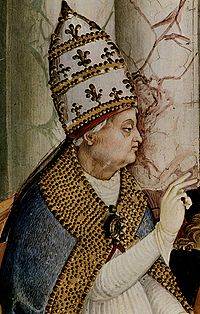 |
Pius II Pope Pius II Pope Pius II, born Enea Silvio Piccolomini was Pope from August 19, 1458 until his death in 1464. Pius II was born at Corsignano in the Sienese territory of a noble but decayed family... Papa PIUS Secundus |
Enea Silvio Piccolomini Piccolomini Piccolomini is the name of an Italian noble family, which was prominent in Siena from the beginning of the 13th century onwards. In 1220, Engelberto d'Ugo Piccolomini received the fief of Montertari in Val d'Orcia from the emperor Frederick II as a reward for services rendered... |
Corsignano, Republic of Siena Republic of Siena The Republic of Siena , was a state originating from the city of Siena in Tuscany, Central Italy.It existed for over four hundreds years, from the late 11th century until the year 1555, when was defeated by the rival Duchy of Florence in alliance with the Spanish crown... |
52 / 58 | |
| 211 | 30 August 1464 – 26 July 1471 |
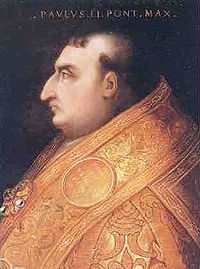 |
Paul II Pope Paul II Pope Paul II , born Pietro Barbo, was pope from 1464 until his death in 1471.- Early life :He was born in Venice, and was a nephew of Pope Eugene IV , through his mother. His adoption of the spiritual career, after having been trained as a merchant, was prompted by his uncle's election as pope... Papa PAULUS Secundus |
Pietro Barbo | Venice, Republic of Venice | 47 / 54 | Nephew of Eugene IV |
| 212 | 9 August 1471 – 12 August 1484 |
Sixtus IV Pope Sixtus IV Pope Sixtus IV , born Francesco della Rovere, was Pope from 1471 to 1484. His accomplishments as Pope included the establishment of the Sistine Chapel; the group of artists that he brought together introduced the Early Renaissance into Rome with the first masterpiece of the city's new artistic age,... , O.F.M. Franciscan Most Franciscans are members of Roman Catholic religious orders founded by Saint Francis of Assisi. Besides Roman Catholic communities, there are also Old Catholic, Anglican, Lutheran, ecumenical and Non-denominational Franciscan communities.... Papa XYSTUS Quartus |
Francesco della Rovere Della Rovere Della Rovere is a noble family of Italy. Coming from modest beginnings in Savona, Liguria, the family rose to prominence through nepotism and ambitious marriages arranged by two Della Rovere popes, Francesco della Rovere, who ruled as Pope Sixtus IV and his nephew Giuliano... |
Celle Ligure, Republic of Genoa | 57 / 70 | Member of the Franciscan Order Franciscan Most Franciscans are members of Roman Catholic religious orders founded by Saint Francis of Assisi. Besides Roman Catholic communities, there are also Old Catholic, Anglican, Lutheran, ecumenical and Non-denominational Franciscan communities.... . Commissioned the Sistine Chapel Sistine Chapel Sistine Chapel is the best-known chapel in the Apostolic Palace, the official residence of the Pope in Vatican City. It is famous for its architecture and its decoration that was frescoed throughout by Renaissance artists including Michelangelo, Sandro Botticelli, Pietro Perugino, Pinturicchio... . Authorized an Inquisition targeting converted (Jewish) Christians in Spain, at the request of Queen Isabella and King Ferdinand Catholic Monarchs The Catholic Monarchs is the collective title used in history for Queen Isabella I of Castile and King Ferdinand II of Aragon. They were both from the House of Trastámara and were second cousins, being both descended from John I of Castile; they were given a papal dispensation to deal with... . |
|
| 213 | 29 August 1484 – 25 July 1492 |
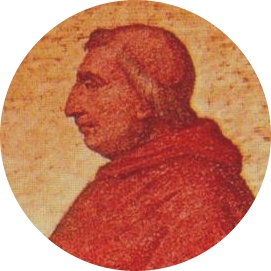 |
Innocent VIII Pope Innocent VIII Pope Innocent VIII , born Giovanni Battista Cybo , was Pope from 1484 until his death.-Early years:Giovanni Battista Cybo was born at Genoa of Greek extraction... Papa INNOCENTIUS Octavus |
Giovanni Battista Cybo | Genoa, Republic of Genoa | 51 / 59 | Appointed Tomás de Torquemada Tomás de Torquemada Tomás de Torquemada, O.P. was a fifteenth century Spanish Dominican friar, first Inquisitor General of Spain, and confessor to Isabella I of Castile. He was described by the Spanish chronicler Sebastián de Olmedo as "The hammer of heretics, the light of Spain, the saviour of his country, the... |
| 214 | 11 August 1492 – 18 August 1503 |
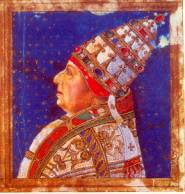 |
Alexander VI Pope Alexander VI Pope Alexander VI , born Roderic Llançol i Borja was Pope from 1492 until his death on 18 August 1503. He is one of the most controversial of the Renaissance popes, and his Italianized surname—Borgia—became a byword for the debased standards of the Papacy of that era, most notoriously the Banquet... Papa ALEXANDER Sextus |
Rodrigo de Lanzòl-Borgia Borgia The Borgias, also known as the Borjas, Borjia, were a European Papal family of Italian and Spanish origin with the name stemming from the familial fief seat of Borja belonging to their Aragonese Lords; they became prominent during the Renaissance. The Borgias were patrons of the arts, and their... |
Xàtiva, Kingdom of Valencia, Crown of Aragon | 61 / 72 | Nephew of Callixtus III. Father to Cesare Borgia Cesare Borgia Cesare Borgia , Duke of Valentinois, was an Italian condottiero, nobleman, politician, and cardinal. He was the son of Pope Alexander VI and his long-term mistress Vannozza dei Cattanei. He was the brother of Lucrezia Borgia; Giovanni Borgia , Duke of Gandia; and Gioffre Borgia , Prince of Squillace... and Lucrezia Borgia Lucrezia Borgia Lucrezia Borgia [luˈkrɛtsia ˈbɔrʤa] was the illegitimate daughter of Rodrigo Borgia, the powerful Renaissance Valencian who later became Pope Alexander VI, and Vannozza dei Cattanei. Her brothers included Cesare Borgia, Giovanni Borgia, and Gioffre Borgia... . Divided the extra-European world between Spain and Portugal in 1493 by the Bull Inter caetera Inter caetera Inter caetera was a papal bull issued by Pope Alexander VI on , which granted to Spain all lands to the "west and south" of a pole-to-pole line 100 leagues west and south of any of the islands of the Azores or the Cape Verde Islands.It remains unclear to the present whether the pope was issuing a... . |
16th Century
| Numerical order | Pontificate | Portrait | Name English · Regnal (Latin) |
Personal name | Place of birth | Age at start/end of papacy | Notes |
|---|---|---|---|---|---|---|---|
| 215 | 22 September 1503 – 18 October 1503 |
 |
Pius III Pope Pius III Pope Pius III , born Francesco Todeschini Piccolomini, was Pope from September 22 to October 18, 1503.-Career:... Papa PIUS Tertius |
Francesco Todeschini Piccolomini Piccolomini Piccolomini is the name of an Italian noble family, which was prominent in Siena from the beginning of the 13th century onwards. In 1220, Engelberto d'Ugo Piccolomini received the fief of Montertari in Val d'Orcia from the emperor Frederick II as a reward for services rendered... |
Siena, Republic of Siena | 64 / 64 | Nephew of Pius II |
| 216 | 31 October 1503 – 21 February 1513 |
Julius II Pope Julius II Pope Julius II , nicknamed "The Fearsome Pope" and "The Warrior Pope" , born Giuliano della Rovere, was Pope from 1503 to 1513... Papa IULIUS Secundus |
Giuliano della Rovere Della Rovere Della Rovere is a noble family of Italy. Coming from modest beginnings in Savona, Liguria, the family rose to prominence through nepotism and ambitious marriages arranged by two Della Rovere popes, Francesco della Rovere, who ruled as Pope Sixtus IV and his nephew Giuliano... |
Albisola, Republic of Genoa | 59 / 69 | Nephew of Sixtus IV; Convened the Fifth Council of the Lateran Fifth Council of the Lateran The Fifth Council of the Lateran was the last Ecumenical council of the Catholic Church before reformation.When elected pope in 1503, Pope Julius II , promised under oath that he would soon convoke a general council. However, as time passed the promise was not fulfilled... , 1512. Took effective control of the whole territory of the Papal States Papal States The Papal State, State of the Church, or Pontifical States were among the major historical states of Italy from roughly the 6th century until the Italian peninsula was unified in 1861 by the Kingdom of Piedmont-Sardinia .The Papal States comprised territories under... for the first time. Commissioned Michelangelo Michelangelo Michelangelo di Lodovico Buonarroti Simoni , commonly known as Michelangelo, was an Italian Renaissance painter, sculptor, architect, poet, and engineer who exerted an unparalleled influence on the development of Western art... to paint the Sistine Chapel ceiling Sistine Chapel ceiling The Sistine Chapel ceiling, painted by Michelangelo between 1508 and 1512, at the commission of Pope Julius II, is a cornerstone work of High Renaissance art. The ceiling is that of the large Papal Chapel built within the Vatican between 1477 and 1480 by Pope Sixtus IV after whom it is named... . Proposed plans for rebuilding of St Peter's Basilica |
|
| 217 | 9 March 1513 – 1 December 1521 |
 |
Leo X Pope Leo X Pope Leo X , born Giovanni di Lorenzo de' Medici, was the Pope from 1513 to his death in 1521. He was the last non-priest to be elected Pope. He is known for granting indulgences for those who donated to reconstruct St. Peter's Basilica and his challenging of Martin Luther's 95 Theses... Papa LEO Decimus |
Giovanni di Lorenzo de' Medici Medici The House of Medici or Famiglia de' Medici was a political dynasty, banking family and later royal house that first began to gather prominence under Cosimo de' Medici in the Republic of Florence during the late 14th century. The family originated in the Mugello region of the Tuscan countryside,... |
Florence, Republic of Florence Republic of Florence The Republic of Florence , or the Florentine Republic, was a city-state that was centered on the city of Florence, located in modern Tuscany, Italy. The republic was founded in 1115, when the Florentine people rebelled against the Margraviate of Tuscany upon Margravine Matilda's death. The... |
37 / 45 | Son of Lorenzo the Magnificent Lorenzo de' Medici Lorenzo de' Medici was an Italian statesman and de facto ruler of the Florentine Republic during the Italian Renaissance. Known as Lorenzo the Magnificent by contemporary Florentines, he was a diplomat, politician and patron of scholars, artists and poets... . Excommunicated Martin Luther Martin Luther Martin Luther was a German priest, professor of theology and iconic figure of the Protestant Reformation. He strongly disputed the claim that freedom from God's punishment for sin could be purchased with money. He confronted indulgence salesman Johann Tetzel with his Ninety-Five Theses in 1517... . Extended the Spanish Inquisition into Portugal. |
| 218 | 9 January 1522 – 14 September 1523 |
 |
Adrian VI Pope Adrian VI Pope Adrian VI , born Adriaan Florenszoon Boeyens, served as Pope from 9 January 1522 until his death some 18 months later... Papa HADRIANUS Sextus |
Adriaan Floriszoon Boeyens | Utrecht, Bishopric of Utrecht, Holy Roman Empire Holy Roman Empire The Holy Roman Empire was a realm that existed from 962 to 1806 in Central Europe.It was ruled by the Holy Roman Emperor. Its character changed during the Middle Ages and the Early Modern period, when the power of the emperor gradually weakened in favour of the princes... (presently The Netherlands Netherlands The Netherlands is a constituent country of the Kingdom of the Netherlands, located mainly in North-West Europe and with several islands in the Caribbean. Mainland Netherlands borders the North Sea to the north and west, Belgium to the south, and Germany to the east, and shares maritime borders... ) |
62 / 64 | The only Dutch pope. Last non-Italian to be elected pope until John Paul II in 1978. The tutor of Emperor Charles V Charles V, Holy Roman Emperor Charles V was ruler of the Holy Roman Empire from 1519 and, as Charles I, of the Spanish Empire from 1516 until his voluntary retirement and abdication in favor of his younger brother Ferdinand I and his son Philip II in 1556.As... |
| 219 | 26 November 1523 – 25 September 1534 |
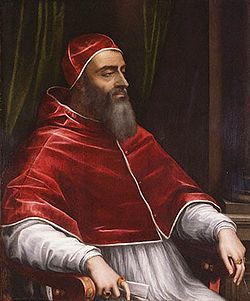 |
Clement VII Pope Clement VII Clement VII , born Giulio di Giuliano de' Medici, was a cardinal from 1513 to 1523 and was Pope from 1523 to 1534.-Early life:... Papa CLEMENS Septimus |
Giulio di Giuliano de' Medici Medici The House of Medici or Famiglia de' Medici was a political dynasty, banking family and later royal house that first began to gather prominence under Cosimo de' Medici in the Republic of Florence during the late 14th century. The family originated in the Mugello region of the Tuscan countryside,... |
Florence, Republic of Florence | 45 / 56 | Cousin of Leo X. Rome plundered by imperial troops ("Sacco di Roma Sack of Rome (1527) The Sack of Rome on 6 May 1527 was a military event carried out by the mutinous troops of Charles V, Holy Roman Emperor in Rome, then part of the Papal States... "), 1527. He forbade the divorce of Henry VIII Henry VIII of England Henry VIII was King of England from 21 April 1509 until his death. He was Lord, and later King, of Ireland, as well as continuing the nominal claim by the English monarchs to the Kingdom of France... and crowned Charles V Emperor at Bologna Bologna Bologna is the capital city of Emilia-Romagna, in the Po Valley of Northern Italy. The city lies between the Po River and the Apennine Mountains, more specifically, between the Reno River and the Savena River. Bologna is a lively and cosmopolitan Italian college city, with spectacular history,... in 1530. His niece Catherine de' Medici Catherine de' Medici Catherine de' Medici was an Italian noblewoman who was Queen consort of France from 1547 until 1559, as the wife of King Henry II of France.... was married to the future Henry II of France Henry II of France Henry II was King of France from 31 March 1547 until his death in 1559.-Early years:Henry was born in the royal Château de Saint-Germain-en-Laye, near Paris, the son of Francis I and Claude, Duchess of Brittany .His father was captured at the Battle of Pavia in 1525 by his sworn enemy,... . |
| 220 | 13 October 1534 – 10 November 1549 |
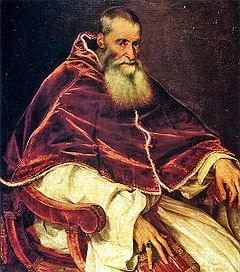 |
Paul III Pope Paul III Pope Paul III , born Alessandro Farnese, was Pope of the Roman Catholic Church from 1534 to his death in 1549. He came to the papal throne in an era following the sack of Rome in 1527 and rife with uncertainties in the Catholic Church following the Protestant Reformation... Papa PAULUS Tertius |
Alessandro Farnese | Canino, Lazio, Papal States | 66 / 81 | Opened the Council of Trent Council of Trent The Council of Trent was the 16th-century Ecumenical Council of the Roman Catholic Church. It is considered to be one of the Church's most important councils. It convened in Trent between December 13, 1545, and December 4, 1563 in twenty-five sessions for three periods... in 1545. His illegitimate son became the first Duke of Parma. |
| 221 | 7 February 1550 – 29 March 1555 |
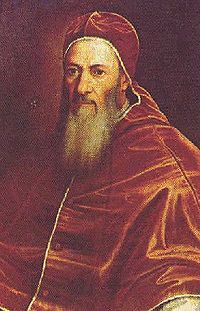 |
Julius III Pope Julius III Pope Julius III , born Giovanni Maria Ciocchi del Monte, was Pope from 7 February 1550 to 1555.... Papa IULIUS Tertius |
Giovanni Maria Ciocchi del Monte | Rome, Papal States | 62 / 67 | |
| 222 | 9 April 1555 – 30 April or 1 May 1555 (0 years, / days) |
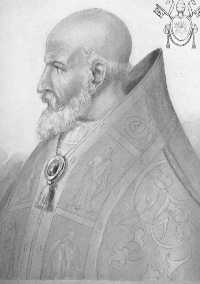 |
Marcellus II Pope Marcellus II Pope Marcellus II , born Marcello Cervini degli Spannochi, was Pope from 9 April 1555 to 1 May 1555, succeeding Pope Julius III. Before his accession as Pope he had been Cardinal-Priest of Santa Croce in Gerusalemme. He is the most recent Pope to choose to retain his birth name as his regnal name... Papa MARCELLUS Secundus |
Marcello Cervini | Montefano, Marche, Papal States | 53 / 53 | Last to use birth name as regnal name Regnal name A regnal name, or reign name, is a formal name used by some monarchs and popes during their reigns. Since medieval times, monarchs have frequently chosen to use a name different from their own personal name when they inherit a throne.... |
| 223 | 23 May 1555 – 18 August 1559 |
Paul IV Pope Paul IV Pope Paul IV, C.R. , né Giovanni Pietro Carafa, was Pope from 23 May 1555 until his death.-Early life:Giovanni Pietro Carafa was born in Capriglia Irpina, near Avellino, into a prominent noble family of Naples... , C.R. Theatines The Theatines or the Congregation of Clerks Regular of the Divine Providence are a male religious order of the Catholic Church, with the post-nominal initials "C.R."-Foundation:... Papa PAULUS Quartus |
Giovanni Pietro Carafa | Capriglia Irpina, Campania, Kingdom of Naples | 78 / 83 | ||
| 224 | 26 December 1559 – 9 December 1565 |
Pius IV Pope Pius IV Pope Pius IV , born Giovanni Angelo Medici, was Pope from 1559 to 1565. He is notable for presiding over the culmination of the Council of Trent.-Biography:... Papa PIUS Quartus |
Giovanni Angelo Medici | Milan, Duchy of Milan Duchy of Milan The Duchy of Milan , was created on the 1st of may 1395, when Gian Galeazzo Visconti, Lord of Milan, purchased a diploma for 100,000 Florins from King Wenceslaus. It was this diploma that installed, Gian Galeazzo as Duke of Milan and Count of Pavia... |
60 / 66 | Reopened the Council of Trent Council of Trent The Council of Trent was the 16th-century Ecumenical Council of the Roman Catholic Church. It is considered to be one of the Church's most important councils. It convened in Trent between December 13, 1545, and December 4, 1563 in twenty-five sessions for three periods... , 1562, it concluded its proceedings in 1563 |
|
| 225 | 7 January 1566 – 1 May 1572 |
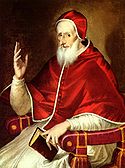 |
St Pius V Pope Pius V Pope Saint Pius V , born Antonio Ghislieri , was Pope from 1566 to 1572 and is a saint of the Catholic Church. He is chiefly notable for his role in the Council of Trent, the Counter-Reformation, and the standardization of the Roman liturgy within the Latin Church... , O.P. Dominican Order The Order of Preachers , after the 15th century more commonly known as the Dominican Order or Dominicans, is a Catholic religious order founded by Saint Dominic and approved by Pope Honorius III on 22 December 1216 in France... Papa PIUS Quintus |
Michele Ghislieri | Bosco, Duchy of Milan | 61 / 68 | Member of the Dominican Order Dominican Order The Order of Preachers , after the 15th century more commonly known as the Dominican Order or Dominicans, is a Catholic religious order founded by Saint Dominic and approved by Pope Honorius III on 22 December 1216 in France... . Excommunicated Elizabeth I of England Elizabeth I of England Elizabeth I was queen regnant of England and Ireland from 17 November 1558 until her death. Sometimes called The Virgin Queen, Gloriana, or Good Queen Bess, Elizabeth was the fifth and last monarch of the Tudor dynasty... , 1570. Victory of Lepanto 1571 |
| 226 | 13 May 1572 – 10 April 1585 |
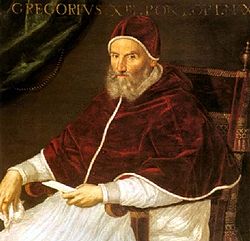 |
Gregory XIII Pope Gregory XIII Pope Gregory XIII , born Ugo Boncompagni, was Pope from 1572 to 1585. He is best known for commissioning and being the namesake for the Gregorian calendar, which remains the internationally-accepted civil calendar to this date.-Youth:He was born the son of Cristoforo Boncompagni and wife Angela... Papa GREGORIUS Tertius Decimus |
Ugo Boncompagni | Bologna, Papal States | 70 / 83 | Reform of the calendar Gregorian calendar The Gregorian calendar, also known as the Western calendar, or Christian calendar, is the internationally accepted civil calendar. It was introduced by Pope Gregory XIII, after whom the calendar was named, by a decree signed on 24 February 1582, a papal bull known by its opening words Inter... 1582 |
| 227 | 24 April 1585 – 27 August 1590 |
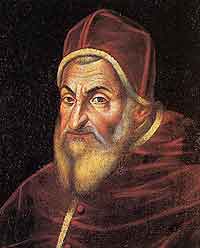 |
Sixtus V Pope Sixtus V Pope Sixtus V , born Felice Peretti di Montalto, was Pope from 1585 to 1590.-Early life:The chronicler Andrija Zmajević states that Felice's family originated from modern-day Montenegro... , O.F.M. Conv. Conventual Franciscans The Order of Friars Minor Conventual , commonly known as the Conventual Franciscans, is a branch of the order of Catholic Friars founded by Francis of Assisi in 1209.-History:... Papa XYSTUS Quintus |
Felice Peretti | Grottammare, Marche, Papal States | 63 / 68 | Member of the Conventual Franciscan Order Conventual Franciscans The Order of Friars Minor Conventual , commonly known as the Conventual Franciscans, is a branch of the order of Catholic Friars founded by Francis of Assisi in 1209.-History:... . |
| 228 | 15 September 1590 – 27 September 1590 |
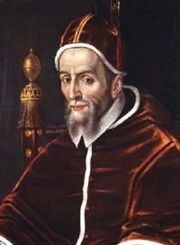 |
Urban VII Pope Urban VII Pope Urban VII , born Giovanni Battista Castagna, was Pope for thirteen days in September 1590. He was of Genoese origin, although born in Rome. He was created Cardinal-Priest of S. Marcello in 1584... Papa URBANUS Septimus |
Giovanni Battista Castagna | Rome, Papal States | 69 / 69 | Shortest-reigning pope; died before coronation. |
| 229 | 5 December 1590 – 15/16 October 1591 (0 years, / days) |
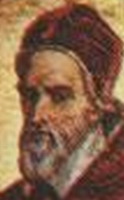 |
Gregory XIV Pope Gregory XIV Pope Gregory XIV , born Niccolò Sfondrati, was Pope from 5 December 1590 until his death in 1591.- Early career :... Papa GREGORIUS Quartus Decimus |
Niccolò Sfondrati | Somma Lombardo, Duchy of Milan | 55 / 56 | |
| 230 | 29 October 1591 – 30 December 1591 |
Innocent IX Pope Innocent IX Pope Innocent IX , born Giovanni Antonio Facchinetti, was Pope from 29 October 1591 to his death on 30 December of the same year... Papa INNOCENTIUS Nonus |
Giovanni Antonio Facchinetti | Bologna, Papal States | 72 / 72 | ||
| 231 | 30 January 1592 – 3 March 1605 |
Clement VIII Pope Clement VIII Pope Clement VIII , born Ippolito Aldobrandini, was Pope from 30 January 1592 to 3 March 1605.-Cardinal:... Papa CLEMENS Octavus |
Ippolito Aldobrandini | Fano, Marche, Papal States | 55 / 69 |
17th Century
| Numerical order | Pontificate | Portrait | Name English · Regnal (Latin) |
Personal name | Place of birth | Age at start/end of papacy | Notes |
|---|---|---|---|---|---|---|---|
| 232 | 1 April 1605 – 27 April 1605 |
Leo XI Pope Leo XI Pope Leo XI , born Alessandro Ottaviano de' Medici, was Pope from 1 April 1605 to 27 April of the same year.-Biography:... Papa LEO Undecimus |
Alessandro Ottaviano de' Medici Medici The House of Medici or Famiglia de' Medici was a political dynasty, banking family and later royal house that first began to gather prominence under Cosimo de' Medici in the Republic of Florence during the late 14th century. The family originated in the Mugello region of the Tuscan countryside,... |
Florence, Duchy of Florence Duchy of Florence The Duchy of Florence was an Italian monarchy that was centred on the city of Florence, in modern Tuscany, Italy. The duchy was founded in 1532 when Clement VII appointed his illegitimate son Alessandro de' Medici Duke of the Florentine Republic,... |
69 / 69 | ||
| 233 | 16 May 1605 – 28 January 1621 |
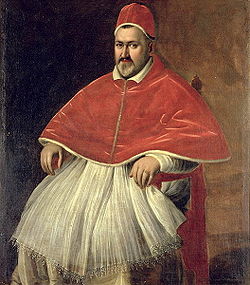 |
Paul V Pope Paul V -Theology:Paul met with Galileo Galilei in 1616 after Cardinal Bellarmine had, on his orders, warned Galileo not to hold or defend the heliocentric ideas of Copernicus. Whether there was also an order not to teach those ideas in any way has been a matter for controversy... Papa PAULUS Quintus |
Camillo Borghese Borghese Borghese is the surname of a family of Italian noble and papal background, originating as the Borghese or Borghesi in Siena, where they came to prominence in the 13th century holding offices under the commune. The head of the family, Marcantonio, moved to Rome in the 16th century and there,... |
Rome, Papal States | 52 / 68 | Known for building projects, including the facade of St Peter's Basilica. |
| 234 | 9 February 1621 – 8 July 1623 |
Gregory XV Pope Gregory XV Pope Gregory XV , born Alessandro Ludovisi, was pope from 1621, succeeding Paul V on 9 February 1621... Papa GREGORIUS Quintus Decimus |
Alessandro Ludovisi | Bologna, Papal States | 67 / 69 | ||
| 235 | 6 August 1623 – 29 July 1644 |
Urban VIII Pope Urban VIII Pope Urban VIII , born Maffeo Barberini, was pope from 1623 to 1644. He was the last pope to expand the papal territory by force of arms, and was a prominent patron of the arts and reformer of Church missions... Papa URBANUS Octavus |
Maffeo Barberini Barberini The Barberini are a family of the Italian nobility that rose to prominence in 17th century Rome. Their influence peaked with the election of Cardinal Maffeo Barberini to the papal throne in 1623, as Pope Urban VIII... |
Florence, Grand Duchy of Tuscany Grand Duchy of Tuscany The Grand Duchy of Tuscany was a central Italian monarchy that existed, with interruptions, from 1569 to 1859, replacing the Duchy of Florence. The grand duchy's capital was Florence... |
55 / 76 | Trial against Galileo Galilei Galileo Galilei Galileo Galilei , was an Italian physicist, mathematician, astronomer, and philosopher who played a major role in the Scientific Revolution. His achievements include improvements to the telescope and consequent astronomical observations and support for Copernicanism... |
|
| 236 | 15 September 1644 – 7 January 1655 |
 |
Innocent X Pope Innocent X Pope Innocent X , born Giovanni Battista Pamphilj , was Pope from 1644 to 1655. Born in Rome of a family from Gubbio in Umbria who had come to Rome during the pontificate of Pope Innocent IX, he graduated from the Collegio Romano and followed a conventional cursus honorum, following his uncle... Papa INNOCENTIUS Decimus |
Giovanni Battista Pamphilj | Rome, Papal States | 70 / 80 | |
| 237 | 7 April 1655 – 22 May 1667 |
 |
Alexander VII Pope Alexander VII Pope Alexander VII , born Fabio Chigi, was Pope from 7 April 1655, until his death.- Early life :Born in Siena, a member of the illustrious banking family of Chigi and a great-nephew of Pope Paul V , he was privately tutored and eventually received doctorates of philosophy, law, and theology from... Papa ALEXANDER Septimus |
Fabio Chigi | Siena, Grand Duchy of Tuscany Grand Duchy of Tuscany The Grand Duchy of Tuscany was a central Italian monarchy that existed, with interruptions, from 1569 to 1859, replacing the Duchy of Florence. The grand duchy's capital was Florence... |
56 / 68 | |
| 238 | 20 June 1667 – 9 December 1669 |
Clement IX Pope Clement IX Pope Clement IX , born Giulio Rospigliosi, was Pope from 1667 to 1669.-Early life:Born Giulio Rospigliosi to a noble family of Pistoia, Grand Duchy of Tuscany, he was a pupil of the Jesuits. After receiving his doctorate in philosophy at the University of Pisa, he taught theology there... Papa CLEMENS Nonus |
Giulio Rospigliosi | Pistoia, Grand Duchy of Tuscany | 67 / 69 | ||
| 239 | 29 April 1670 – 22 July 1676 |
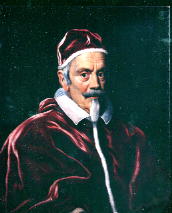 |
Clement X Pope Clement X Pope Clement X , born Emilio Bonaventura Altieri, was Pope from 29 April 1670 to 22 July 1676.-Early life:Emilio Altieri was born in Rome, the son of Lorenzo Altieri and Victoria Delphini, a Venetian lady... Papa CLEMENS Decimus |
Emilio Altieri | Rome, Papal States | 79 / 86 | |
| 240 | 21 September 1676 – 11/12 August 1689 (12 years, / days) |
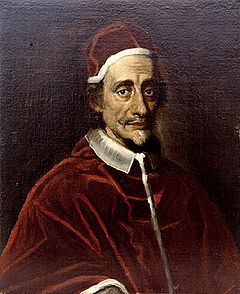 |
Bd. Innocent XI Pope Innocent XI Blessed Pope Innocent XI , born Benedetto Odescalchi, was Pope from 1676 to 1689.-Early life:Benedetto Odescalchi was born at Como in 1611 , the son of a Como nobleman, Livio Odescalchi, and Paola Castelli Giovanelli from Gandino... Papa INNOCENTIUS Undecimus |
Benedetto Odescalchi | Como, Duchy of Milan | 65 / 78 | |
| 241 | 6 October 1689 – 1 February 1691 |
 |
Alexander VIII Pope Alexander VIII Pope Alexander VIII , born Pietro Vito Ottoboni, was Pope from 1689 to 1691.-Early life:Pietro Ottoboni was born of a noble Venetian family, and was the son of Marco Ottoboni, chancellor of the Republic of Venice... Papa ALEXANDER Octavus |
Pietro Vito Ottoboni | Venice, Republic of Venice | 79 / 80 | |
| 242 | 12 July 1691 – 27 September 1700 |
Innocent XII Pope Innocent XII Pope Innocent XII , born Antonio Pignatelli, was Pope from 1691 to 1700.-Biography:He was born in Spinazzola to one of the most aristocratic families of the Kingdom of Naples, which included many Viceroys, and ministers to the crown, and was educated at the Jesuit college in Rome.In his twentieth... Papa INNOCENTIUS Duodecimus |
Antonio Pignatelli | Spinazzola, Kingdom of Naples | 76 / 85 | ||
| 243 | 23 November 1700 – 19 March 1721 |
 |
Clement XI Pope Clement XI Pope Clement XI , born Giovanni Francesco Albani, was Pope from 1700 until his death in 1721.-Early life:... Papa CLEMENS Undecimus |
Giovanni Francesco Albani | Urbino, Marche, Papal States | 51 / 71 | Chinese Rites controversy Chinese Rites controversy The Chinese Rites controversy was a dispute within the Catholic Church from the 1630s to the early 18th century about whether Chinese folk religion rites and offerings to the emperor constituted idolatry... |
18th Century
| Numerical order | Pontificate | Portrait | Name English · Regnal (Latin) |
Personal name | Place of birth | Age at start/end of papacy | Notes |
|---|---|---|---|---|---|---|---|
| 244 | 8 May 1721 – 7 March 1724 |
 |
Innocent XIII Pope Innocent XIII Pope Innocent XIII was pope from 1721 until his death.He was born Michelangelo Conti in Poli, near Rome. Like Pope Innocent III , Pope Gregory IX and Pope Alexander IV , he was a member of the family of the Conti, counts and dukes of Segni... Papa INNOCENTIUS Tertius Decimus |
Michelangelo de’ Conti Conti -People:* Bill Conti, film music director* Bruno Conti, former football player and member of the Italian national football team in 1982* Carlos Conti , Spanish comic writer* Francesco Bartolomeo Conti , Florentine composer... |
Poli, Lazio, Papal States | 65 / 68 | |
| 245 | 29 May 1724 – 21 February 1730 |
Benedict XIII Pope Benedict XIII -Footnotes:... , O.P. Dominican Order The Order of Preachers , after the 15th century more commonly known as the Dominican Order or Dominicans, is a Catholic religious order founded by Saint Dominic and approved by Pope Honorius III on 22 December 1216 in France... Papa BENEDICTUS Tertius Decimus |
Pierfrancesco Orsini | Gravina in Puglia, Kingdom of Naples | 75 / 81 | Member of the Dominican Order Dominican Order The Order of Preachers , after the 15th century more commonly known as the Dominican Order or Dominicans, is a Catholic religious order founded by Saint Dominic and approved by Pope Honorius III on 22 December 1216 in France... . |
|
| 246 | 12 July 1730 – 6 February 1740 |
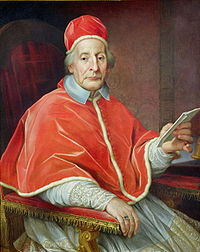 |
Clement XII Pope Clement XII Pope Clement XII , born Lorenzo Corsini, was Pope from 12 July 1730 to 6 February 1740.Born in Florence, the son of Bartolomeo Corsini, Marquis of Casigliano and his wife Isabella Strozzi, sister of the Duke of Bagnuolo, Corsini had been an aristocratic lawyer and financial manager under preceding... Papa CLEMENS Duodecimus |
Lorenzo Corsini Corsini Corsini is the name of a Florentine princely family.-History:The founder is said to be Neri Corsini, who came to prominence circa 1170. The family are likely to have originated from Corsica, during the time when the Republic of Pisa was ruling the island. Initially the family was known as Corso ... |
Florence, Grand Duchy of Tuscany | 78 / 87 | |
| 247 | 17 August 1740 – 3 May 1758 |
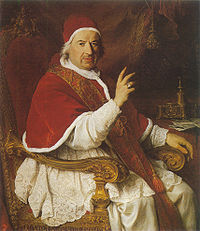 |
Benedict XIV Pope Benedict XIV Pope Benedict XIV , born Prospero Lorenzo Lambertini, was Pope from 17 August 1740 to 3 May 1758.-Life:... Papa BENEDICTUS Quartus Decimus |
Prospero Lorenzo Lambertini | Bologna, Papal States | 65 / 83 | |
| 248 | 6 July 1758 – 2 February 1769 |
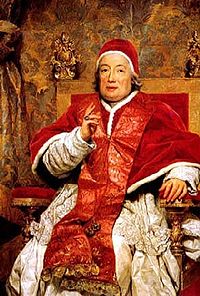 |
Clement XIII Pope Clement XIII Pope Clement XIII , born Carlo della Torre di Rezzonico, was Pope from 16 July 1758 to 2 February 1769.... Papa CLEMENS Tertius Decimus |
Carlo della Torre Rezzonico | Venice, Republic of Venice | 65 / 75 | |
| 249 | 19 May 1769 – 22 September 1774 |
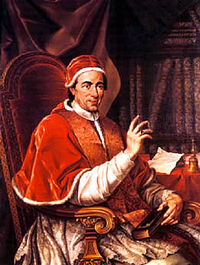 |
Clement XIV Pope Clement XIV Pope Clement XIV , born Giovanni Vincenzo Antonio Ganganelli, was Pope from 1769 to 1774. At the time of his election, he was the only Franciscan friar in the College of Cardinals.-Early life:... , O.F.M. Conv. Conventual Franciscans The Order of Friars Minor Conventual , commonly known as the Conventual Franciscans, is a branch of the order of Catholic Friars founded by Francis of Assisi in 1209.-History:... Papa CLEMENS Quartus Decimus |
Giovanni Vincenzo Antonio Ganganelli | Sant' Arcangelo di Romagna, Papal States | 63 / 68 | Member of the Conventual Franciscan Order Conventual Franciscans The Order of Friars Minor Conventual , commonly known as the Conventual Franciscans, is a branch of the order of Catholic Friars founded by Francis of Assisi in 1209.-History:... . Suppressed the Jesuit Order Society of Jesus The Society of Jesus is a Catholic male religious order that follows the teachings of the Catholic Church. The members are called Jesuits, and are also known colloquially as "God's Army" and as "The Company," these being references to founder Ignatius of Loyola's military background and a... . |
| 250 | 15 February 1775 – 29 August 1799 |
 |
Pius VI Pope Pius VI Pope Pius VI , born Count Giovanni Angelo Braschi, was Pope from 1775 to 1799.-Early years:Braschi was born in Cesena... Papa PIUS Sextus |
Count Giovanni Angelo Braschi | Cesena, Papal States | 57 / 81 | Condemned the French Revolution French Revolution The French Revolution , sometimes distinguished as the 'Great French Revolution' , was a period of radical social and political upheaval in France and Europe. The absolute monarchy that had ruled France for centuries collapsed in three years... and was expelled from the Papal States by French troops from 1798 until his death. |
| 251 | 14 March 1800 – 20 August 1823 |
 |
Pius VII Pope Pius VII Pope Pius VII , born Barnaba Niccolò Maria Luigi Chiaramonti, was a monk, theologian and bishop, who reigned as Pope from 14 March 1800 to 20 August 1823.-Early life:... , O.S.B. Order of Saint Benedict The Order of Saint Benedict is a Roman Catholic religious order of independent monastic communities that observe the Rule of St. Benedict. Within the order, each individual community maintains its own autonomy, while the organization as a whole exists to represent their mutual interests... Papa PIUS Septimus |
Count Barnaba Niccolò Maria Luigi Chiaramonti | Cesena, Papal States | 57 / 81 | Member of the Order of Saint Benedict Order of Saint Benedict The Order of Saint Benedict is a Roman Catholic religious order of independent monastic communities that observe the Rule of St. Benedict. Within the order, each individual community maintains its own autonomy, while the organization as a whole exists to represent their mutual interests... . Present at Napoleon's Napoleon I of France Napoleon Bonaparte was a French military and political leader during the latter stages of the French Revolution.As Napoleon I, he was Emperor of the French from 1804 to 1815... coronation as Emperor of the French. Temporarily expelled from the Papal States by the French between 1809 and 1814. |
19th Century
| Numerical order | Pontificate | Portrait | Name English · Regnal (Latin) |
Personal name | Place of birth | Age at start/end of papacy | Notes |
|---|---|---|---|---|---|---|---|
| 252 | 28 September 1823 – 10 February 1829 |
Leo XII Pope Leo XII Pope Leo XII , born Annibale Francesco Clemente Melchiore Girolamo Nicola Sermattei della Genga, was Pope from 1823 to 1829.-Life:... Papa LEO Duodecimus |
Count Annibale Francesco Clemente Melchiore Girolamo Nicola Sermattei della Genga | Genga or Spoleto, Papal States | 63 / 68 | ||
| 253 | 31 March 1829 – 1 December 1830 |
Pius VIII Pope Pius VIII Pope Pius VIII , born Francesco Saverio Castiglioni was Pope in 1829 and 1830.-Biography:He was born in Cingoli, Marche, the son of Count Ottavio Castiglioni and his wife Sanzia Ghislieri. He studied Canon law and, in 1800 became bishop of Montalto... Papa PIUS Octavus |
Francesco Saverio Castiglioni | Cingoli, Marche, Papal States | 67 / 69 | ||
| 254 | 2 February 1831 – 1 June 1846 |
 |
Gregory XVI Pope Gregory XVI Pope Gregory XVI , born Bartolomeo Alberto Cappellari, named Mauro as a member of the religious order of the Camaldolese, was Pope of the Catholic Church from 1831 to 1846... , O.S.B. Cam. Camaldolese The Camaldolese monks and nuns are part of the Benedictine family of monastic communities which follow the way of life outlined in the Rule of St. Benedict, written in the 6th century... Papa GREGORIUS Sextus Decimus |
Bartolomeo Alberto Cappellari | Belluno, Republic of Venice | 65 / 80 | Member of the Camaldolese Order Camaldolese The Camaldolese monks and nuns are part of the Benedictine family of monastic communities which follow the way of life outlined in the Rule of St. Benedict, written in the 6th century... . The last non-bishop to be elected |
| 255 | 16 June 1846 – 7 February 1878 |
 |
Bd. Pius IX Pope Pius IX Blessed Pope Pius IX , born Giovanni Maria Mastai-Ferretti, was the longest-reigning elected Pope in the history of the Catholic Church, serving from 16 June 1846 until his death, a period of nearly 32 years. During his pontificate, he convened the First Vatican Council in 1869, which decreed papal... , O.F.S. Secular Franciscan Order thumb|rigth|Lapel pin of Secular Franciscan Order.The Secular Franciscan Order is a community of Catholic men and women, of any of the Rites in communion with Rome , in the world who seek to pattern their lives after Christ in the spirit of St. Francis of Assisi. Secular Franciscans are... Papa PIUS Nonus |
Count Giovanni Maria Mastai-Ferretti | Senigallia, Marche, Papal States | 54 / 85 | Opened First Vatican Council First Vatican Council The First Vatican Council was convoked by Pope Pius IX on 29 June 1868, after a period of planning and preparation that began on 6 December 1864. This twentieth ecumenical council of the Roman Catholic Church, held three centuries after the Council of Trent, opened on 8 December 1869 and adjourned... ; lost the Papal States Papal States The Papal State, State of the Church, or Pontifical States were among the major historical states of Italy from roughly the 6th century until the Italian peninsula was unified in 1861 by the Kingdom of Piedmont-Sardinia .The Papal States comprised territories under... to Italy. Longest serving pope in history (see note on St Peter.) |
| 256 | 20 February 1878 – 20 July 1903 |
 |
Leo XIII Pope Leo XIII Pope Leo XIII , born Vincenzo Gioacchino Raffaele Luigi Pecci to an Italian comital family, was the 256th Pope of the Roman Catholic Church, reigning from 1878 to 1903... , O.F.S. Secular Franciscan Order thumb|rigth|Lapel pin of Secular Franciscan Order.The Secular Franciscan Order is a community of Catholic men and women, of any of the Rites in communion with Rome , in the world who seek to pattern their lives after Christ in the spirit of St. Francis of Assisi. Secular Franciscans are... Papa LEO Tertius Decimus |
Gioacchino Vincenzo Raffaele Luigi Pecci | Carpineto Romano, Rome département, French Empire (now Italy) | 67 / 93 | Issued the encyclical on social teaching, Rerum Novarum Rerum Novarum Rerum Novarum is an encyclical issued by Pope Leo XIII on May 15, 1891. It was an open letter, passed to all Catholic bishops, that addressed the condition of the working classes. The encyclical is entitled: “Rights and Duties of Capital and Labour”... (On Capital and Labor) and supported Christian democracy Christian Democracy Christian democracy is a political ideology that seeks to apply Christian principles to public policy. It emerged in nineteenth-century Europe under the influence of conservatism and Catholic social teaching... as against communism; the third-longest reigning pope after Pius IX and John Paul II. |
20th Century
| Numerical order | Pontificate | Portrait | Name English · Regnal (Latin) |
Personal name | Place of birth | Age at start/end of papacy | Notes |
|---|---|---|---|---|---|---|---|
| 257 | 4 August 1903 – 20 August 1914 |
St Pius X Pope Pius X Pope Saint Pius X , born Giuseppe Melchiorre Sarto, was the 257th Pope of the Catholic Church, serving from 1903 to 1914. He was the first pope since Pope Pius V to be canonized. Pius X rejected modernist interpretations of Catholic doctrine, promoting traditional devotional practices and orthodox... Papa PIUS Decimus |
Giuseppe Melchiorre Sarto | Riese, Lombardy-Venetia, Austrian Empire | 68 / 79 | Encouraged and expanded reception of Holy Communion. Most recent pope to be canonized. | |
| 258 | 3 September 1914 – 22 January 1922 |
 |
Benedict XV Pope Benedict XV Pope Benedict XV , born Giacomo Paolo Giovanni Battista della Chiesa, reigned as Pope from 3 September 1914 to 22 January 1922... Papa BENEDICTUS Quintus Decimus |
Giacomo Paolo Giovanni Battista della Chiesa | Genoa, Kingdom of Sardinia | 59 / 67 | Credited for intervening for peace during World War I. Remembered by Pope Benedict XVI Pope Benedict XVI Benedict XVI is the 265th and current Pope, by virtue of his office of Bishop of Rome, the Sovereign of the Vatican City State and the leader of the Catholic Church as well as the other 22 sui iuris Eastern Catholic Churches in full communion with the Holy See... as "prophet of peace". |
| 259 | 6 February 1922 – 10 February 1939 |
Pius XI Pope Pius XI Pope Pius XI , born Ambrogio Damiano Achille Ratti, was Pope from 6 February 1922, and sovereign of Vatican City from its creation as an independent state on 11 February 1929 until his death on 10 February 1939... Papa PIUS Undecimus |
Achille Ambrogio Damiano Ratti | Desio, Lombardy-Venetia, Austrian Empire | 64 / 81 | Signed the Lateran Treaty with Italy, establishing the Vatican City Vatican City Vatican City , or Vatican City State, in Italian officially Stato della Città del Vaticano , which translates literally as State of the City of the Vatican, is a landlocked sovereign city-state whose territory consists of a walled enclave within the city of Rome, Italy. It has an area of... as a sovereign state. |
|
| 260 | 2 March 1939 – 9 October 1958 |
Ven. Pius XII Pope Pius XII The Venerable Pope Pius XII , born Eugenio Maria Giuseppe Giovanni Pacelli , reigned as Pope, head of the Catholic Church and sovereign of Vatican City State, from 2 March 1939 until his death in 1958.... Papa PIUS Duodecimus |
Eugenio Maria Giuseppe Giovanni Pacelli | Rome, Italy | 63 / 82 | Invoked papal infallibility in encyclical Munificentissimus Deus Munificentissimus Deus Munificentissimus Deus is the name of an Apostolic constitution written by Pope Pius XII. It defines ex cathedra the dogma of the Assumption of the Blessed Virgin Mary. It was the first ex-cathedra infallible statement since the official ruling on papal infallibility was made at the First Vatican... . |
|
| 261 | 28 October 1958 – 3 June 1963 |
Bd Beatification Beatification is a recognition accorded by the Catholic Church of a dead person's entrance into Heaven and capacity to intercede on behalf of individuals who pray in his or her name . Beatification is the third of the four steps in the canonization process... . John XXIII Pope John XXIII -Papal election:Following the death of Pope Pius XII in 1958, Roncalli was elected Pope, to his great surprise. He had even arrived in the Vatican with a return train ticket to Venice. Many had considered Giovanni Battista Montini, Archbishop of Milan, a possible candidate, but, although archbishop... Papa IOANNES Vicesimus Tertius |
Angelo Giuseppe Roncalli | Sotto il Monte, Bergamo, Italy | 76 / 81 | Opened Second Vatican Council Second Vatican Council The Second Vatican Council addressed relations between the Roman Catholic Church and the modern world. It was the twenty-first Ecumenical Council of the Catholic Church and the second to be held at St. Peter's Basilica in the Vatican. It opened under Pope John XXIII on 11 October 1962 and closed... ; sometimes called "Good Pope John". |
|
| 262 | 21 June 1963 – 6 August 1978 |
Servant of God Servant of God Servant of God is a title given to individuals by various religions, but in general the phrase is used to describe a person believed to be pious in his or her faith tradition. In the Catholic Church, it designates someone who is being investigated by the Church for possibly being recognized as a... Paul VI Pope Paul VI Paul VI , born Giovanni Battista Enrico Antonio Maria Montini , reigned as Pope of the Catholic Church from 21 June 1963 until his death on 6 August 1978. Succeeding Pope John XXIII, who had convened the Second Vatican Council, he decided to continue it... Papa PAULUS Sextus |
Giovanni Battista Enrico Antonio Maria Montini | Concesio, Brescia, Italy | 65 / 80 | The last pope to be crowned with the Papal Tiara Papal Tiara The Papal Tiara, also known incorrectly as the Triple Tiara, or in Latin as the Triregnum, in Italian as the Triregno and as the Trirègne in French, is the three-tiered jewelled papal crown, supposedly of Byzantine and Persian origin, that is a prominent symbol of the papacy... . First pope to travel to the United States. Concluded Second Vatican Council Second Vatican Council The Second Vatican Council addressed relations between the Roman Catholic Church and the modern world. It was the twenty-first Ecumenical Council of the Catholic Church and the second to be held at St. Peter's Basilica in the Vatican. It opened under Pope John XXIII on 11 October 1962 and closed... . |
|
| >26 August 1978 | Servant of God John Paul I Pope John Paul I John Paul I , born Albino Luciani, , reigned as Pope of the Catholic Church and as Sovereign of Vatican City from 26 August 1978 until his death 33 days later. His reign is among the shortest in papal history, resulting in the most recent Year of Three Popes... Papa IOANNES PAULUS Primus |
Albino Luciani | Forno di Canale Canale d'Agordo Canale d'Agordo is a town and comune in the province of Belluno, in the region of Veneto, northern Italy. It has 1,230 inhabitants... , Veneto, Italy |
65 / 65 | First pope to use 'the First' in regnal name. First pope with two names, for his two immediate predecessors. Died early into a charismatic reign. | ||
| 264 | 16 October 1978 – 2 April 2005 |
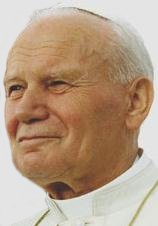 |
Bd. John Paul II Pope John Paul II Blessed Pope John Paul II , born Karol Józef Wojtyła , reigned as Pope of the Catholic Church and Sovereign of Vatican City from 16 October 1978 until his death on 2 April 2005, at of age. His was the second-longest documented pontificate, which lasted ; only Pope Pius IX ... Papa IOANNES PAULUS Secundus |
Karol Józef Wojtyła | Wadowice Wadowice Wadowice is a town in southern Poland, 50 km from Kraków with 19,200 inhabitants , situated on the Skawa river, confluence of Vistula, in the eastern part of Silesian Plateau... , Poland Poland Poland , officially the Republic of Poland , is a country in Central Europe bordered by Germany to the west; the Czech Republic and Slovakia to the south; Ukraine, Belarus and Lithuania to the east; and the Baltic Sea and Kaliningrad Oblast, a Russian exclave, to the north... |
58 / 84 | First Polish Poland Poland , officially the Republic of Poland , is a country in Central Europe bordered by Germany to the west; the Czech Republic and Slovakia to the south; Ukraine, Belarus and Lithuania to the east; and the Baltic Sea and Kaliningrad Oblast, a Russian exclave, to the north... pope and first non-Italian pope in 455 years. Canonized more saints than all predecessors. Traveled extensively. Second longest known reign after Pius IX (1846–1878; see note on St Peter); recently beatified by Pope Benedict XVI. |
21st Century
| Numerical order | Pontificate | Portrait | Name English · Regnal (Latin) |
Personal name | Place of birth | Age at start/end of papacy | Notes |
|---|---|---|---|---|---|---|---|
| 265 | 19 April 2005 – present |
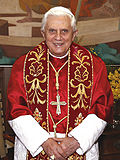 |
Benedict XVI Pope Benedict XVI Benedict XVI is the 265th and current Pope, by virtue of his office of Bishop of Rome, the Sovereign of the Vatican City State and the leader of the Catholic Church as well as the other 22 sui iuris Eastern Catholic Churches in full communion with the Holy See... Papa BENEDICTUS Sextus Decimus |
Joseph Alois Ratzinger | Marktl am Inn Marktl am Inn Marktl, or often unofficially called Marktl am Inn , is a village and historic market municipality in the state of Bavaria, Germany, near the Austrian border, in the Altötting district of Upper Bavaria. The most notable neighbouring town is Altötting... , Bavaria Bavaria Bavaria, formally the Free State of Bavaria is a state of Germany, located in the southeast of Germany. With an area of , it is the largest state by area, forming almost 20% of the total land area of Germany... , Germany |
78 / - | First German pope since Stephen IX Pope Stephen IX Pope Stephen IX was Pope from August 3, 1057 to March 1058.His baptismal name was Frederick of Lorraine , and he was a younger brother of Godfrey III, Duke of Lower Lorraine, who, as Marquis of Tuscany , played a prominent part in the politics of the period.Frederick, who had... in 1057. Oldest to become pope since Clement XII in 1730. |
Religious orders
33 popes have been members of religious orders. These have included:- BenedictineBenedictineBenedictine refers to the spirituality and consecrated life in accordance with the Rule of St Benedict, written by Benedict of Nursia in the sixth century for the cenobitic communities he founded in central Italy. The most notable of these is Monte Cassino, the first monastery founded by Benedict...
s (17):-- Gregory I, Boniface IV, Adeodatus II, Leo IV, John IX, Leo VII, Stephen IX, Gregory VII, Victor III, Urban II, Paschal II, Gelasius II, Celestine V, Clement VI, Urban V, Pius VII
- and including CamaldoleseCamaldoleseThe Camaldolese monks and nuns are part of the Benedictine family of monastic communities which follow the way of life outlined in the Rule of St. Benedict, written in the 6th century...
(1):-- Gregory XVI
- AugustiniansAugustiniansThe term Augustinians, named after Saint Augustine of Hippo , applies to two separate and unrelated types of Catholic religious orders:...
(5):-- Eugene IV
- and including Canons RegularCanons RegularCanons Regular are members of certain bodies of Canons living in community under the Augustinian Rule , and sharing their property in common...
(5):-- Honorius II, Innocent II, Lucius II, Gregory VIII, Adrian IV
- DominicansDominican OrderThe Order of Preachers , after the 15th century more commonly known as the Dominican Order or Dominicans, is a Catholic religious order founded by Saint Dominic and approved by Pope Honorius III on 22 December 1216 in France...
(4):-- Innocent V, Benedict XI, Pius V, Benedict XIII
- FranciscanFranciscanMost Franciscans are members of Roman Catholic religious orders founded by Saint Francis of Assisi. Besides Roman Catholic communities, there are also Old Catholic, Anglican, Lutheran, ecumenical and Non-denominational Franciscan communities....
s (4):-- Nicholas IV, Sixtus IV
- and including Conventual FranciscansConventual FranciscansThe Order of Friars Minor Conventual , commonly known as the Conventual Franciscans, is a branch of the order of Catholic Friars founded by Francis of Assisi in 1209.-History:...
(2):-- Sixtus V, Clement XIV
- Cistercians (2):-
- Eugene III, Benedict XII
See also
- History of the PapacyHistory of the PapacyThe history of the papacy, the office held by the Pope as head of the Catholic Church, spans from the time of Saint Peter to present day.During the Early Church, the bishops of Rome enjoyed no temporal power until the time of Constantine...
- List of antipopes
- List of popes sorted alphabetically
- Liber PontificalisLiber PontificalisThe Liber Pontificalis is a book of biographies of popes from Saint Peter until the 15th century. The original publication of the Liber Pontificalis stopped with Pope Adrian II or Pope Stephen V , but it was later supplemented in a different style until Pope Eugene IV and then Pope Pius II...
- List of sexually active popes
- Prophecy of the PopesProphecy of the PopesThe Prophecy of the Popes, attributed to Saint Malachy, is a list of 112 short phrases in Latin. They purport to describe each of the Roman Catholic popes , beginning with Pope Celestine II and concluding with the successor of current pope Benedict XVI, a pope described in the prophecy as "Peter...
- List of popes from the Borgia family
- List of popes from the Medici family
- Pope John (numbering)Pope John (numbering)The numbering of Popes John do not occur in strict numerical order. These discrepancies are due in part to a now discounted belief in another Pope John between John XIV and John XV, and the antipapacy of John XVI.-References:...
General
- The Early Papacy: To the Synod of Chalcedon in 451, Adrian Fortescue, Ignatius Press, 2008.
- The Oxford Dictionary of Popes, John N.D. Kelly, Oxford University Press, 1986.
- Catholicism, Henri de Lubac, Ignatius Press, 1988.
- Rome and the Eastern Churches, Aidan Nichols, Ignatius Press, 2010.
- I Papi. Venti secoli di storia, Pontificia Amministrazione della Patriarcale Basilica di San Paolo, Libreria Editrice Vaticana, 2002.
- Rome Sweet Home, Scott Hahn, Ignatius Press, 1993.
- Enciclopedia dei Papi, AA.VV., Istituto dell'Enciclopedia italiana, 2000.

